User Manual of Universal HD DVR, If HD DVR does not work normally because of hitting on the hard object, please contact the authorized dealer for repair or replacement.
Please carefully read the following safety instruction so as to avoid personal injuries and prevent the equipment and other connection devices from being damaged.
- Power sources. Please use the power supply attached or specified by the manufacturer Never operate the equipment by unspecified power supply.
- Never push objects of any kind through openings of HD DVR.
Never push objects of any kind through openings of HD DVR so as to avoid electric shock or other accidents.
- Do not put the equipment in the dusty field.
Do not put the equipment in the dusty field.
- Do not place the equipment under rain or humid environment
Do not place the equipment under humid environment like basement. If the equipment is in contact with water, please unplug the power cable and immediately contact your local dealer.
- Keep the surface of the equipment clean and dry
Use soft damp cloth to clean the outer case of HD DVR (do not use liquid aerosol cleaners)
- Do not operate if any problems are found
If there are any strange smell or sound, unplug the power cable and contact the authorized dealer or service center.
- Do not try to remove the upper cover
Warning: Do not remove the cap of HD DVR so as to avoid electric shock.
- Handle with care
If HD DVR does not work normally because of hitting on the hard object, please contact the authorized dealer for repair or replacement.
- Use standard lithium battery
Note: Use the batteries attached or specified by the manufacturer. After cutting off the power supply, if the system clock cannot continue to work, please replace the standard 3V lithium battery on the main board.
Warning: Turn off HD DVR before replacing the batteries, or you may be suffered from serious electric shock. Please properly dispose of the used batteries.
- Put the equipment in a place with good ventilation.
The HD DVR system includes HDD, which produces large amount of heat during operation. As a result, do not block the ventilation openings(on the top, bottom, both sides and the reverse side) for cooling the system during operation. Install or put the equipment in the place with good ventilation.
- The attached power adapter can only be used for 1 set of HD DVR.
Do not connect more equipment, or HD DVR may be restarted repeatedly because of insufficient power.
- Prevent the equipment from water dropping or splashing.
Do not place objects containing water, such as flower vase, on the equipment.
User Manual of Universal HD DVR
Read More :
HD DVR Front Panel, as shown below:

Figure 1-1 Front panel of 1HDD/2HDD case

Figure 1-2 Front panel of 4HDD/8HDD case
Note:
> All above drawings are for reference only.
HD DVR Rear Panel, as shown below:

Figure 1-3 Rear panel of 1 HDD case

Figure 1-4 Rear panel of 2 HDD case

Figure 1-5 Rear panel of 4HDD/8HDD case
Note:
> All above drawings are for reference only.
A regular 3-button (Left/Right/Scroll-wheel) USB mouse can also be used with this HD DVR. To use a USB mouse: Plug USB mouse into one of the USB interfaces on the front or rear panel of the HD DVR. The mouse should automatically be detected.
| Items | Action | Description |
| Left-Click | Single-Click | Live view: Select channel and show the quick set menu.
Menu: Select and enter. |
| Double-Click | Live view: Switch between single-screen and multi-screen. | |
| Click and Drag | Live view: Drag channel/time bar.
Alarm: Select target area. Digital zoom-in: Drag and select target area. |
|
| Right-Click | Single-Click | Live view: Show main menu.
Menu: Exit current menu to upper level menu. |
| Scroll-Wheel | Scrolling up | Menu: change the settings value to high |
| Scrolling down | Menu: change the settings value to low |
Table 1-1 Key functions of USB Mouse Operation
Note:
> If in a rare case that the mouse is not detected, the possible reason may be that the two devices are not compatible, please refer to the recommended the device list from your provider.

Figure 1-6 Soft keyboard (1)
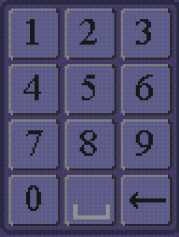
Figure 1-6 Soft keyboard (2)
| Icon | Description |
| Symbols | |
| 0 9 | Number |
| Enter | Exit |
| 1 1 | Space |
| ■ zl | English letter |
| Backspace | |
| Shift | | Lowercase/Uppercase |
Table1-2 Description of the Soft Keyboard Icons
Before installing Hard Disk (HDD), please make sure the power is disconnected with the HD DVR. Each capacity of Hard Disk please refer to HD DVR’s specifications. HD DVR without Hard Disk still support monitoring, but no recording or playback. If you correctly install the Hard Disk, the HDD indicator will blink regularly when the HD DVR is on work.
- Loosen the screws in back and right/left
2. Place the HDD in the machine
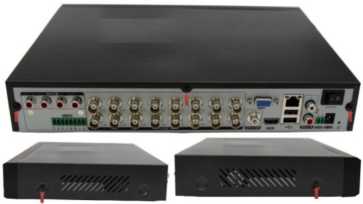
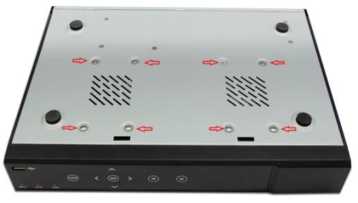
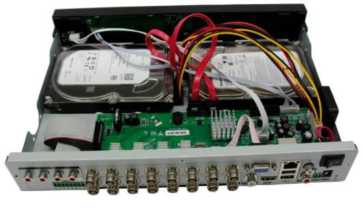
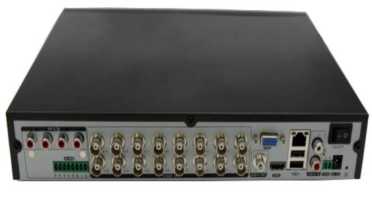
side to open the cover.
and tight the screws.
3. Connect the power and data cables.
4. Install the cover and screws.
Note:
> If user requires higher performance HDD, it is strongly recommended to use special hard drive for security and protection.
> Please do not take out hard drive when HD DVR is running!
We recommend you connect HD DVR with other monitoring devices like picture 2-4-1 or 2-4-2.
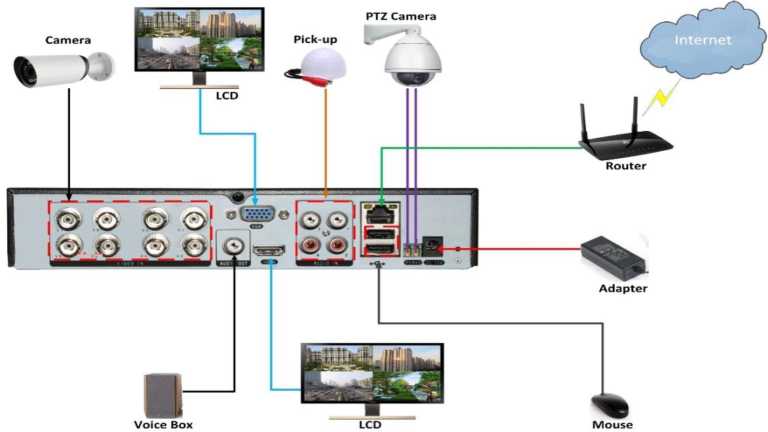
Figure 2-4-1Device Connection
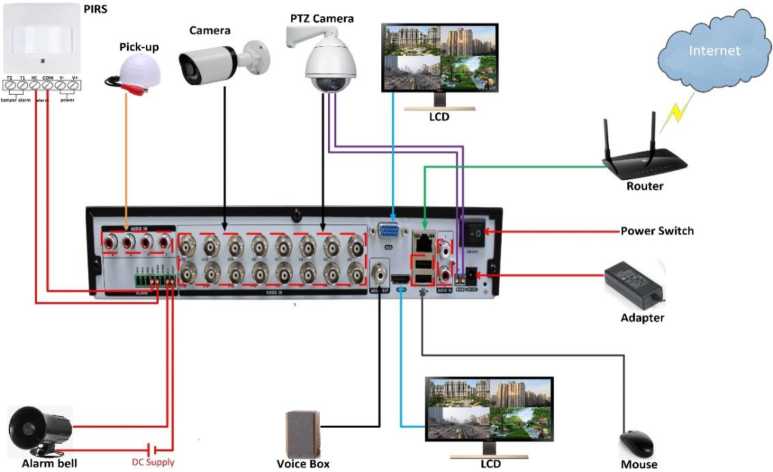
Figure 2-4-2Device Connection
Transmit signals of AHD camera and IP camera to HD DVR by the network cable, and connect VGA port and HDMI port for output.
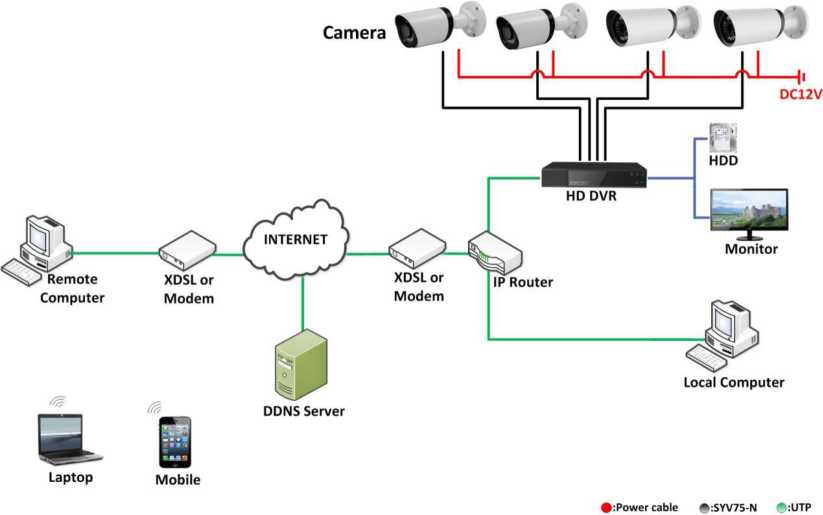
Figure 2-4 Device Connection
Please use attached power adapter to connect HD DVR. Before power on, make sure the cables on the audio I/O ports and network port are well connected.
Proper startup and shutdown procedures are crucial to expanding the life of the HD DVR, please check that the voltage of the extra power supply is the same with the HD DVR’s requirement, and the ground connection is working properly.
- Starting up the HD DVR
Plug the power supply and turn on the power supply switch(if there is one). Power supply indicator blinking indicates turning on the video recorder. After the startup you will hear a beep. The default setting of video output is multiple-window output mode. If the startup time is within the recording schedule time, the timing video recording function will start up automatically. Then the recording indicator of corresponding channel will be blinking and the HD DVR is working normally. When operate a username and password is needed, the default username is “admin” and the password is 1234567u.
- Shutting down the HD DVR
Click right of the mouse on the live view interface and choose “Main Menu>Shutdown”, then click ok button, shown as figure 3-1.
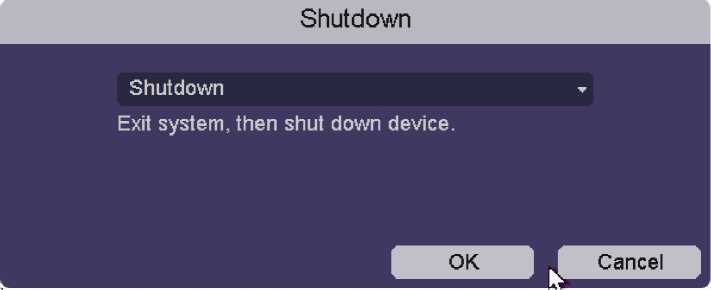
Figure 3-1 Shutdown Menu
By default, the Startup Wizard starts once the HD DVR has loaded, as shown in Figure 3-2.
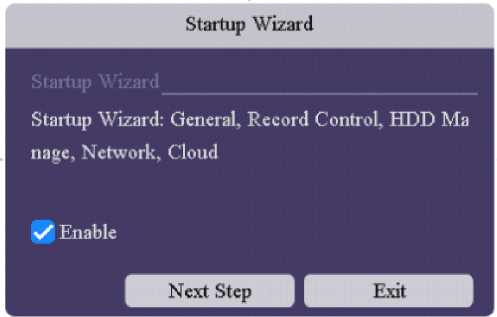
Figure 3-2 Startup Wizard
Operating the Startup Wizard:
- The Startup Wizard can walk you through some important settings of the HD DVR. If you don’t want to use the Startup Wizard at that moment, click the exit button. You can also choose to use the Startup Wizard next time by leaving the “enable” checkbox checked.
- Click Next Step button to enter the general settings window, as shown in figure 3-3.
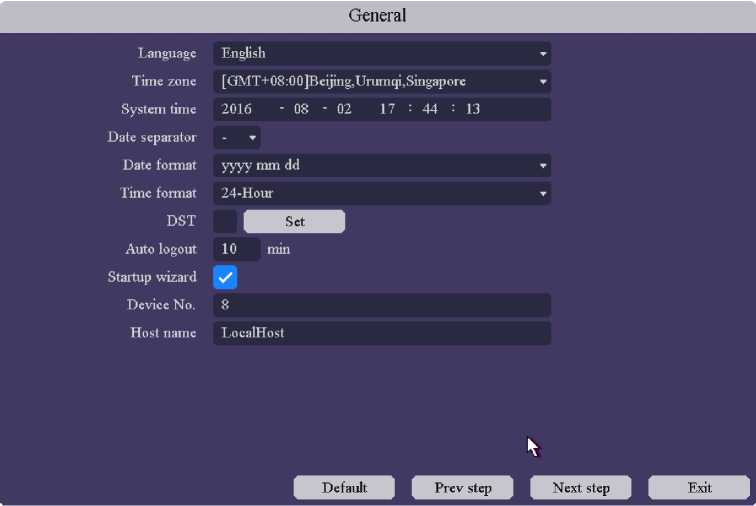
Figure 3-3 General settings
- After the general settings, click Next Step button which takes you back to the record control Setup Wizard window, as shown in figure 3-4.
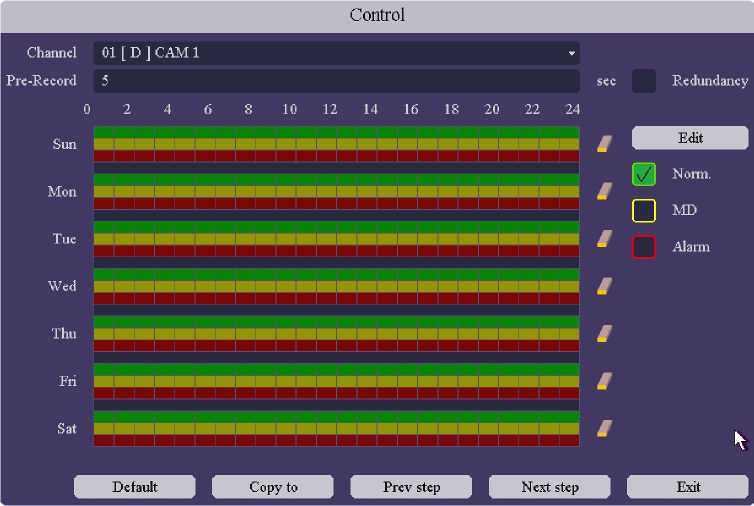
Figure 3-4 Record control settings
- After the record control settings, click Next Step button which takes you to the HDD
Manage Setup Wizard window, as shown in figure 3-5.
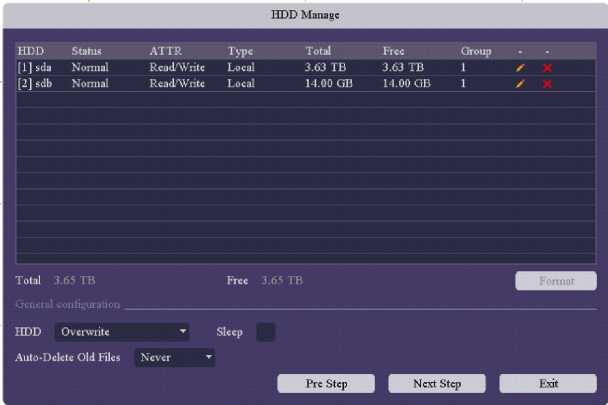
Figure 3-5 HDD Manage of Wizard
- Click Next button. You enter the Network Setup Wizard window, as shown in figure 3-6.
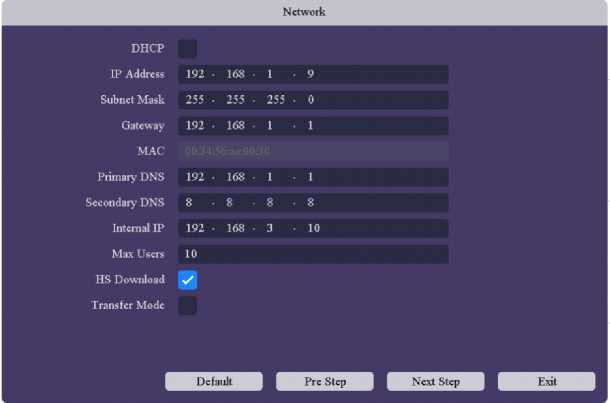
Figure 3-6 Network of Wizard
- Click Next button after you configured the network parameters, you enter the cloud
service Setup Wizard window, as shown in figure 3-7.
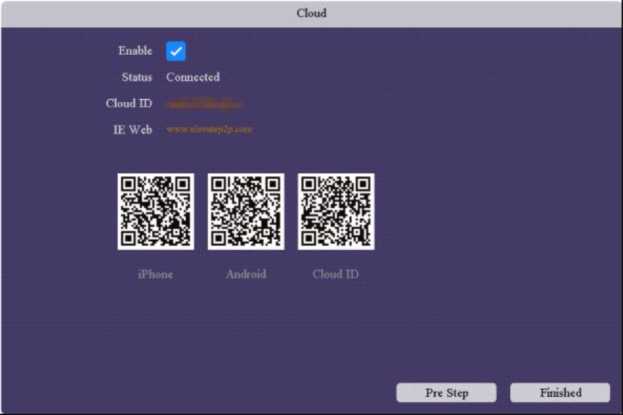
Figure 3-7 Cloud of Wizard
• User Login
If HD DVR has logged out, you must login the device before operating the menu and other functions.
Steps:
- Select the User Name in the dropdown list.
- Input Password.
- Click OK to log in.
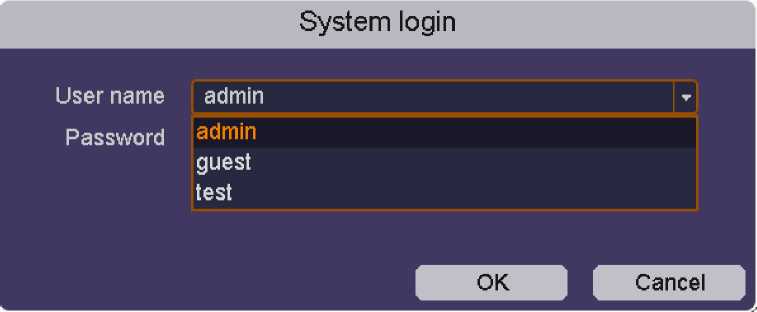
Figure 3-8Switch user
Note:
> In the Login dialog box, if you enter the wrong password 7 times, the current user account will blockedfor 60 seconds and you will hear a beep consist about 5s.
• User Logout
After logging out, the monitor turns to the live view mode and if you want to perform any operations, you need to enter user name and password log in again.
Steps:
1. Enter the Shutdown menu. Go to Main Menu > Shutdown
2. Select logout and click ok button.
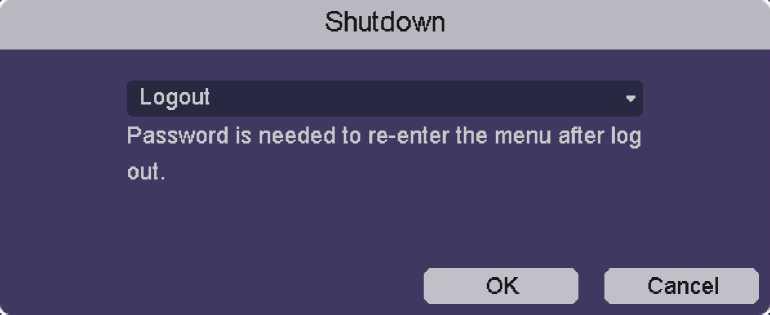
Figure 3-9Shutdown
Note:
> After you have logged out the system, menu operation on the screen is invalid. It is required to input a user name and password to unlock the system.
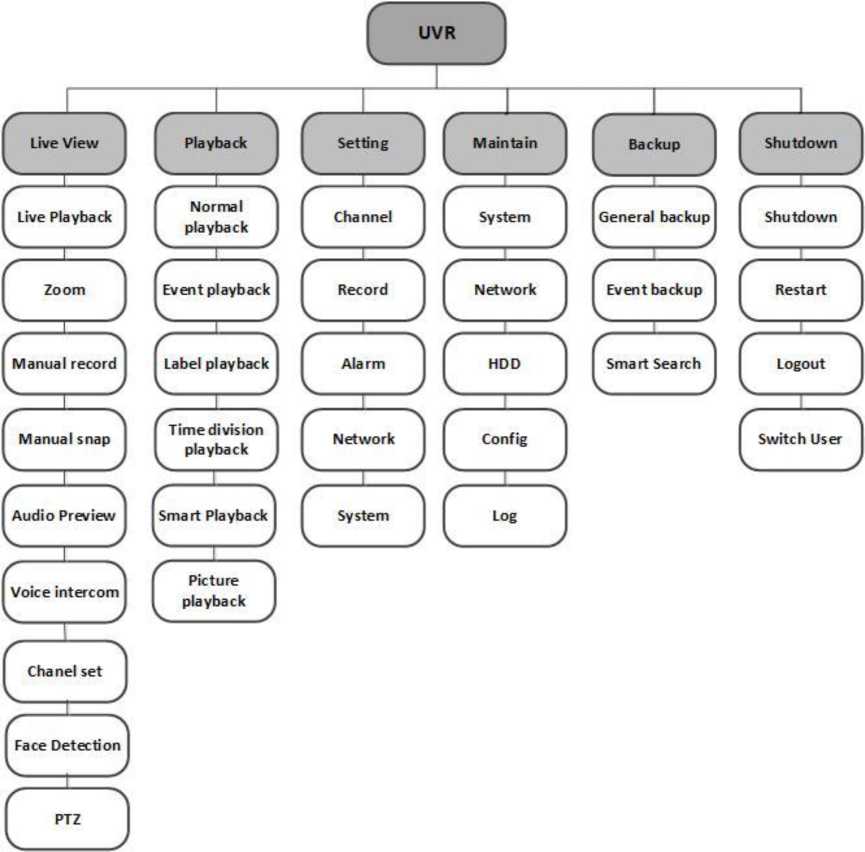
Figure 4-1 HD DVR Menu Guide
Live view shows you the video image getting from each camera in real time. The HD DVR automatically enters Live View mode when powered on, as shown in figure 4-2.
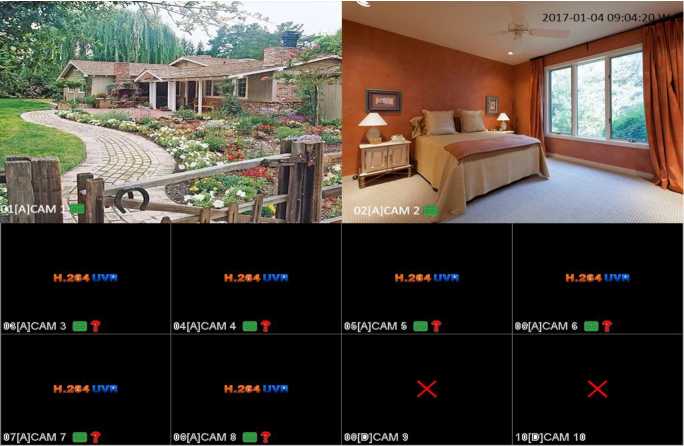
Figure 4-2 live view interface
On live view screen, click on the channel ” + “Button to enter the channel management interface HD DVR Automatically search for network segment IPC , And then select the IPC Click Add to.
Note:
> The transmission signals of IP camera to HD DVR is main stream under single or four screen s live view, and it is extra stream under multi- screen live view.
• Live View Icons
In the live view mode, there are icons at the upper-left of the screen for each channel, showing the status of the record and alarm in the channel, so that you can know whether the channel is recorded, or whether there are alarm source as soon as possible.
| Items | Description |
| ^=1 Recording state | Shown on channel preview when recording. |
| Alarm detect | Shown on channel preview when alarm triggered. |
| Video lost | Shown on channel preview when video lost. |
| a
Camera lock |
No preview authority. |
Table4-1 Live view Icons
4.2.2 Operations in Live View Mode
In live view mode, there are many functions provided. The functions are listed below.
- Single Screen: showing only one screen on the monitor.
- Multi-screen: showing multiple screens on the monitor simultaneously.
- Tour: the screen is auto switched to the next one. And you must set the dwell time for each screen on the configuration menu before enabling the tour.
- Start Recording: continuous record and motion detection record are supported.
- Add IP Camera: the shortcut to the IP camera management interface.
- Playback: playback the recorded videos for current day.
On the screen of each channel, there is a quick setting toolbar which shows when you move the arrow of mouse to the top of image.

Figure 4-3 Quick Setting Toolbar in channel image
| Items | Description | ||
| Instant Replay | In the preview channel window interface within ten minutes of video for playback. | ||
| ■■□Zoom | Displays the selected channel in full screen, and displays a small window in the right corner of the area you want to zoom. | ||
| n
■■■Manual Record |
Quick switch video mode for this channel (only in manual and stop mode switching). | ||
| ^^Manual Snap | This channel the display resolution of the images that are captured in real time. | ||
| Audio Preview | To listen Open channel monitor. | ||
| E3
■■Voice Intercom |
Open-channel intercom functions, support IPC and web and mobile client to talk. | ||
| ^^Channel Set | Quickly enter and locate a channel management interface. | ||
| ^^^Face Detection | Quickly enable a blank area in preview to show the people’s face detected by the camera. (As shown in Figure 4-3-1) | ||
| «o> | PTZ | Quickly enter PTZ control interface. | |
Table 4-2 Description of the Quick Setting Toolbar
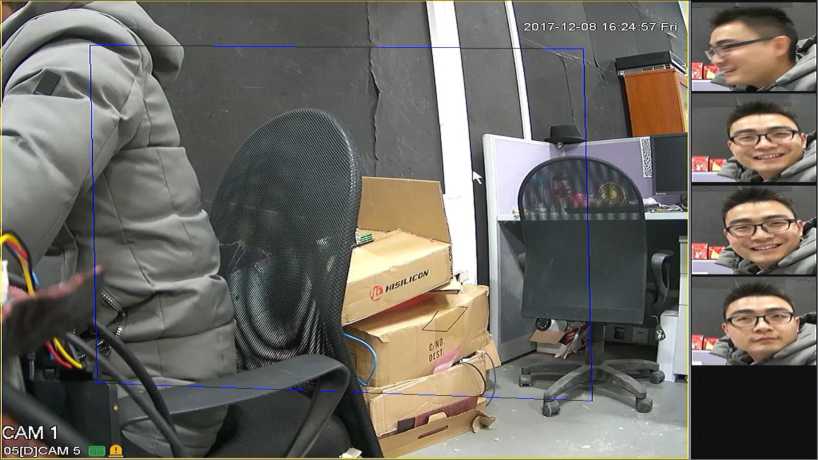
Figure 4-3-1 Face Detection Preview and snapshot at right column
In preview mode you can right click mouse to access the desktop shortcut menu, as shown in gure 4-4.
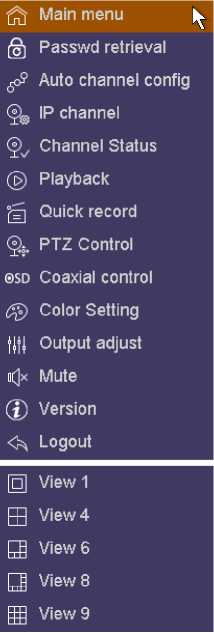
Figure 4-4 Desktop shortcut menu
- Main menu: The main menu includes playback, setting, maintain, backup and shutdown.
- Password retrieval: Modify administrator password or Reset password by e-mail.
- Automatic channel config: When you right click mouse and choose Auto Channel Config, it means that HD DVR will auto add the IP cameras which in the same LAN.
- IP channel: It is a shortcut access to IP channel interface.
- Channel Status: It is a shortcut access to channel status interface.
- Playback: It is a shortcut access to video playback interface.
- Quick Record: You can check current channel status: “o” means it is not selected, “•” Means it is selected.
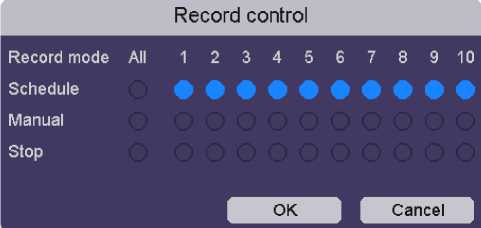
Figure 4-5 Quick Record
| Items | Description |
| Schedule | Record according to the configuration. |
| Manual | Click the button and the according channel will record immediately regardless of the current state. |
| Stop | Click the stop button and the according channel will stop recording regardless of the current state. |
Table4-3Quick Record
- PTZ control: Operation interface is as shown in figure4-6. The functions include: PTZ direction control, speed, zoom, focus, iris, setup operation, patrol between spots, pattern, border, tour.
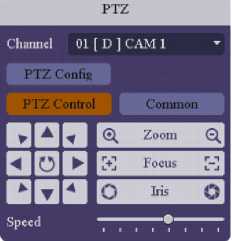
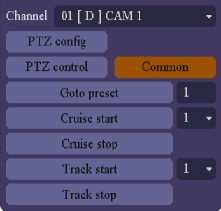
PTZ
Figure 4-6 PTZ Control
- Coaxial control: Operation interface is as shown in figure4-7. You can operate the OSD menu through this way, be noted that the HD camera must support coaxial control.
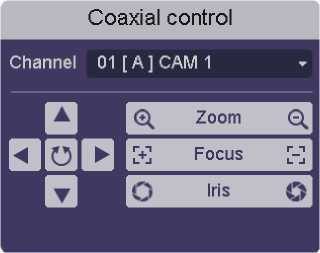
Figure 4-7Coaxial Control
- Color setting: it is a shortcut to settings ->Channel management ->Image color settings window.
- Outputs adjust: it is a shortcut access to settings ->System settings ->Output control interfaces.
- Mute: The speaker mute switch, Icon means speaker turns on, icon □
means
speaker turns off.
- Version: It’s a shortcut access to the System version.
- Logout: Shutdown, restart system, logout menu user and switch user, as shown in
figure 4-8.
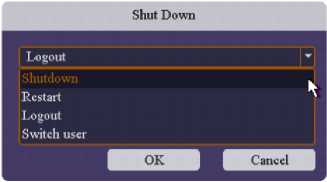
Figure 4-8 Logout
• Screen switch: Preview in single screen/four screens/eight screens /nine screens /sixteen screens according to your choice.
Click on the “setting -> System -> General “into the general interface, as shown in Figure 4-9.
Figure 4-9 General
• Language: English, Simplified Chinese,Italian, Russian, Portuguese, Turkish, Polski, Arabic, Cesky.
• Time zone: Select your corresponding time zone here.
• System time: Set the system data and time.
• Date format: Choose the data format: YMD, MDY, DMY.
• Time format: Choose list separator of the data format: dot, beeline and solidus.
• Time Format: Choose time format: 24-hour or 12-hour.
• DST: Choose the summer time option and pop the dialog box as followed.
Figure 4-9 DST (week)
DST
Day of Week Date
Start: 0 2016 – 03 – 01 01 : 00
End: 0 2016| -10-01 01 : 00
OK ■ Cancel
Figure 4-9 DST (date)
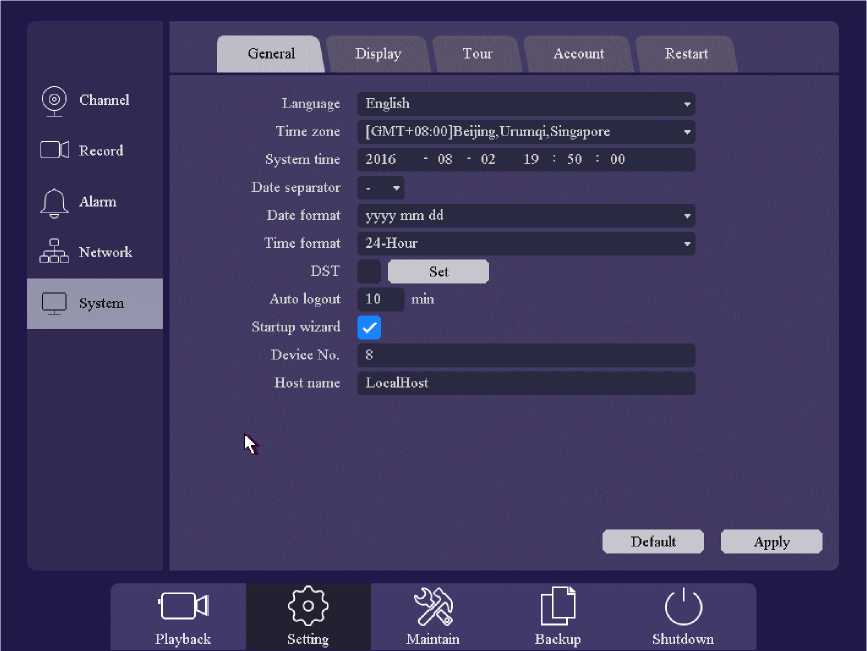
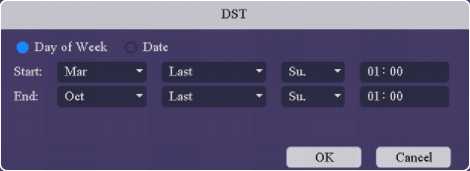
- Auto Logout: Set the latency time in 0-60. 0 means no latency time.
- Startup Wizard: The startup wizard can guide you to finish some important settings of
the AHD DVR. You can also choose to skip this step.
- Device No.: When you are using one remote control to control several HD DVRs, you can give a number to each HD DVR as address for your management.
- Host Name: HD DVR’s name
- Smart Display: it will display smart alarm line or area after you enable this function
Click on the “settings -> System ->Display” into the display setting interface, as shown in Figure 4-10. In this pare you can adjust video output parameters.
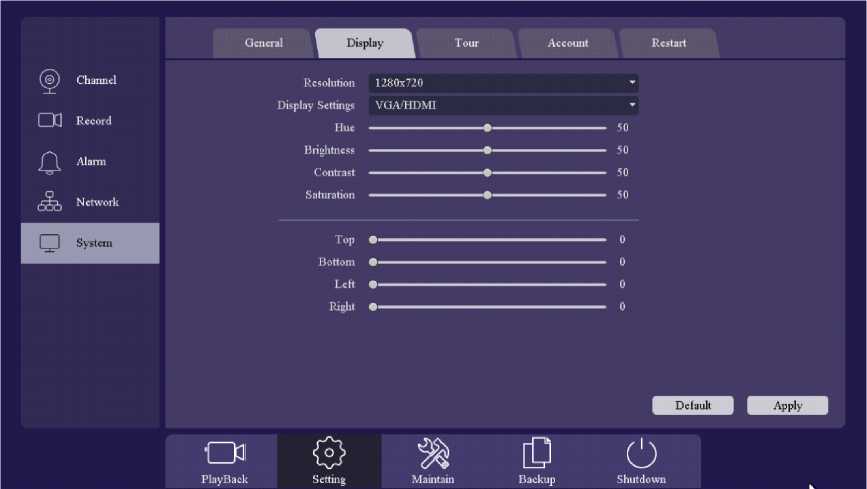
Figure 4-10 Display
Click on the “settings -> System ->Tour” into the tour setting interface. As shown in Figure 4-11.
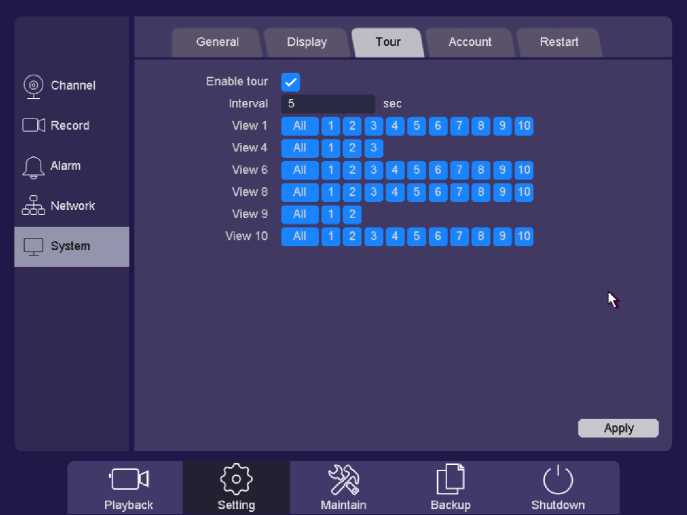
Figure 4-11 Tour
- Enable Tour: Tour on or off
- Interval: Interval time setting, the range of values is from 5s to 120s.
- View: View checking about tour
Click on “Setting -> System ->Account” into the account interface, as shown in figure 4-12. There are two default accounts in the HD DVR: admin/guest, admin’s default password is 1234567u while the other is empty. The account of admin is an administrator, it has the permission to add and delete any user and configure user parameters

Figure 4-12 Account
Note :
- The character length of name is 64 bits at most for the following users and users’ group. Legal characters include: letter and number, other characters are forbidden.
- The user management includes: group/ user. One user should belong to one group.
- Add Group: Add a user group and set the permission. There are 73 different permissions: control panel, real time surveillance, playback, recording setup, video file backup and so on.
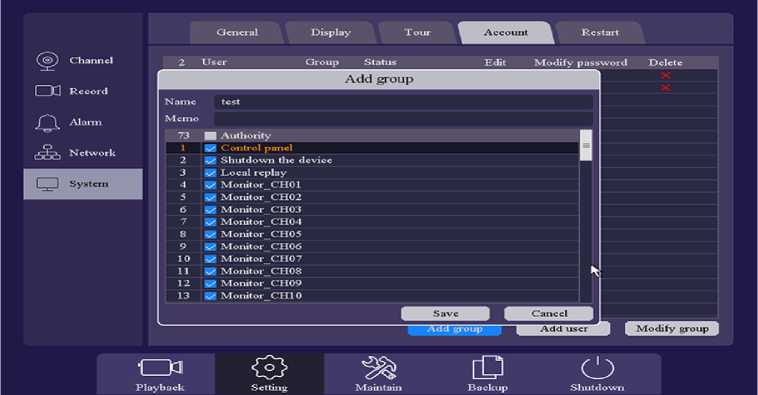
Figure 4-13 Add group
- Add user: Add a user in the group and set the user permission. Enter the menu
interface and input the user name and password. Choose the group and choose whether
using “Reuseable” function, this function allows multiple users use the same account to
login. User’s right cannot exceed group’s right. We recommend that the common user’s
permission is lower than the advanced user.
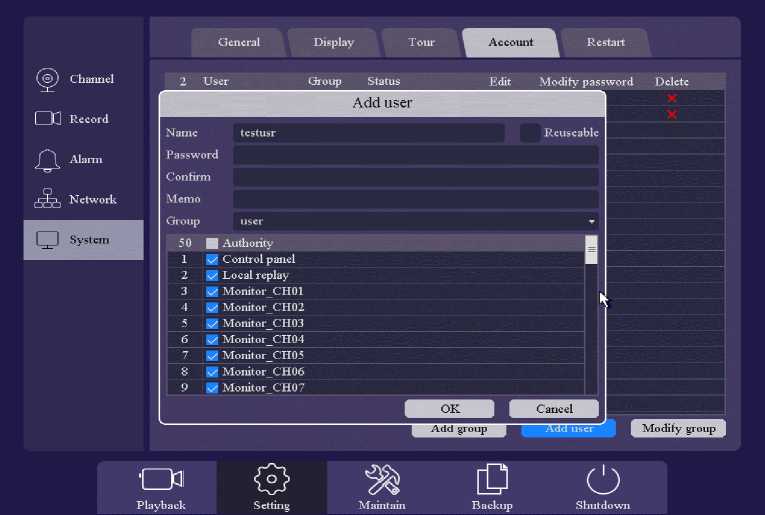
Figure 4-14 Add user
• Modify Group: Modify the existing groups’ attribute, as shown in figure 4-15.
Figure 4-15 Modify group
• Modify User: click icon ——to modify the existing users’ attribute, as shown in figure
4-16.
Figure 4-16 Modify User
• Modify password: You can set password among 1-64 bytes, legal characters include letter and number, other characters are not forbidden, as shown in figure 4-17.
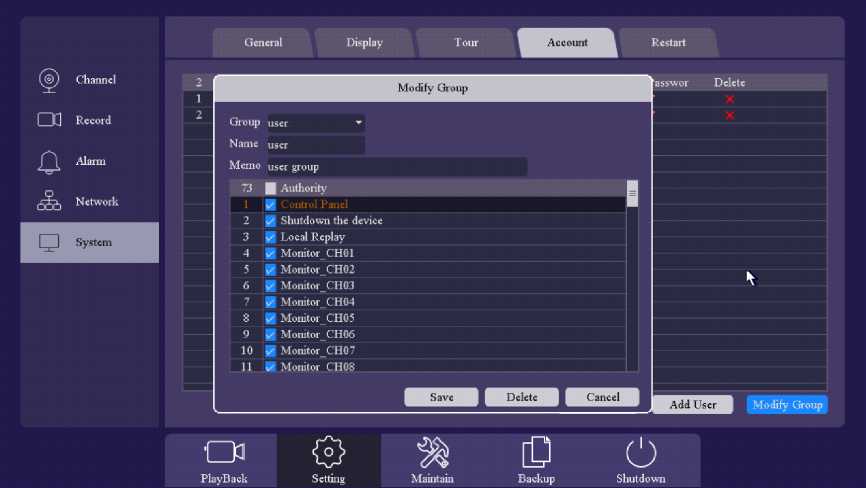
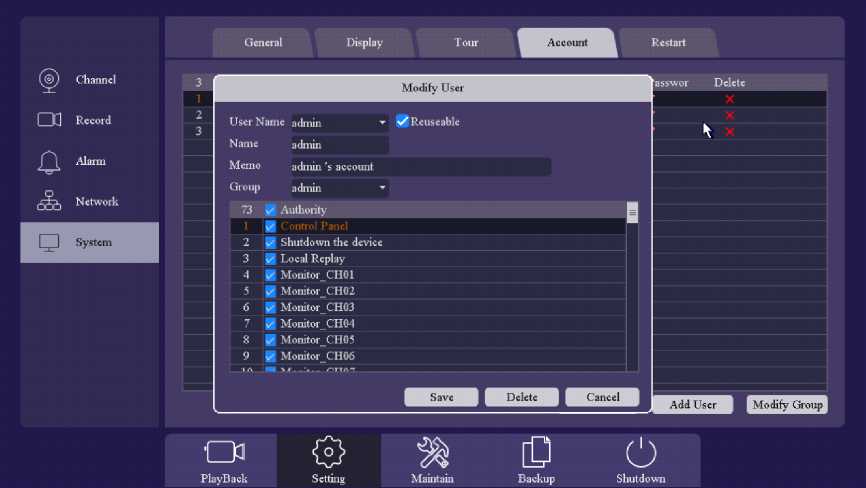
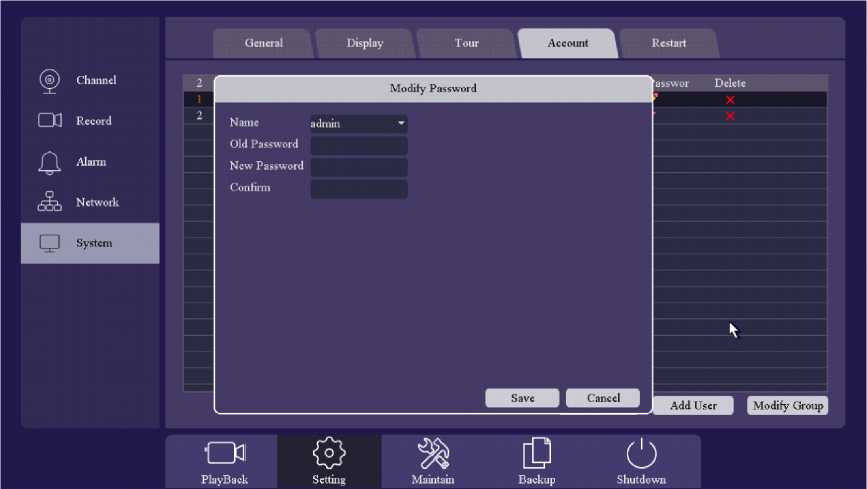
Figure 4-17 Modify password
Note:
> The user who possesses the user control permission can modify his/her own or other user’s password.
Click on “Setting -> System ->Restart” into the graphical interface, as shown in figure 4-18.The user can set the auto reboot time to maintain the device.
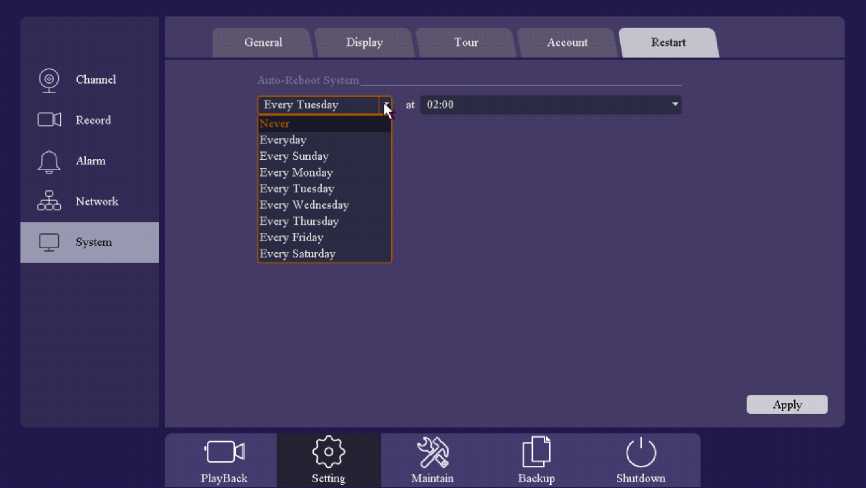
Figure 4-18 Restart
Before the HD DVR connects to the Network, you need to configure the related settings of Network. In this chapter, we can set the basic network configuration, WIFI, 3G/4G, P2P, DDNS, UPNP, Email, FTP, NTP, Access control, etc.
Click on “Setting -> Network -> Base” into the network base settings interface, as shown in figure 4-19. This page you can set the device IP Address, gateway, DNS As well as view MAC Address.
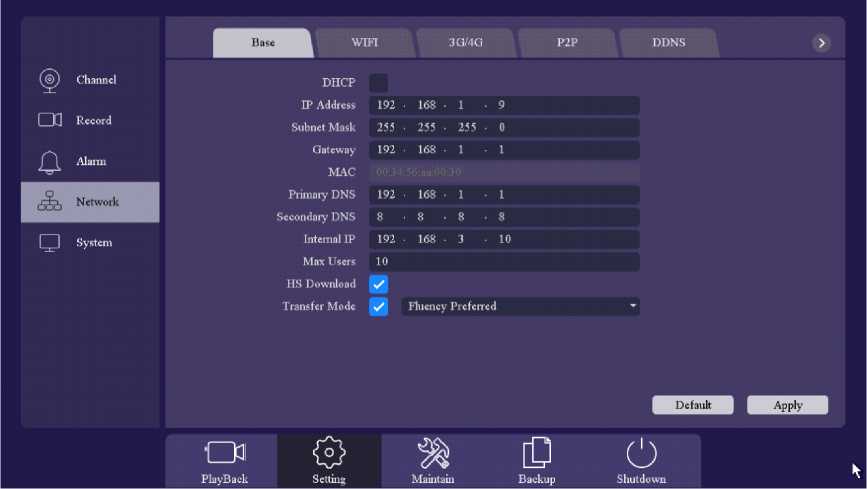
Figure 4-19 Basic Setting of Network
- DHCP: Obtain IP address automatically.
- IP Address: Set the IP address of HD DVR. Default is 192.168.1.9
- Subnet Mask: Default is 255.255.255.0.
- Gateway: Default is 192.168.1.1.
- MAC: the physical address of HD DVR.
- DNS setup: Domain Name Server, it translates the domain name into IP address, it contain primary DNS and secondary DNS.
- Internal IP: Set the beginning of IP addresses of those IP Cameras connected to POE panel. Default is 192.168.3.10. Make sure that this value should not be at the same subnet with the IP address of HD DVR.
- Max Users: The maximum number of users can simultaneously access the HD DVR. Default value is 10.
- HS Download: Download at a high speed on the network side.
- Transfer Mode: There are three modes: Quality preferred, Fluency preferred and Adaptive. The code stream will adjust itself according to the setting, adaptive is the tradeoff between the image quality preferred and fluency preferred, fluency preferred and adaptive are valid only when the sub-stream is turned on, otherwise, quality preferred is valid.
Note:
> You can’t set internal IP address if the HD DVR is not support POE function.
Click on “Setting -> Network ->WIFI” Into the WIFI setting interface. This interface will display the search to WIFI Name, signal strength and encryption. You need to prepare a WIFI and connect to the USB connector of the HD DVR.
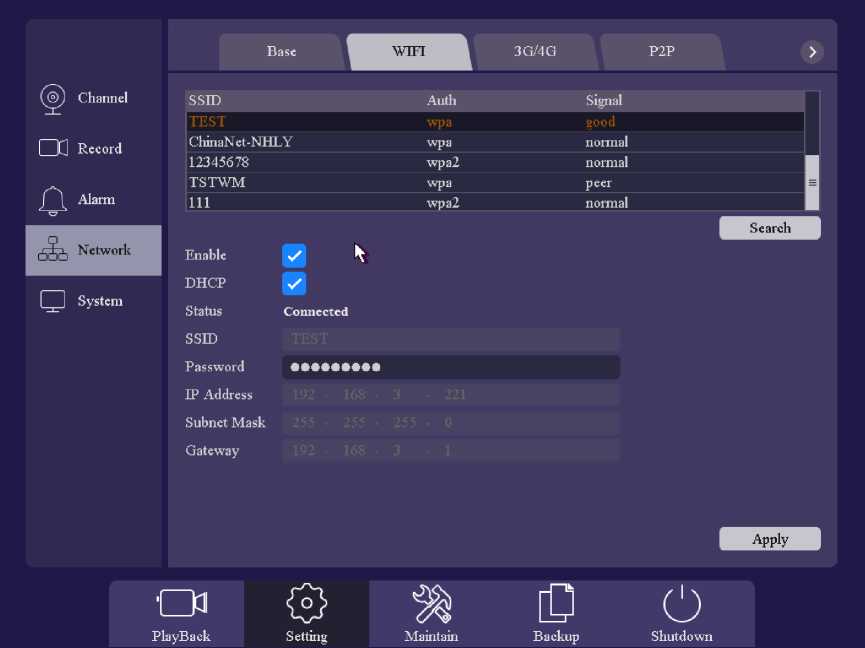
Figure 4-20 WIFI Setting
- Enable: WIFI Enabling switch
- DHCP: Automatically obtain the IP Addresses and gateways.
Click on click on “Setting -> Network ->3G “Into the graphical interface. This page can be set 3G Function, Status, 3G Signal types, and Access point, Dial- number, User Name, Password, and 3G IP Addresses. You need to prepare a 3G/4G network Data Card and connect to the USB connector of the HD DVR. The User name and Password need to be supplied by your ISP.
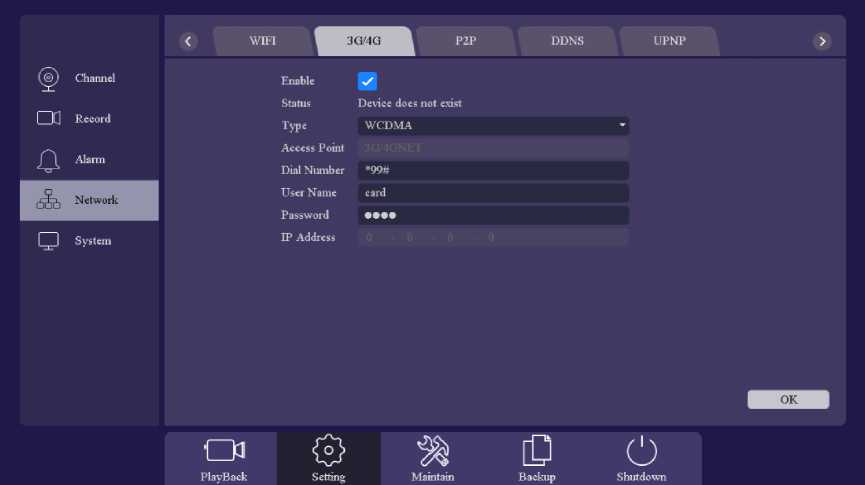
Figure 4-21 3G Setting
HD DVR can be connected to Cloud service and users can visit the HD DVR by its Cloud ID through Cellphone APP or the website www.elevatep2p.com.
Click on “Setting -> Network ->P2P “Into the graphical interface. This page shows the iPhone or Android APP download links, and the cloud ID Identification code.
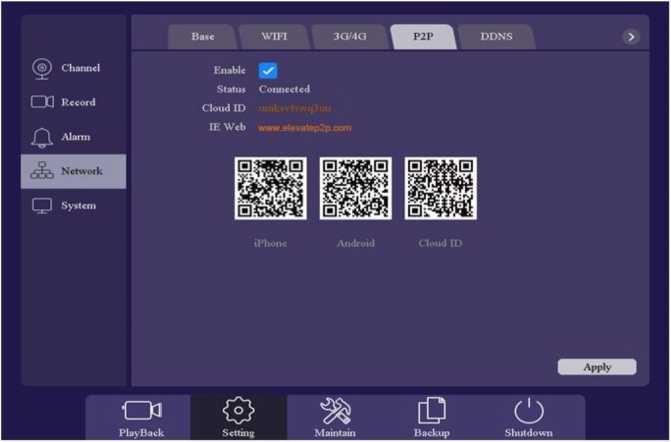
Figure 4-22 P2P Setting
- Enable:P2P Function enabling switch.
- Status: Display P2P status.
- Cloud ID: P2P Identification number.
- IE Web: The P2P web address.
You can visit HD DVR by entering www.elevatep2p.com in the Web Browser of your computer, and click the option By Device, fill in the blank with the serial code Cloud ID, and Username, Password of HD DVR.
DDNS is a service that can be used to automatically update DNS records if client PCs get their IP settings from a DHCP Server. If DDNS function is enabled on HD DVR, you can access the HD DVR by domain name provided by Internet Service Provider (ISP) provider.
Prior registration with your ISP is required before configuring the system to use DDNS.
Click on “Setting -> Network ->DDNS “Into the graphical interface.
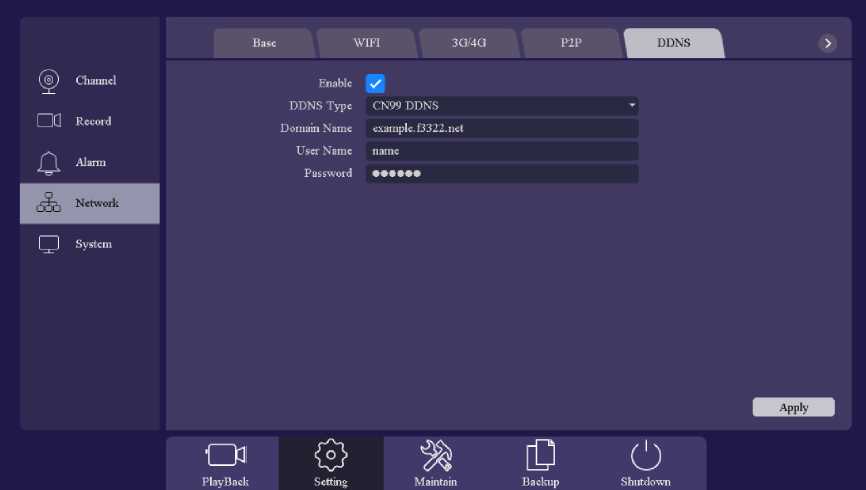
Figure 4-23 DDNS Setting
- Enable: DDNS enabling switch.
- DDNS Type: ISP of DDNS, including Oray DDNS, CN99 DDNS, DynDNS DDNS, NO-IP DDNS. This option can be customized according to the requirement of users.
- Domain name: Fill in the domain name provided by ISP. Maximum 63 characters can be filled in.
- User name/Password: Fill in the username and password input corresponds to the domain name.
UPnP is a networking standard that uses protocols on the Internet to allow electronic devices connected to a network to detect and identify each other.
Click on “Setting -> Network ->UPNP “Into the graphical interface. This page can set up Media Port, HTTP Port and Handset Port. Check UPNP Is enabled, the external port can automatically obtain and use.
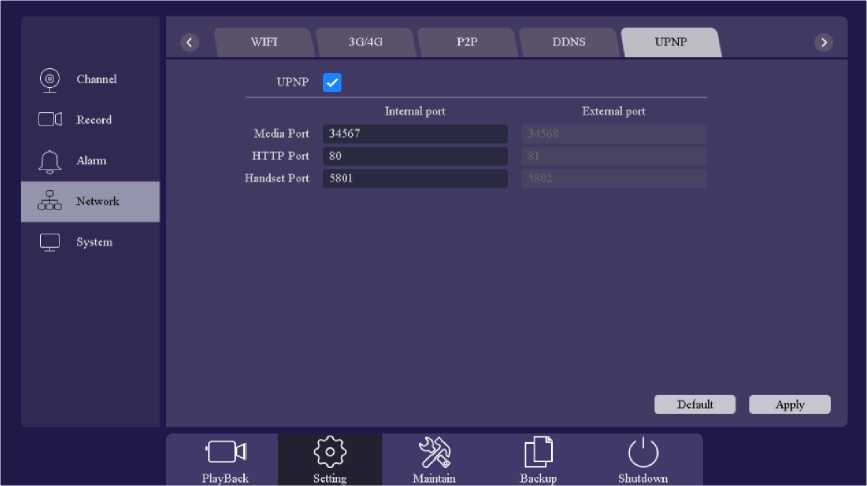
Figure 4-24 UPNP Setting
The system can be configured to send an Email notification to all designated users if an alarm event is detected, etc.; an alarm or motion event is detected.
The network must be connected to the Internet in order to connect to the Email SMTP server.
Click on the “settings -> Network ->E-mail” into the graphical interface.
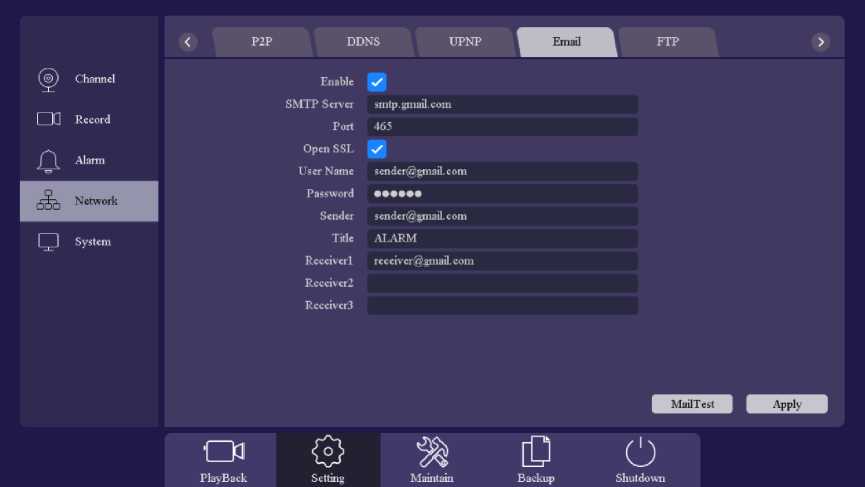
Figure 4-25 E-mail Setting
- Enable: Enable the Email service.
- SMTP Server: The SMTP Server IP address or host name.
- SMTP Port: The SMTP port. The default TCP/IP port used for SMTP is 25.
- Open SSL: Click the checkbox to enable SSL if required by the SMTP server.
- User Name/Password: The username and password of the sender email accounts.
- Sender: Displayed by the recipient of the message sender email address.
- Title: The title displayed in the email.
- Receiver: The Email address of user to be notified (3 receivers at most).
After finishing the setting, you can click the button MailTest to try to verify the email service is available, and click the button Apply to activate the configuration.
You can upload the record file onto a FTP server by configuring the FTP settings. It allows you to upload the record file by the record type and record time.
Click on the “Setting -> Network ->FTP “Into the graphical interface.
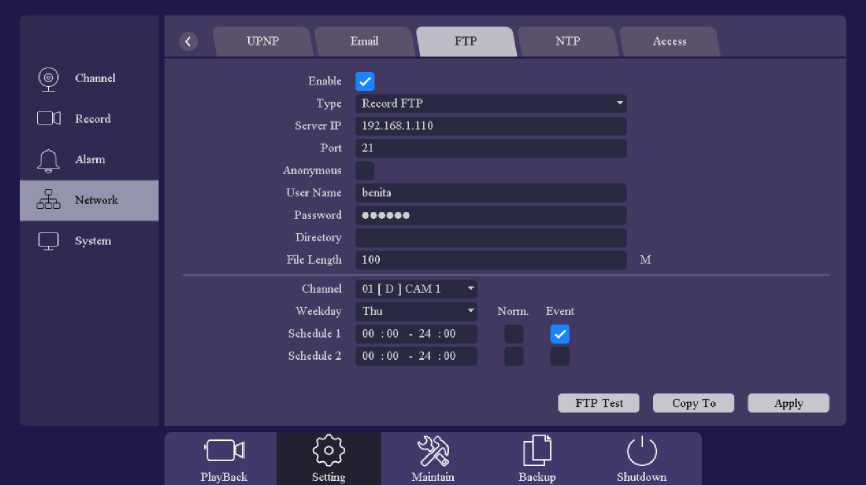
Figure 4-26 FTP Setting
- FTP setting: divided into video FTP and pictures FTP ,you can set up your server IP, port, user name, password, directory, file length, and there are the Anonymous option, and FTP Setting whether the testing successful.
- Channel setting: you can select the channel to transmit, set up on weekday, as well as the time period.
After finishing the setting, you can click the button FTP Test to try to verify the FTP service is available, and Copy To button is used to copy the configuration of current channel to other channels. Click the button Apply to activate the configuration.
A Network Time Protocol (NTP) Server can be configured on your HD DVR to ensure the accuracy of system date/time.
Click on the “Setting -> Network ->NTP “Into the graphical interface. This page can be set NTP server IP, server port, update schedule.
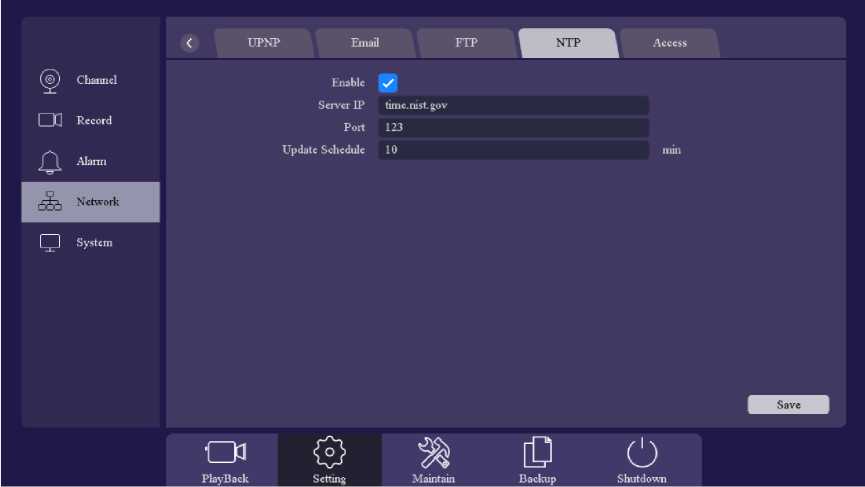
Figure 4-27 NTP Setting
- Enable: Enable the NTP service.
- Server IP: The NTP Server IP address or host name.
- Port: Port of NTP server.
- Update Schedule: Time interval between the two synchronizing actions with NTP server. The unit is minute.
Click the button Save to save the configuration.
Note:
> The time synchronization interval can be set from 1 to 65535min, and the default value is 10 min. If the HD DVR is connected to a public network, you should use a NTP server that has a time synchronization function, such as the server at the National Time Center.
In this chapter by setting the IP address to be blocked and trusted, you can block specific IP address or allow some trusted IP.
Click on the “Setting -> Network -> Access “into the graphical interface.
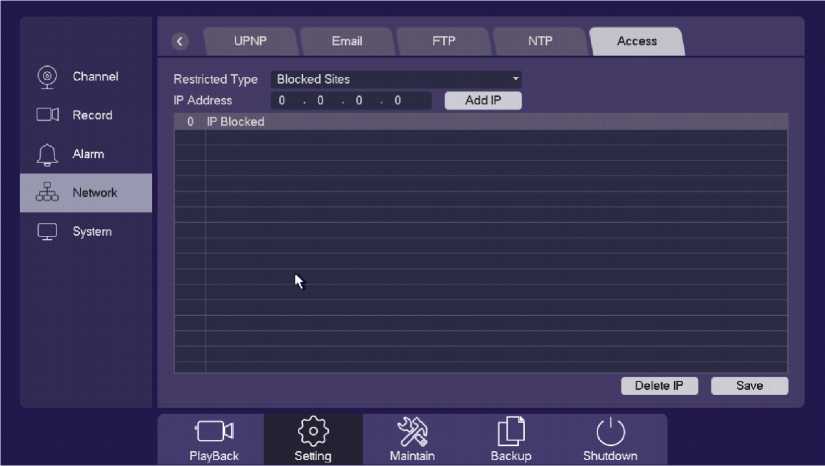
Figure 4-28 Access
• Blocked Sites: The IP Addresses which are added to blocked sites are not allowed to login HD DVR.
• Trusted Sites: Only the IP Addresses which are added to trusted sites are allowed to login HD DVR.
You can add IP or delete IP by clicking Add IP and Delete IP buttons. After the operation is finished, click the Save button.
In this chapter, you can set the Cloud Storage to upload your videos and picture recorded by your cameras.
Click on the “Setting -> Network ->Cloud Storage “into the graphical interface.
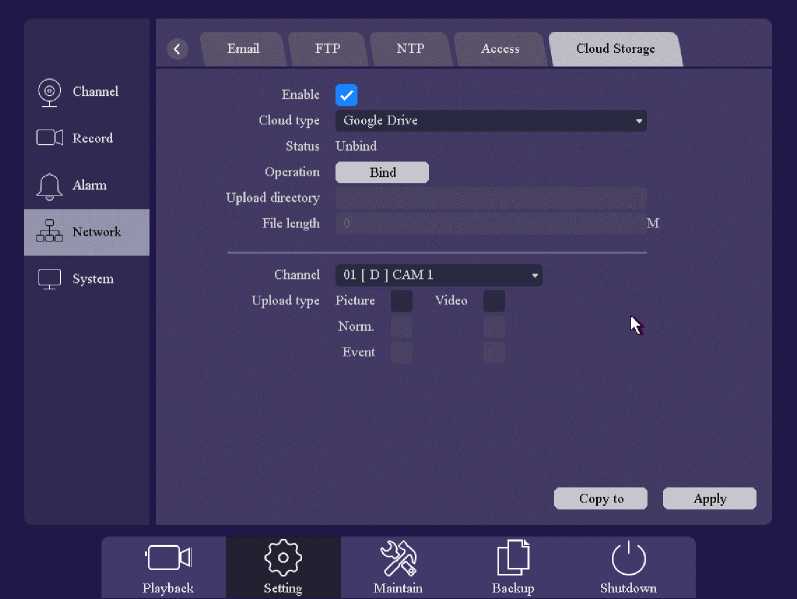
Figure 4-29 Cloud Storage
• Upload directory: The directory in your cloud storage where the videos and pictures to be saved, if not set, the video file will be saved at the root directory directly.
• File length: The space spared to save videos and pictures, the default number is ‘0′, which means the space will save the whole video and picture file as much as the original video file.
• Chanel: Choose which channel to upload video or picture.
• Upload type: Choose picture or video to be uploaded, and choose the type of the file, the type can be ‘Normal’ or ‘Event’.
Simple Network Management Protocol (SNMP) is an Internet-standard protocol for collecting and organizing information about managed devices on IP networks and for modifying that information to change device behavior.
Click on the “Set -> Network ->SNMP “into the SNMP configuration interface. There are 3 versions in SNMP. V1/V2 are shown in figure 4-30.
Figure 4-30 SNMP V1/V2
V1/V2 is basic encryption method, V3 is advanced one with more complicated encryption, as shown in figure 4-31.
Figure 4-30 SNMP V3
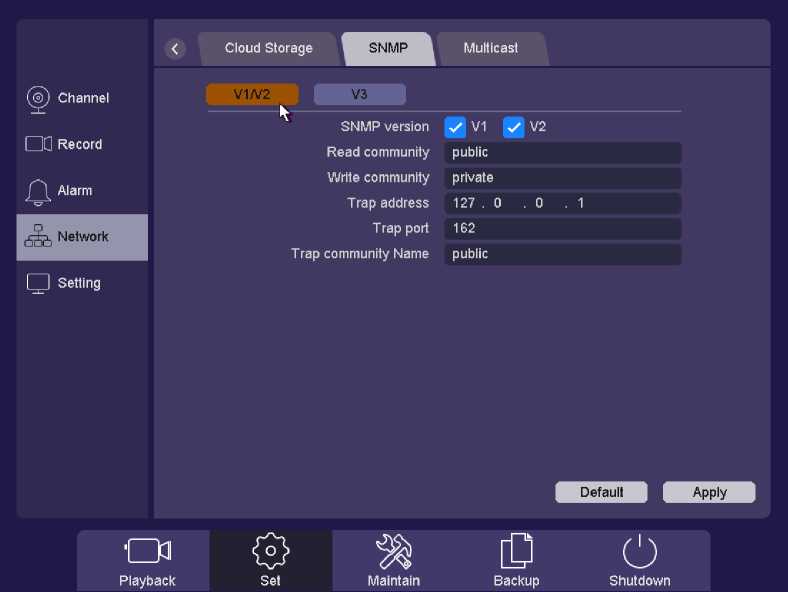
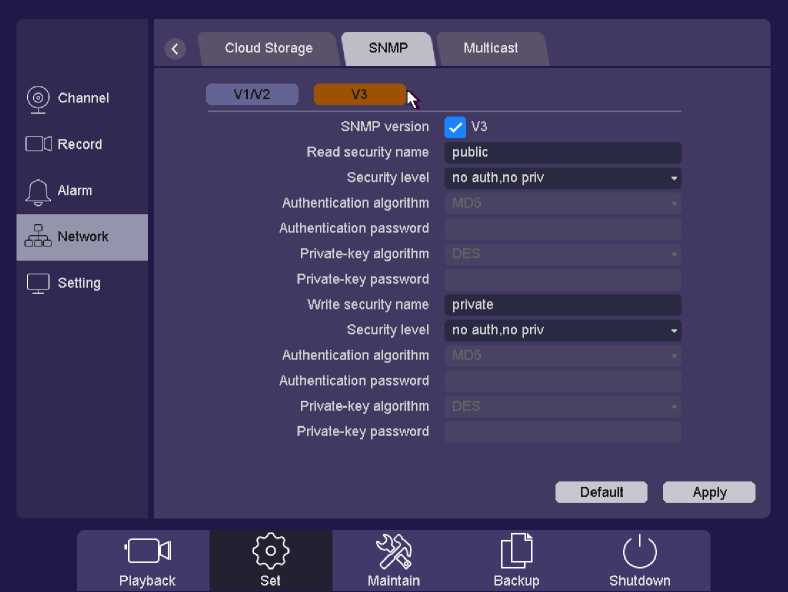
In computer networking, multicast (one-to-many or many-to-many distribution) is group communication where information is addressed to a group of destination computers simultaneously.
Click on the “Set -> Network ->SNMP “into the SNMP configuration interface, set the Multicast IP and Multicast port within the required range. If different source devices want to apply the multicast, the multicast IP should be DIFFERENT. In the last, enable the function and apply. As shown in figure 4-32.
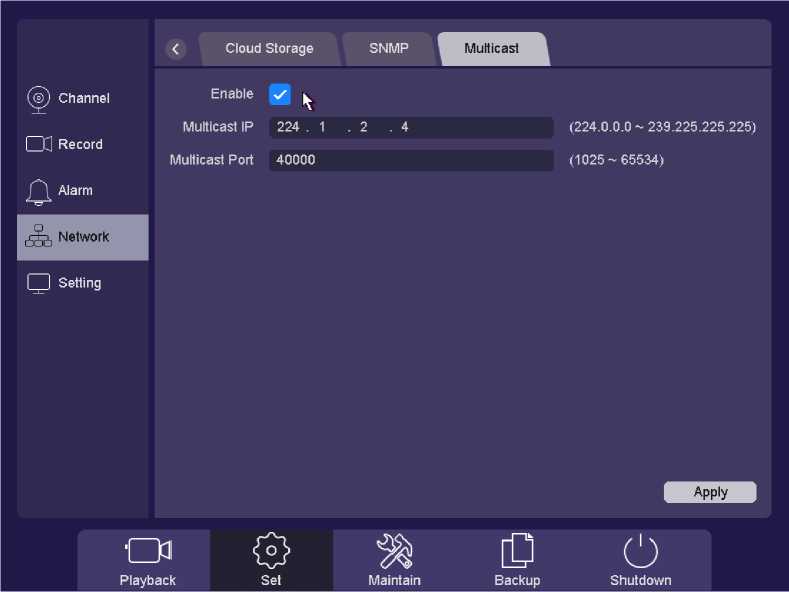
Figure 4-32 Multicast
The HD DVR supports video detection alarm, including motion detection, masking detection, video lost detection. And also exception warnings such as HDD error, no writable disk, disk no space, network disconnection or IP conflicted.
Note:
> Video detection should be supported by the IP Camera, so please refer the User Manual of IP Camera to confirm the video detection types. If the IP Camera does not support some types of the video detection, the configuration on the HD DVR would be unable to activate.
Motion detection is to detect the movement of the channel. If any movement appears in the surveillance area, the HD DVR will detect it and respond according to the settings.
Click on the “Setting -> Alarm -> Motion” into the setting interface.
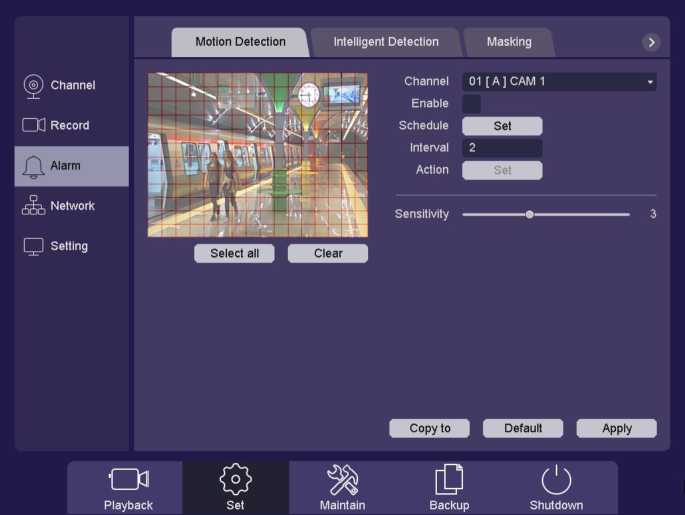
Figure 4-33 Motion Detect
- Channel: Select the channel.
- Enable: Motion detection-enabled switch.
- Schedule: Set the time slot of motion detection. Here it supports 6 time slots at most. You can copy the setting to other days: click Copy, and select another weekday, click Paste to have it configured as the former one. Click Default to clear all the settings. (as shown in figure 4-31)
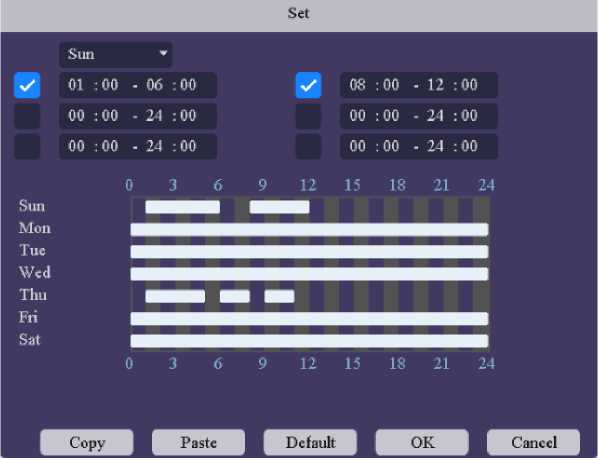
Figure 4-34 Schedule Setting
• Interval: Set the time interval of each motion detection triggered.
• Trigger process: Set the handling action of motion detection, including alarm output, alarm delay, show massage, buzzer, send Email, record channels and record delay, PTZ act, tour and Snapshot. (as shown in figure 4-35). Maximum 4 channels can be chosen when you select the Snapshot.
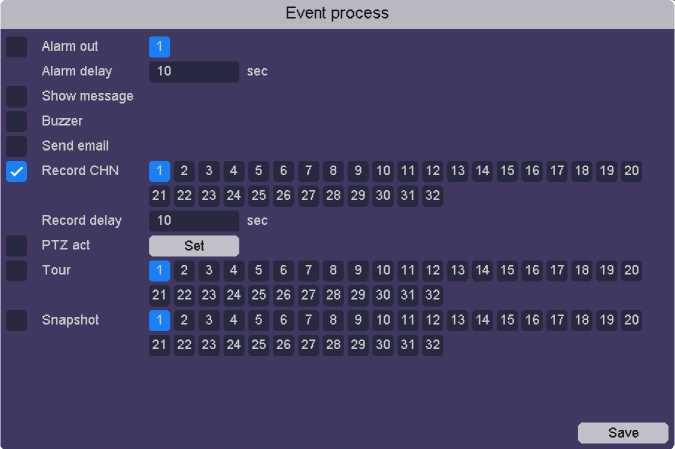
Figure 4-35 Event Process
- Sensitivity: Set Sensitivity of motion detection, range from 1 to 6.
You need to select the surveillance area on the screen, by click and drag the mouse, or you can click the button Select All to select all the surveillance area, or click the button Clear to reset the button:
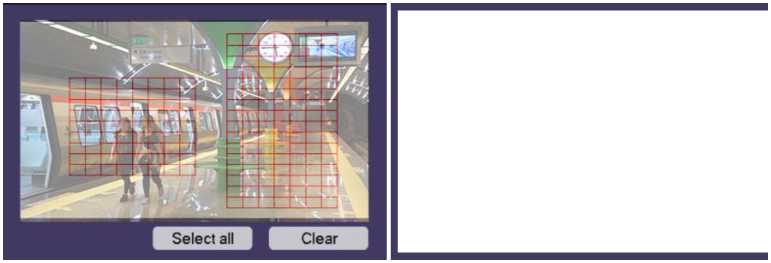
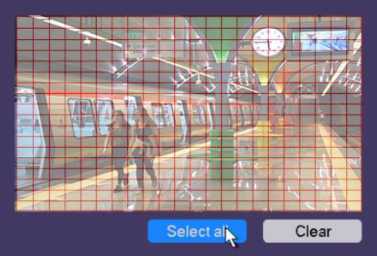
Figure 4-36 Select partially
Click Apply button to save the settings.
Figure 4-37 Select All
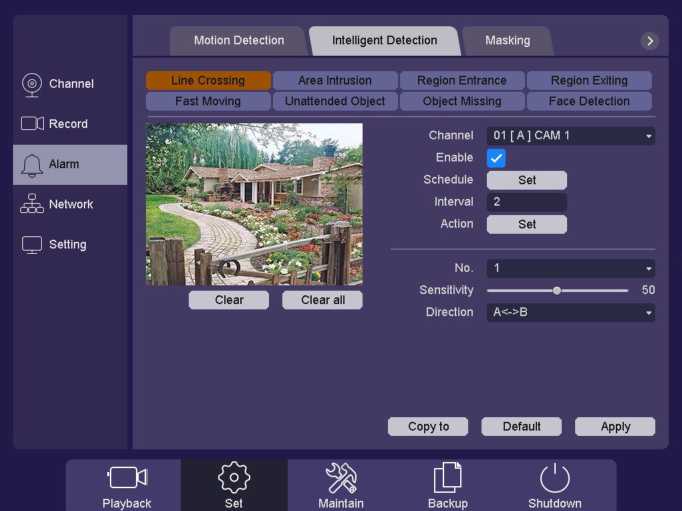
Figure 4-38 Intelligent Detection
In this section UVR support different types of analyses when connect Qualvision IPC by private protocol. But only Line Crossing and Area Intrusion can be used in analogy channels after user enable the smart channel setting in part 4.3.5.1.3;
Note:
> The sum of the smart analyze may differ from different UVR product Line, but the principle is same;
> we need IPC support corresponding smat analyses function from Qualvision.
Crossing detection is used to detect the object crossing the set virtual line. The direction can be set as bidirectional, or from side A to B, or from side B to A. If there’s object move from one side to another, it will trigger the alarm and the NVR will respond those actions as configured, such as record, show message, send email, etc.
Click on the “setting -> Alarm -> Intelligent detection -> Line Crossing” into the graphical interface.
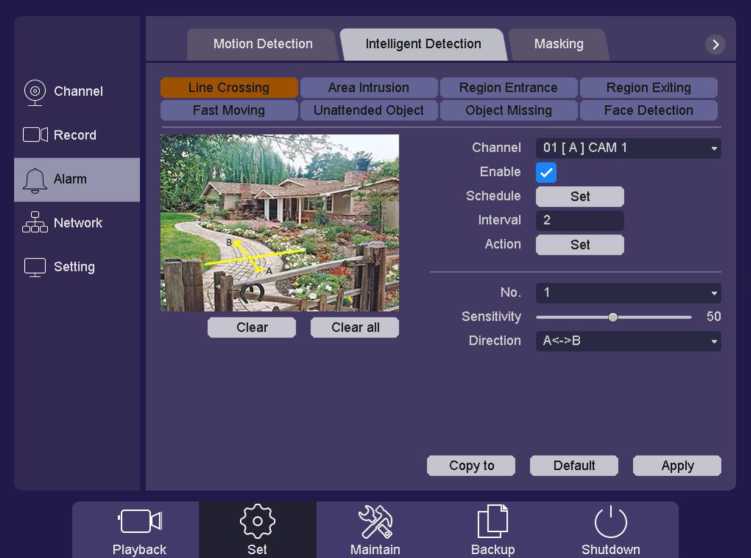
Figure 4-39 Line Crossing
- Channel: Select the channel.
- Enable: Crossing detection enabled switch.
- Schedule: Set the time slot to detect crossing. You can take the setting of chapter 4.3.3.1 motion detection for reference.
- Interval: Set the time interval of each crossing detection triggered.
- Trigger process: Set the handling action of crossing detection; please take the setting of chapter 4.3.3.1 motion detection for reference.
You can add virtual line to the surveillance area like following steps:
- Choose the line number, the maximum number of the line is 4.
- Select the direction: A<->B, A->B, B->A.
A<->B: Only the arrow on the B side shows; when an object going across the configured line with both direction can be detected and alarms are triggered.
A->B: Only the object crossing the configured line from the A side to the B side can be detected.
B->A: Only the object crossing the configured line from the B side to the A side can be detected.
- Adjust the sensitivity. Range from 1-100.The higher the value is, the more easily the detection alarm can be triggered.
- Click the Apply button to save the settings.
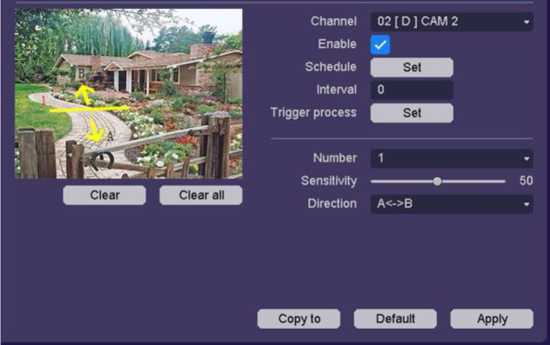
Figure 4-39-1 Add Virtual Line
After all the settings finished, click the button Apply to activate all the settings.
Area Intrusion detection function detects people, vehicle or other objects which enter in a pre-defined virtual region from outside, and some certain actions can be taken when the alarm is triggered.
Click on the “Setting -> Alarm -> Intelligent detection -> Area Intrusion “into the graphical interface.
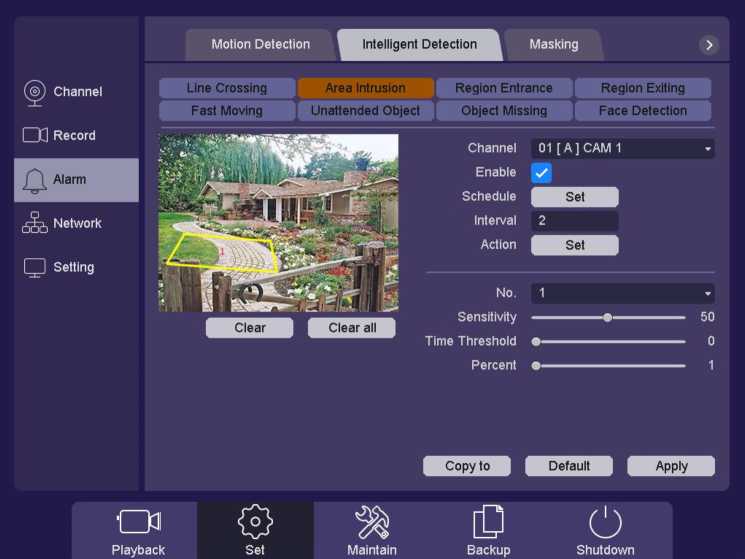
Figure 4-40 Area Intrusion
- Channel: Select the channel.
- Enable: Intrusion detection enabled switch.
- Schedule: Set the time slot to detect intrusion. You can take the setting of chapter 4.3.3.1 motion detection for reference.
- Interval: Set the time interval of each intrusion detection triggered.
- Trigger process: Set the handling action of intrusion detection; please take the setting of chapter 4.3.3.1 motion detection for reference.
You can add virtual area to the surveillance area like following steps:
- Choose the area number, the maximum number of the area is 4.
- Set detect time threshold. For example, if you set the time threshold is 5 seconds and
someone intrude your area about 3 seconds alarm cannot be triggered.
- Adjust the sensitivity. Range from 1-100. The higher the value is, the more easily the detection alarm can be triggered.
- Percent. Range from 1-100. For example, if you set the percent is 50, alarm will be triggered only when the area be intruded more than half.
- Click the Apply button to save the settings.
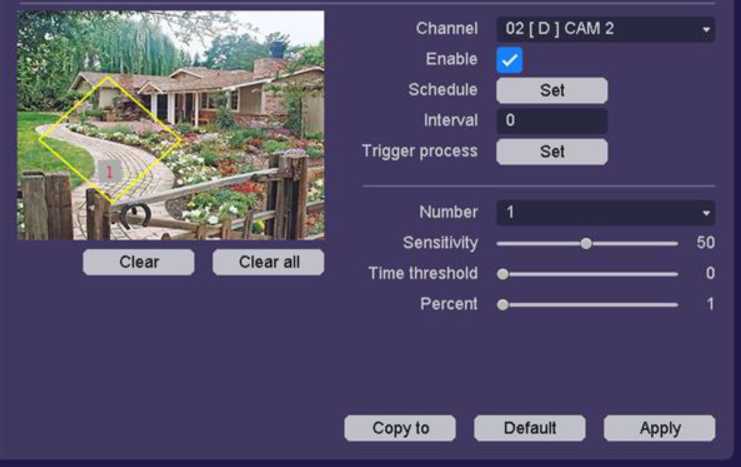
Figure 4-40-1 Set Intrusion Zone
After all the settings finished, click the button Apply to activate all the settings.
Region Entrance function detects people, vehicle or other objects which enter in a forbidden pre-defined virtual region from outside, and some certain actions can be taken when the alarm is triggered.
Click on the “Setting-> Alarm->Intelligent detection -> Region Entrance” into the graphical interface.
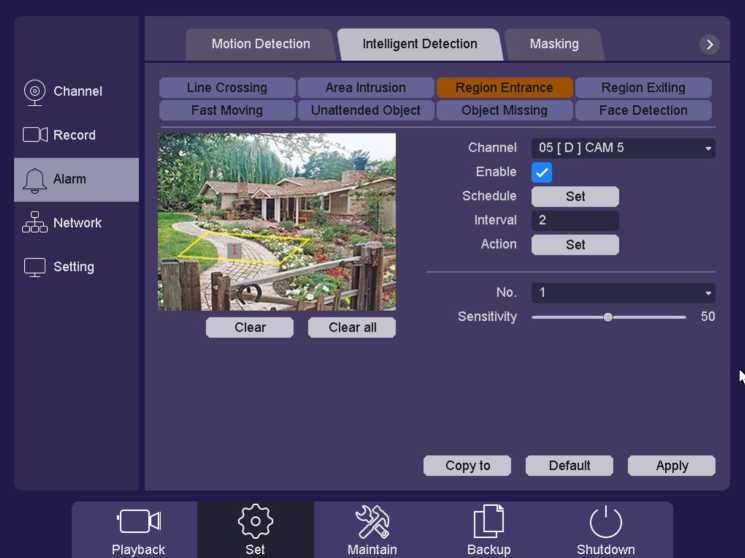
Figure 4-41 Region Entrance
- Channel: Select the channel.
- Enable: Intrusion detection enabled switch.
- Schedule: Set the time slot to detect intrusion. You can take the setting of chapter 4.3.3.1 motion detection for reference.
- Interval: Set the time interval of each intrusion detection triggered.
- Trigger process: Set the handling action of intrusion detection; please take the setting of chapter 4.3.3.1 motion detection for reference.
You can add virtual area to the surveillance area like following steps:
- .Choose the area number, the maximum number of the area is 4.
- .Adjust the sensitivity. Range from 1-100. The higher the value is, the more easily the detection alarm can be triggered.
- .Click the Apply button to save the settings.
After all the settings finished, click the button Apply to activate all the settings.
Region Exiting function detects people, vehicle or other objects which exit a forbidden pre-defined virtual region from inside, and some certain actions can be taken when the alarm is triggered.
Click on the “Setting -> Alarm -> Intelligent detection -> Region Exiting “into the graphical interface.
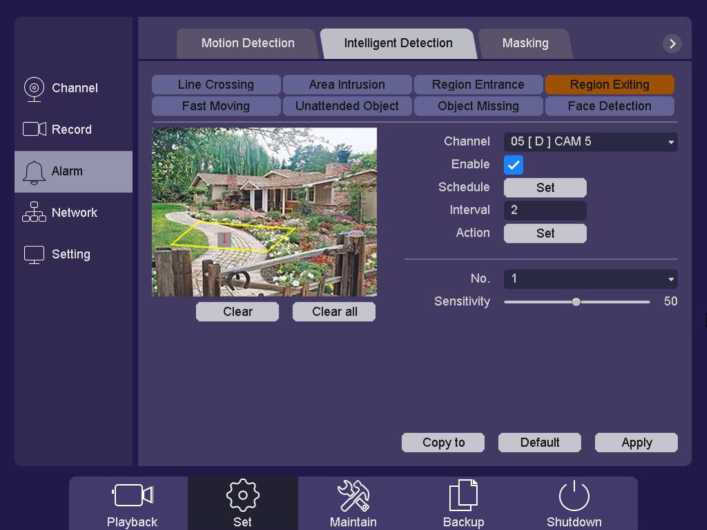
Figure 4-42 Region Exiting
- Channel: Select the channel.
- Enable: Intrusion detection enabled switch.
- Schedule: Set the time slot to detect intrusion. You can take the setting of chapter 4.3.3.1 motion detection for reference.
- Interval: Set the time interval of each intrusion detection triggered.
- Trigger process: Set the handling action of intrusion detection; please take the setting of chapter 4.3.3.1 motion detection for reference.
You can add virtual area to the surveillance area like following steps:
- .Choose the area number, the maximum number of the area is 4.
- .Adjust the sensitivity. Range from 1-100. The higher the value is, the more easily the detection alarm can be triggered.
- .Click the Apply button to save the settings.
After all the settings finished, click the button Apply to activate all the settings.
Fast Moving function detects people, vehicle and some other objects that move with forbidden speed, and some certain actions can be taken when the alarm is triggered.
Click on the “Setting -> Alarm -> Intelligent detection -> Fast Moving “into the graphical interface.
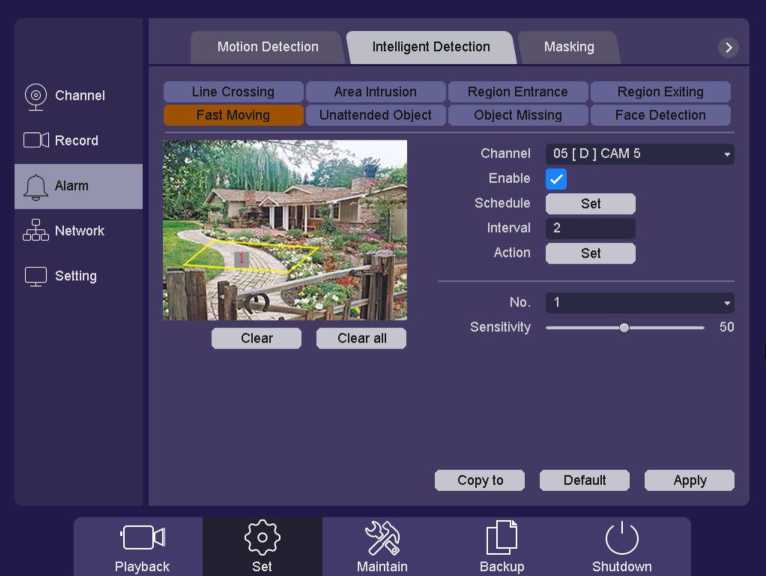
Figure 4-43 Fast Moving
- Channel: Select the channel.
- Enable: Intrusion detection enabled switch.
- Schedule: Set the time slot to detect intrusion. You can take the setting of chapter
4.3.3.1 motion detection for reference.
- Interval: Set the time interval of each intrusion detection triggered.
- Trigger process: Set the handling action of intrusion detection; please take the setting
of chapter 4.3.3.1 motion detection for reference.
You can add virtual area to the surveillance area like following steps:
- .Choose the area number, the maximum number of the area is 4.
- .Adjust the sensitivity. Range from 1-100. The higher the value is, the more easily the detection alarm can be triggered.
- .Click the Apply button to save the settings.
After all the settings finished, click the button Apply to activate all the settings.
Unattended Object function detect articles that left in a certain pre-defined virtual region, and some certain actions can be taken when the alarm is triggered.
Click on the “Setting -> Alarm -> Intelligent detection -> Object Abandoned “into the graphical interface.
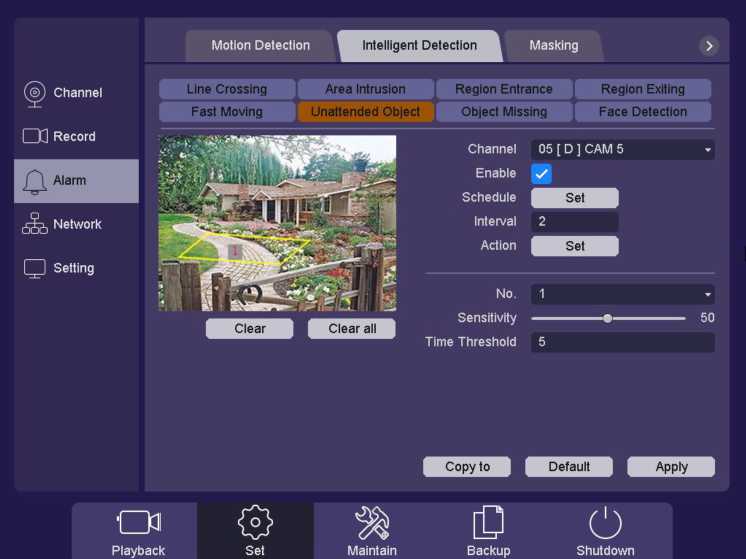
Figure 4-44 Unattended Object
- Channel: Select the channel.
- Enable: Intrusion detection enabled switch.
- Schedule: Set the time slot to detect intrusion. You can take the setting of chapter 4.3.3.1 motion detection for reference.
- Interval: Set the time interval of each intrusion detection triggered.
- Trigger process: Set the handling action of intrusion detection; please take the setting of chapter 4.3.3.1 motion detection for reference.
You can add virtual area to the surveillance area like following steps:
- .Choose the area number, the maximum number of the area is 4.
- .Adjust the sensitivity. Range from 1-100. The higher the value is, the more easily the detection alarm can be triggered.
- .Set detect time threshold. For example, if you set the time threshold is 5 seconds and someone intrude your area about 3 seconds alarm cannot be triggered.
- .Click the Apply button to save the settings.
After all the settings finished, click the button Apply to activate all the settings.
Object Missing function detect articles that missing in a certain pre-defined virtual region, and some certain actions can be taken when the alarm is triggered.
Click on the “Setting -> Alarm -> Intelligent detection -> Object Missing “into the graphical interface.
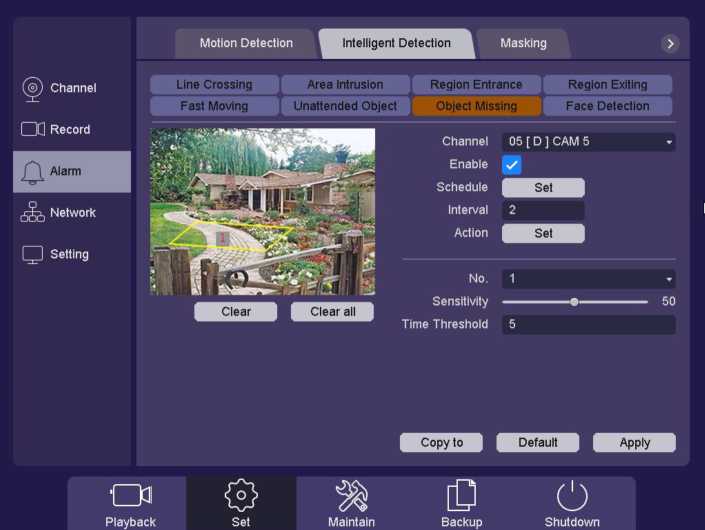
Figure 4-45 Object Missing
- Channel: Select the channel.
- Enable: Intrusion detection enabled switch.
- Schedule: Set the time slot to detect intrusion. You can take the setting of chapter 4.3.3.1 motion detection for reference.
- Interval: Set the time interval of each intrusion detection triggered.
- Trigger process: Set the handling action of intrusion detection; please take the setting of chapter 4.3.3.1 motion detection for reference.
You can add virtual area to the surveillance area like following steps:
- .Choose the area number, the maximum number of the area is 4.
- .Adjust the sensitivity. Range from 1-100. The higher the value is, the more easily the detection alarm can be triggered.
- .Set detect time threshold. For example, if you set the time threshold is 5 seconds and someone intrude your area about 3 seconds alarm cannot be triggered.
- .Click the Apply button to save the settings.
After all the settings finished, click the button Apply to activate all the settings.
Face detection function detect peoples’ faces in a certain pre-defined virtual region, and some certain actions can be taken when the alarm is triggered.
Click on the “Setting -> Alarm -> Intelligent detection -> Face Detection “into the graphical interface.
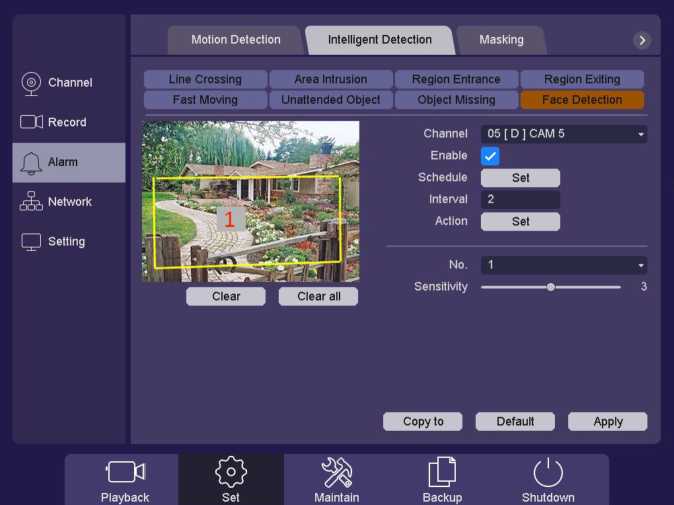
Figure 4-46 Face Detection
- Channel: Select the channel.
- Enable: Face Detection enabled switch.
- Schedule: Set the time slot to detect intrusion. You can take the setting of chapter 4.3.3.1 motion detection for reference.
- Interval: Set the time interval of Face Detection triggered.
- Action: Set the handling action of intrusion detection; please take the setting of
chapter 4.3.3.1 motion detection for reference.
You can add virtual area to the surveillance area like following steps:
- Choose the area number, the maximum number of the area is 4.
- Adjust the sensitivity. Range from 1-100. The higher the value is, the more easily the detection alarm can be triggered.
- Click the Apply button to save the settings.
After all the settings finished, click the button Apply to activate all the settings.
Detect video masked on a channel and take alarm response actions.
Click on the “Settings -> Alarm ->Masking” into the graphical interface.
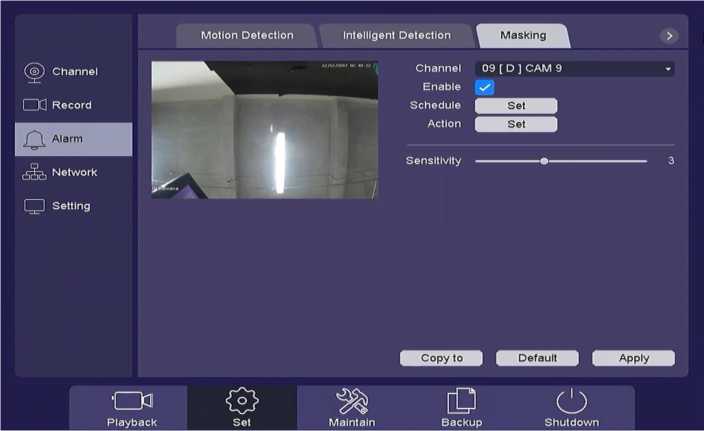
Figure 4-47 Masking
- Channel: Select the channel.
- Enable: Video masking enabled switch.
- Schedule: Set the time slot to detect video masking. You can take the setting of chapter 4.3.3.1 motion detection for reference.
- Trigger process: Set the handling action of masking detection; please take the setting of chapter 4.3.3.1 motion detection for reference.
After all the settings finished, click the button Apply to activate all the settings.
Detect video loss of a channel and take alarm response actions.
Click on the “Settings -> Alarm -> video lost “into the graphical interface.
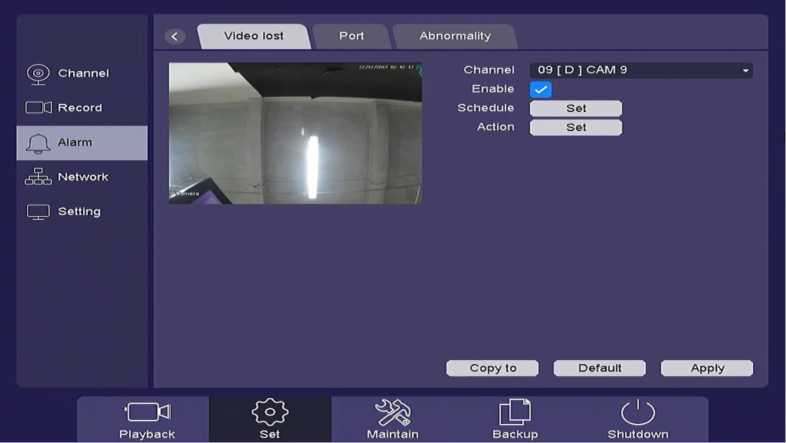
Figure 4-48 Video Loss
- Channel: Select the channel.
- Enable: Video loss enabled switch.
- Schedule: Set time slot to detect video loss.
- Trigger process: Set the handling action of video loss detection; please take the setting of chapter 4.3.3.1 motion detection for reference.
After all the settings finished, click the button Apply to activate all the settings.
Set the handling action of external sensor alarms, including alarm input and alarm output.
Click on the “Settings -> Alarm ->Port “into the graphic interface
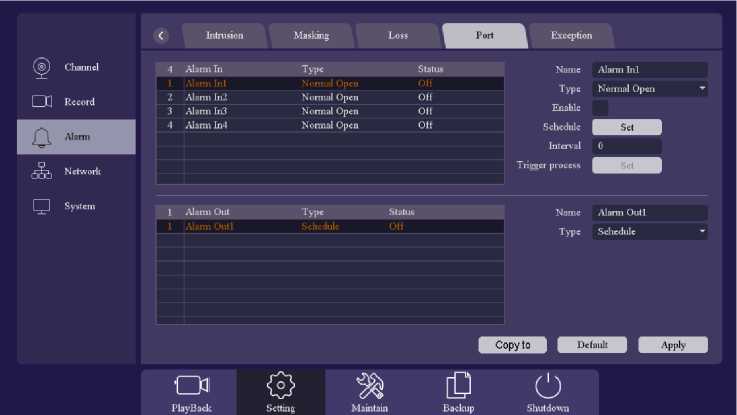
Figure 4-49 Port
Alarm input device is a kind of device which can detect the surveillance area by some sensors such as infrared sensor or temperature sensor, and when the environment is been changed, the sensor will detect information and alter the status.
- Name: Set the name of the Alarm input device.
- Type: Normal Open/Normal Close. It means the system support those external sensor alarms which have two statuses: Open and Close. When the status switches from Open -> Close, or from Close->Open, alarm will be triggered.
- Enable: Alarm in enabled switch.
- Schedule: Set time slot to detect video loss.
- Interval: Set the time interval of each Alarm in triggered.
- Trigger process: Set the handling action of alarm in detection; please take the setting of chapter 4.3.3.1 motion detection for reference.
Alarm output device is a kind of device which can output warning signal such as sound or light, to remind the user that there’s alarm are triggered.
- Name: Set the name of the Alarm output device.
- Type: Three types: Schedule/Manual/Stop. Schedule means the alarm output device will be activated when the NVR detects the alarm. Manual means the alarm output device will be activated after choosing the Manual and press the button Apply. Stop means the alarm output device is not on-guard.
After all the settings finished, click the button Apply to activate all the settings. You can also click Copy to to copy the setting to another port shown as Figure 4-47.
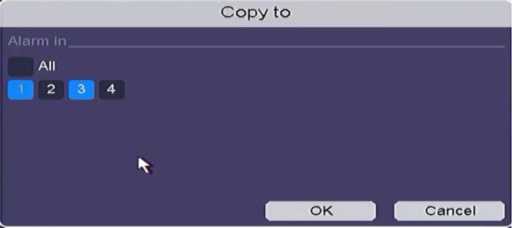
Figure 4-50 Copy to
Exception settings refer to the handling action of various exceptions, including No writable disk, Disk error, Disk no space, Network Disconnection, IP Conflicted.
Click on the “Settings -> Alarm-> Exception “into the graphical interface.
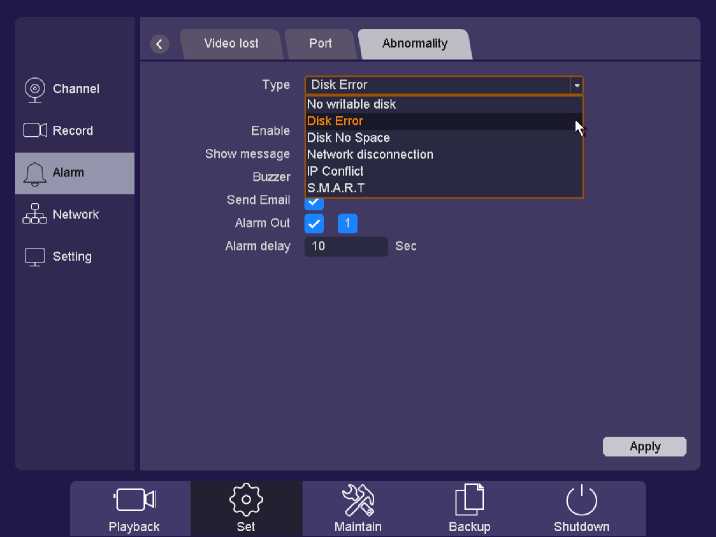
Figure 4-51 Exception Alarm
- No writable disk: If all HDD are set to only read, this exception will be triggered. It supports these methods to remind the user about the exception: Show Message, Buzzer, Send Email and Alarm Out.
- Disk Error: If writing HDD error or DHH is unformatted, this exception will be triggered. It supports these methods to remind the user about the exception: Show Message and Buzzer.
- Disk No Space: You can set minimum percentage of hard disk space. The handling actions of this exception are Show Message, Buzzer, Send Email and Alarm Out.
- Network Disconnection: If network is disconnected, this exception will be triggered. It supports these methods to remind the user about the exception: Show Message, Buzzer and Alarm out.
- IP Conflicted: Contain If IP conflict with other device at the same network, exception will be triggered. It supports these methods to remind the user about the exception: Show Message, Buzzer and Alarm out.
- S.M.A.R.T: This exception is about HDD health detection. It will be triggered when the HDD of device have some problems and not work under good condition. It supports these methods to remind the user about the exception: Show Message and Buzzer.
After all the settings finished, click the button Apply to activate all the settings.
In this chapter we can make the schedule for the record by configuring the related parameters, and before these operations, please make sure that the HDD has already been installed and formatted. If not, please install the HDD and initialize it. For detailed information, please refer to chapter: Maintain->HDD management.
Click on the “Setting ->Record ->Schedule” into the graphical interface.
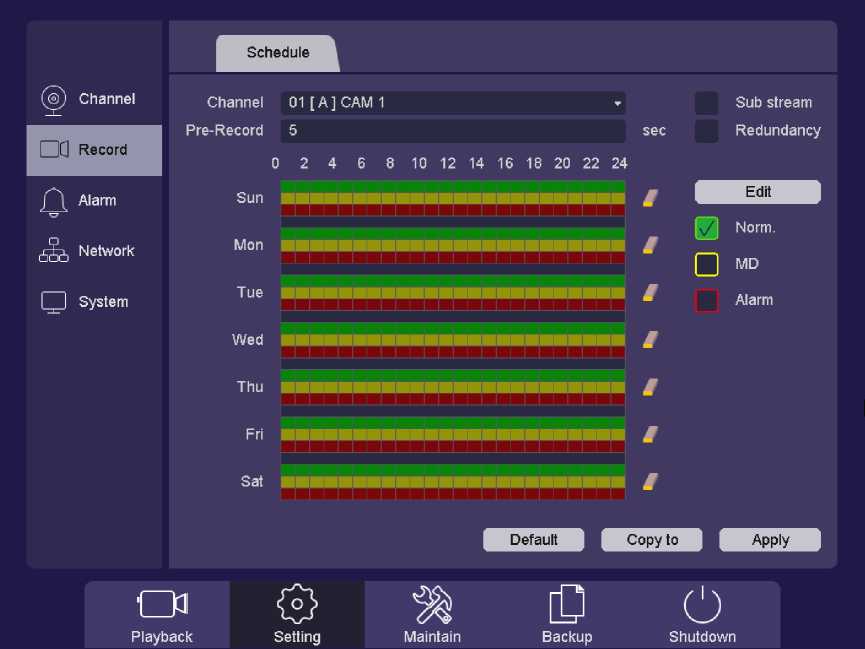
Figure 4-52 Record Plan Setting
On this schedule setting screen, we can set the record schedule for specific channels.
• Channel: Select the channel to configure
• Sub stream: To record as both main stream and sub stream. <Only some models support sub stream record>
• Pre-Record: The time to be pre-record on the created videos. Range from 0-30 seconds. Maximum 30s pre-record can be supported for each channel.
• Redundancy: The record will be backed up in redundant HDD, if there is redundant HDD device installed in the system. Please check the chapter 4.4.3 for the details.
Note:
> If there are several channels to be set with pre-record function, the pre-record time will be less than 30 seconds (the maximum value), because pre-record function will consume the system resources and it will adjust the time length to support many channels at the same time.
You can click the button Edit to enter the edit screen and set the schedule of the record.
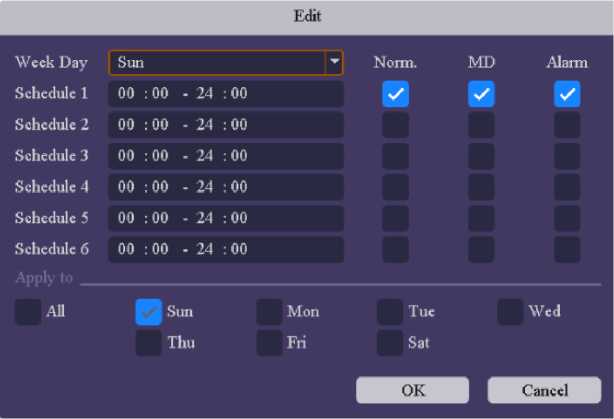
Figure 4-53 Record Plan Edit
- Week Day: The day to set the schedule, from Sunday to Saturday.
- Schedule 1-6: The time slot for the record, you can set 6 time slots during one day.
- Norm.: The type of the record, record as normal video.
- MD: The type of the record, record as motion detection video.
- Alarm: The type of the record, record as alarm video.
You can check the All to select all the week day and set the schedule at the same time, or check several of them. If Norm, MD and Alarm are checked at the same time, it will record as a priority like: Alarm > MD > Norm. That means if the three type of detection occurred at the same time, the type of the record will be set as Alarm video.
You can also edit the schedule on the configuration graph screen, as shown in Figure 4-42.
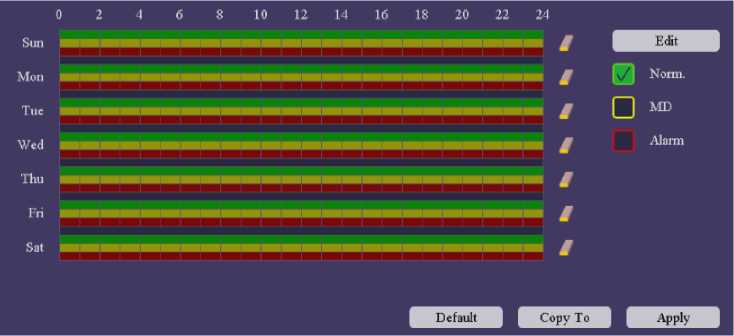
Figure 4-54 Edit graph
- By selecting the checkbox on the right we can edit the corresponding bar on the left. For example, if we check the MD, and edit the corresponding bar, we will be able to edit the yellow part of the bar.
- By clicking the icon eraser^ J , we can clear the setting of the bar at once.
After all the settings finished, click the button Apply to activate all the settings.
You can copy the current channel setting to other channels by clicking the button Copy To. As shown in Figure 4-43.
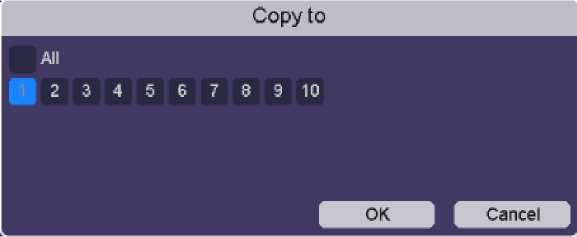
Figure 4-55 Copy To
By clicking the button Default, you can reset all the settings.
In this chapter you can do channel management. You can set channel type and protocols for each HD camera channel; also you can add the IP Cameras into the corresponding channel. Set encode, adjust the parameters of the Cameras, and set the OSD menu, privacy masking and PTZ functions. Before adding the IP Cameras to HD DVR corresponding channels, please make sure that the IP Cameras and HD DVR are in the same network, and IP Cameras are in active status.
Click on the “Setting -> Channel ->Channel type” into the graphical interface. Where you can set the channel type and set the protocol for each HD camera. Without click “OK” button to confirm it won’t work when you change the channel type.
Click on the “Setting -> Channel ->Channel type->channel set”. You can set the camera type for
turn to□. And
each channel, shown as figure 4-44, when the channel is configured, thel I will the protocol for each channel can be detected automatically and be displayed in the channel interface.
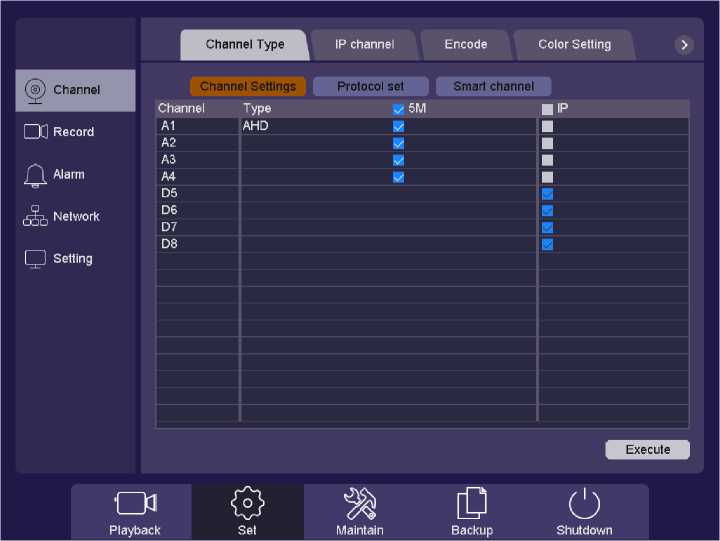
Figure 4-56 channel set
Click on the “Setting -> Channel ->Channel type->protocol set”. You can set the protocol for each HD channel, shown as figure 4-45, the HD DVR support AHD, TVI, CVI, CVBS.
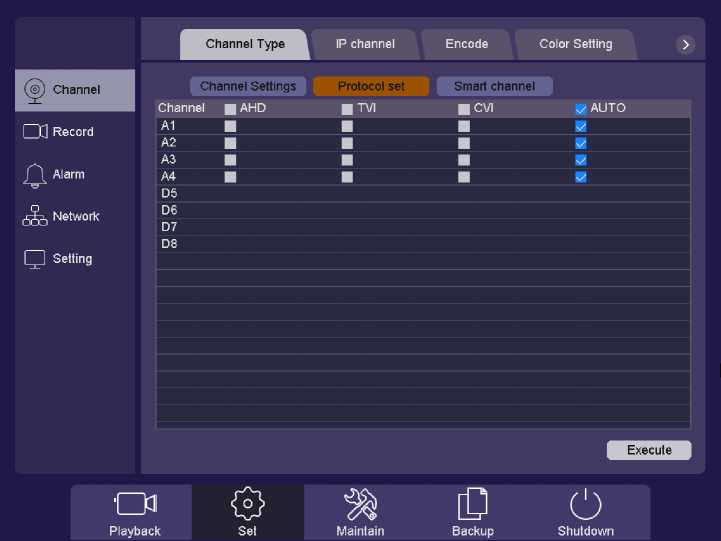
Figure 4-57 protocol set
Note:
> The HD DVR can detect AHD, TVI and CVI HD camera automatically.
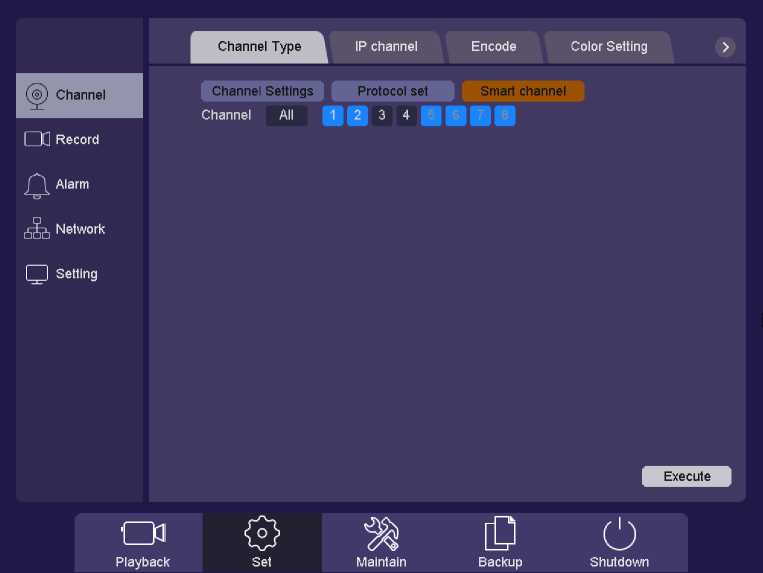
Figure 4-58 Smart channel
Here user can enable the smart channel function in channel type. Then in intelligent detection, there are two smart function types: Line Crossing & Area intrusion. User can enable them with any brand analog cameras and any video signal format. Please refer to Part 4.3.3 Alarm.
Note:
> When the setting of smart channel changed, the device will restart to take the settings into
effect.
Click on the “Setting -> Channel ->IP channel” into the graphical interface. This page also shows the information of real-time network bandwidth usage.
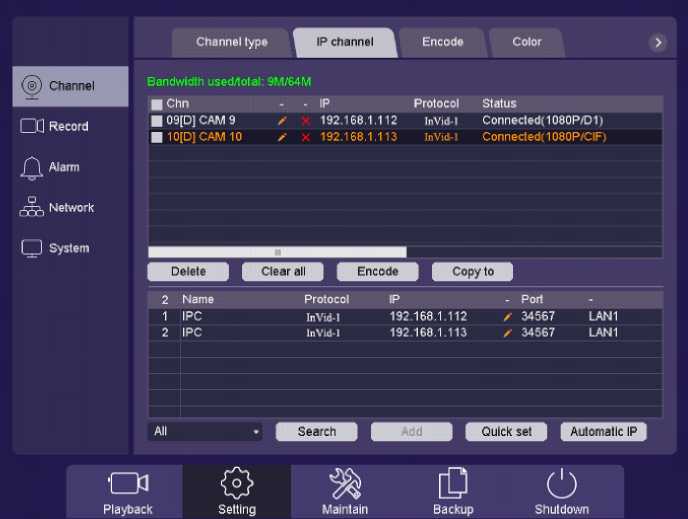
Figure 4-59 IP Channel Setting
The list above shows the channel name for each channel, IP Address, connection protocols, connection status, and includes:
- Delete: Delete the IPC highlighted. Also you can click the icon ^3 to delete the IP
camera.
- Clear All: Clear all the connected IPCs.
- Encode: Settings for the connected IPC fast encode settings. As shown in figure 4-47.
Encode For the details, please refer to chapter 4.3.5.3 Encode.
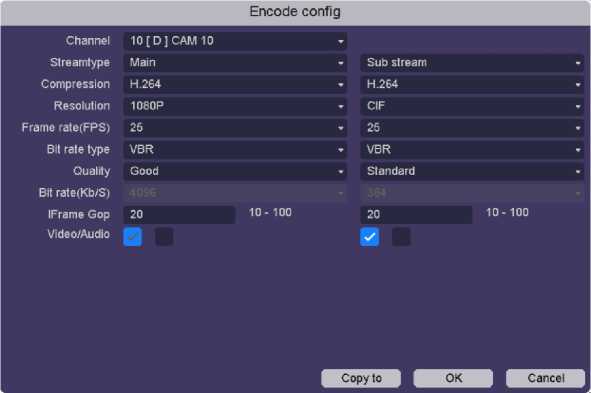
Figure 4-60 Encode Config
- Copy to: You can choose to copy some IPC Parameters to the remaining number of channels. As shown below.
Copy To
All
User Name Password Type
Device Address Protocol
Port Time sync
All
2 3 4 5 6 7 8 9 10 11 12
13 14 15 16
Exit
OK
Figure 4-61 Copy To
- Edit: Click the iconu , and enter the screen of Edit. Select channel, enter the user
name and password of the IP Camera, select the time sync type, connection protocol type, modify or add IP address, port number. As shown in figure 4-49.
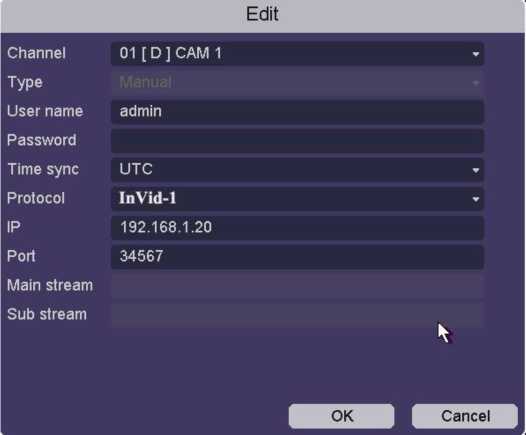
Figure 4-62 IPC Edit
Preview: Click the iconL3, and you can see a preview of the connected channel IPC.
- Upgrade: Click the icon □, and upgrade IPC connected. As shown in figure 4-50.
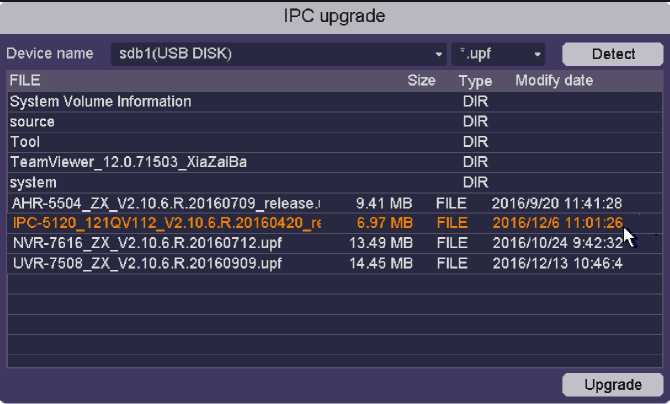
Figure 4-63 IPC upgrade
After all the settings finished, click the button Apply to activate all the settings.
This list shows the device name, type of agreement, IP Address, port number and access networks of all IP cameras that have found in the same subnet.
- Search: Scope search contains private agreements, ONVIF Protocol search and comprehensive search of both types of agreements. Click to search all of the devices under the same network segment. You can click the protocol drop box and select the corresponding protocol. Please refer to the Figure 4-51.
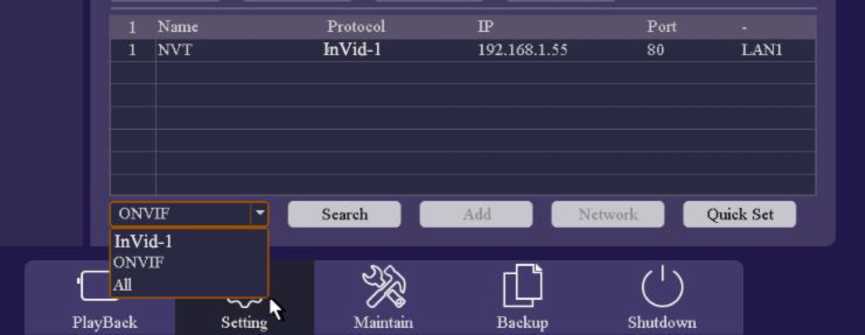
Figure 4-64 IPC Search
- Add: Device is selected click on the muscle can increase to the Edit bar and automatic connection.
- Quick Set: Click the button to add all IPCs to the digital channels automatically according to the found IP cameras list.
- Automatic IP: This operation will automatically allocate your network IPC(QVUII) IP address.
Note:
> We highly recommend you create a strong password of your own choosing in order to enhance the security of the IP Camera. And we suggest that you change your password regularly. Reset your password monthly or weekly can improve the security level of the system and protect the information security.
By configuring the encode parameters you can define the parameters which affect the image quality, such as the Compression type, Resolution, Frame Rate, Bit Rate Type, Quality, etc. The HD DVR support Dual Stream Encode, we can set the main stream encode and sub stream encode on this screen.
Click on the “Setting -> Channel -> Encode” into the graphical interface.
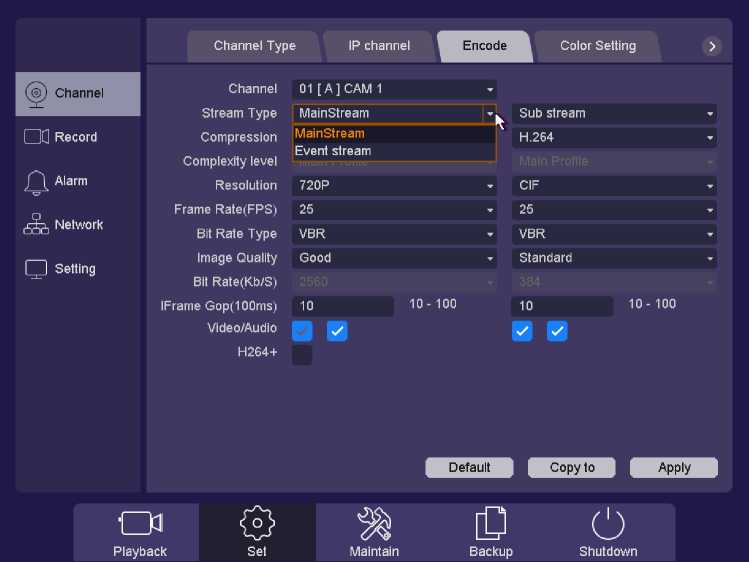
Figure 4-65 Encode
• Channel: Select the channel to configure.
• Stream Type: MainStream/SubStream/EventStream
• Compression: This is the compression protocol for encoding.
• Complexity level: Base Line/Main Profile/High Profile
• Resolution: The resolution of the encoding record.
• Frame Rate(FPS): The number of frames per second in the encoding video.
• Bit Rate Type: CBR/VBR.
• Image Quality: Lowest/Low/Standard/Good/Better/Best
- Bit Rate(Kb/s): Value of the Bandwidth
- IFrame Gop: I-frame setting, range from 10-100
- Video/Audio: To encode the Video and Audio in the record files. The video in mainstream is always enabled.
- H.264+: Enable smart encode technology, all the record file can reduce the HDD space
maximum 80%-90% in static view.
After all the setting finished, click the button Apply to activate the configuration.
You can copy the configuration of selected channels to the one which you would like to apply the same configuration. By clicking Copy To button, select the channels and save the setting. Please refer to Figure 4-53 Copy To.
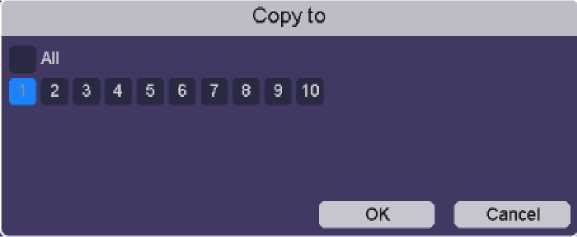
Figure 4-66 Copy To
HD cameras and IP Cameras support image adjustment such as Brightness, Contrast, Saturation, Hue and Sharpness. Some high-end IP Cameras support advanced Settings such as Day/Night setting, Exposure, NR, WDR, Defog, etc. In this chapter you can configure the IP Camera to improve the image and make a better view experience.
Click on the “Settings -> Channel ->Color “into the graphical interface.
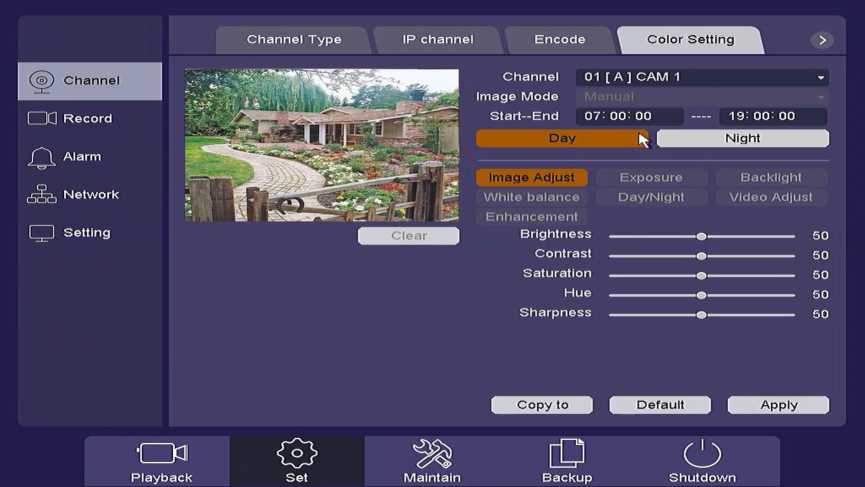
Figure 4-67 Channel Color Setting
• Channel: Select the channel to configure.
• Image Mode: The image mode for specific period of the configuration, there are Auto/Manual for options. Auto mode keeps the image settings for 24h, and Manual mode supports 2 period settings (Day period & Night period). You can set independent image settings for different period.
• Start-End: Set the image mode as Manual, then enter the starting time and ending time for Day period or Night period
You can adjust the IP Camera parameters on this screen, if the IP Camera compatible with the HD DVR.
| Functions | Parameters |
| Image Adjust | Brightnes/Contrast/Saturation/Hue/Sharpness |
| Exposure | Auto: Set exposure time automatically
Manual: Set exposure time by selecting exact value |
| Backlight | Close/DWDR/WDR
Close: function disable Limit: 0-100 Back Light Comp: when WDR disabled, BLC function can be activated |
| White balance | Auto/Manual |
| Day/Night | Auto/Color On/Color Off
Switch Type: IR Synchronous Switch Filter Time: from 0-120 seconds Smart IR:Close/manual/auto |
| Video Adjust | Close: function disable
Up down/Left right/Center: adjust the image by reversing Rotate: Off/90° /180° /270° |
| Enhancement | NRLevel:0-6
Defog: Close: function disable |
| Auto: defog automatically
Manual: adjust the effect manually 0-100 Smart Light: Close: function disable Auto: the light will be trigged by smart analyze function when linked, 0-100 Manual: the light will be turned on manually, 0-100 |
Table 4-4 IP Camera advanced setting
You can configure the OSD (On-screen Display) settings for the camera, including Channel Name, Date/Time format, Record status, Alarm status, etc.
Click on the “Setting -> Channel ->OSD “Into the graphical interface.
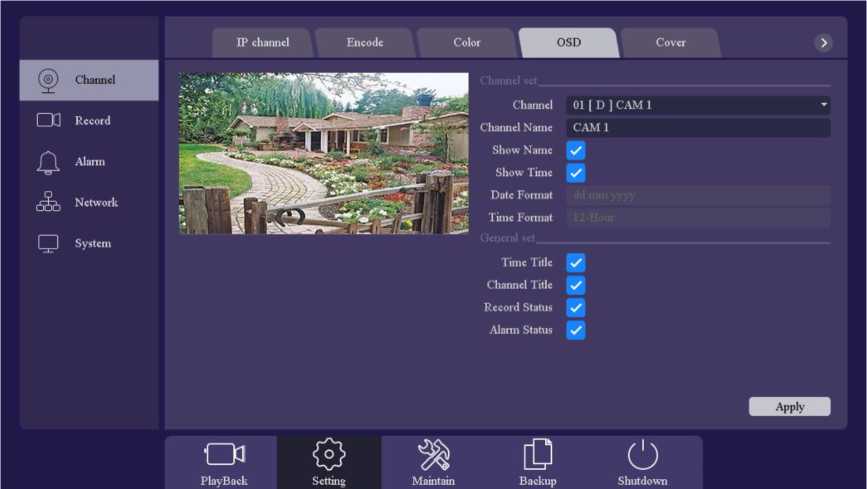
Figure 4-68 OSD Setting
There are two parts for the setting: Channel Set and General Set. For Channel Set, you can configure the following items:
• Channel: Select the channel to configure.
• Channel Name: The name of the channel to be set.
• Show Name, Show Time: Enable the information of channel name and time on the screen.
• Date Format, Time Format: Set the format of the date and time.
For the General Set you can configure the following items:
• Time Title, Channel Title: Enable/disable the display of the time tile and channel title on the monitor screen.
• Record Status, Alarm Status: Enable/disable the display of the record status and alarm status on the screen.
After all the setting finished, click the button Apply to activate the configuration.
You are allowed to configure the four-sided privacy mask zones that cannot be viewed by the operator. The privacy mask can prevent certain surveillance areas to be viewed or recorded.
Click on the “Settings -> Channel ->Cover “Into the graphical interface.
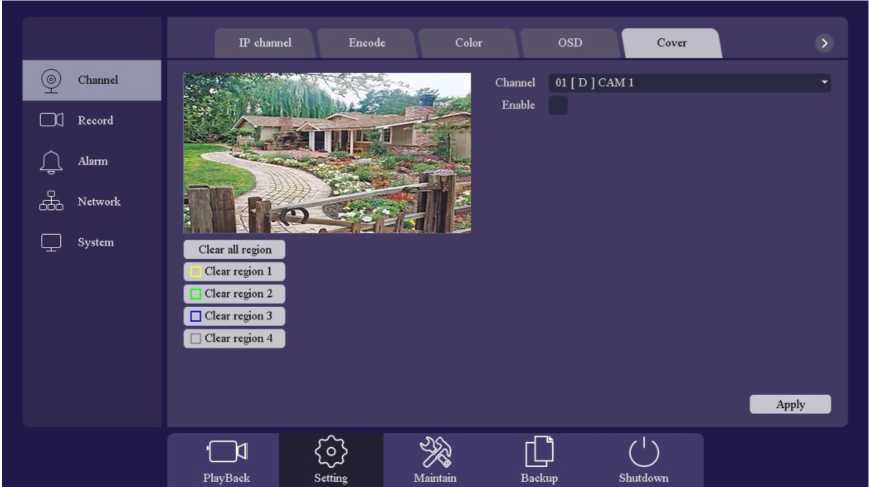
Figure 4-69 Channel Cover Setting
- Channel: Select the channel to configure.
- Enable: Check the box to enable the feature.
Use the mouse to draw a zone on the window. The zones will be marked with different frame colors. Up to 4 privacy masks zones can be configured and the size of each area can be adjusted. The configured privacy mask zones on the window can be cleared by clicking the corresponding Clear Region button with different colors on the bottom side of the preview window, or click Clear All Region to clear all regions. Please refer to Figure 4-57.
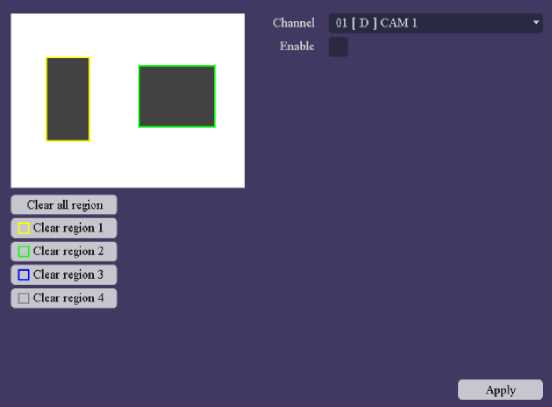
Figure 4-70 Draw mask zone
After all the setting finished, click the button Apply to activate the configuration.
This chapter is to show you how to set the actions which you want the PTZ Camera to respond when corresponding alarm occurred. Please make sure that the presets, patrols and patterns should be supported by PTZ protocols.
Click on the “Setting -> Channel ->PTZ “Into the graphical interface.
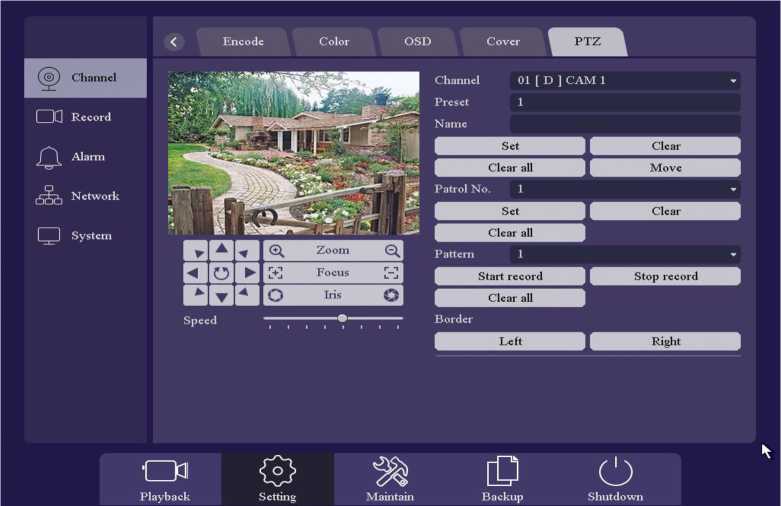
Figure 4-71 PTZ Setting
• Preset: This feature enables the camera to point to a specified position such as a
window when an event takes place. You can set up to 255 preset points. You can go to
preset by UTC control in PTZ.
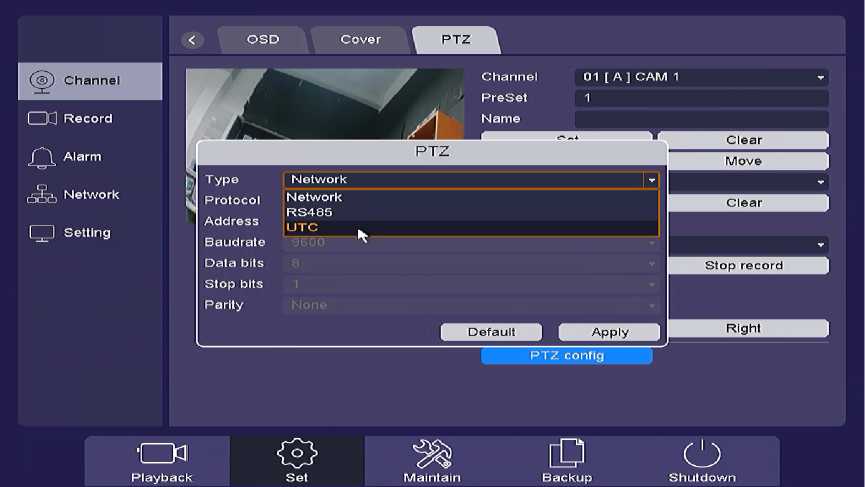
• Patrol: Patrols can be set to move the PTZ to different key points and have it stay there
for a set duration before moving on to the next key point. The key points are corresponding to the presets. You can set up 4 cruise lines, each cruise line includes preset points and the time stayed in the preset point and cruising speed. Please refer to Figure 4-72.
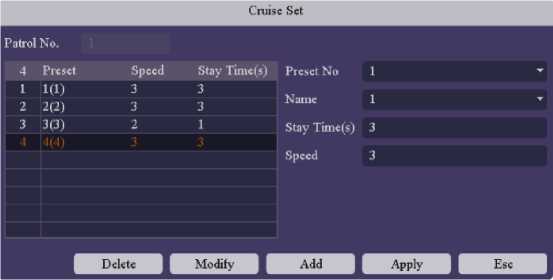
Figure 4-72 Patrol Setting
- Pattern: Patterns can be set by recording the movement of the PTZ. You can call the pattern to make the PTZ movement according to the predefined path.
- Border: Linear boundaries Including Left and right boundaries.
- Speed: Set the speed of the PTZ movement.
| Items | Function Description |
| Direction button and the auto-cycle button | |
| (t^ Zoom | Zoom+, Zoom- |
| [+] Focus | Focus+, Focus- |
| O Iris O | Iris+, Iris- |
| r r ‘ | The speed of the PTZ movement |
Table 4-5 Description of PTZ Control Icons
| Items | Function Description | ||
| [ I | System | Check the version of the device, upgrade device, check
channels/record/alarm status and PoE power info, manage online users |
|
| Network | Check base settings of network, and network transmission info of LAN port | ||
| HDD | Manage the base and advanced settings of HDD, and check HDD self-test results | ||
| El r
■OBConfig |
Backup parameters of device, and restore defaults | ||
| -rt-r | Log | Search the operations log of device | |
Table 4-6 Control Panel description
Click on the “Maintain –> System -> Version” into the graphical interface.
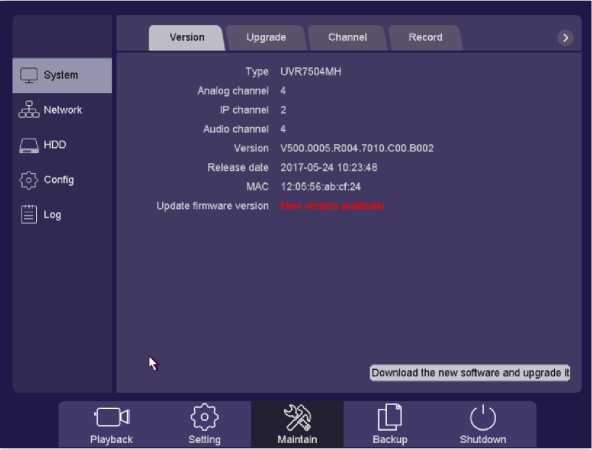
Figure 4-73 Version of Software
- Analog channel: The number of HD camera channels by default.
- IP channel: The number of IP camera channels by default.
- Audio channel: The number of Audio input channels.
- Version: A version tag.
- Release date: The release date of the Firmware.
- MAC: The Mac address of HD DVR.
- Update firmware version: Make sure network connection is good. You can manually check if there is new version FW in cloud server by just check “Version” page in GUI. If we update our FWs, you will be remind like below way. By click OK confirm, device will download the new FW and upgrade by itself automatically.
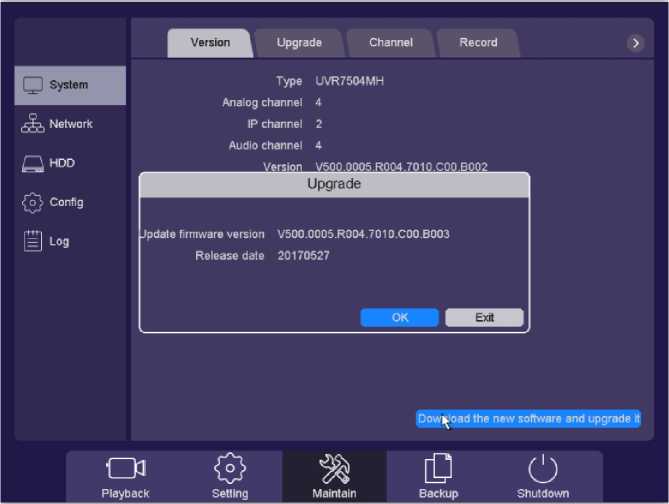
Figure 4-74 Cloud Upgrade Check
Click on the “Maintain –> System ->Upgrade” into the graphical interface. On this page you can upgrade your device by use USB flash disk.
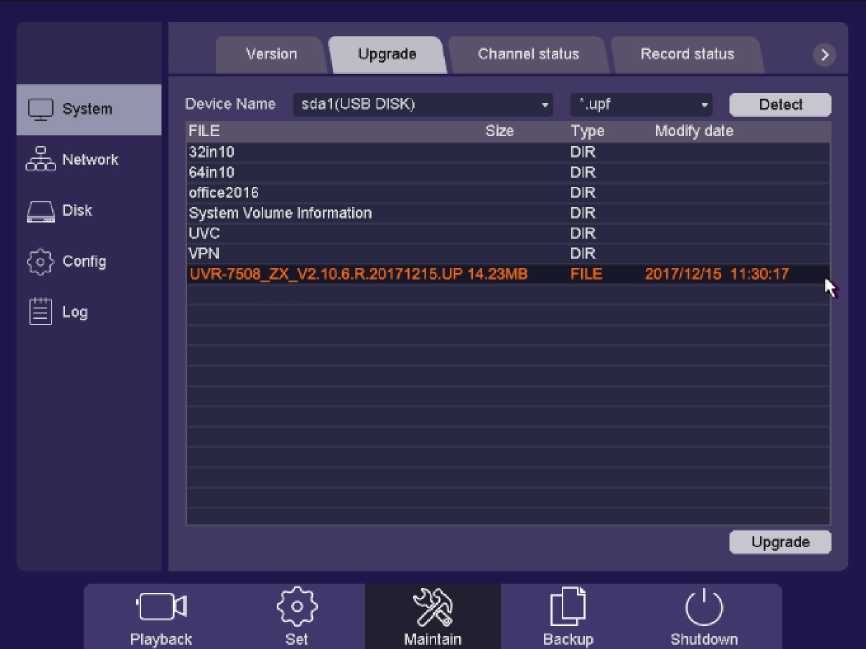
Figure 4-75 Upgrades HD DVR
- Detect: Manually detect the USB flash disk on this device.
- Upgrade: Select the correct file and click the “upgrade” button to upgrade the device, then click “ok” button to reboot the device after upgrade successfully.
Note:
> You will be asked to format HDD in order to enjoy new version FW which support many smart functions.
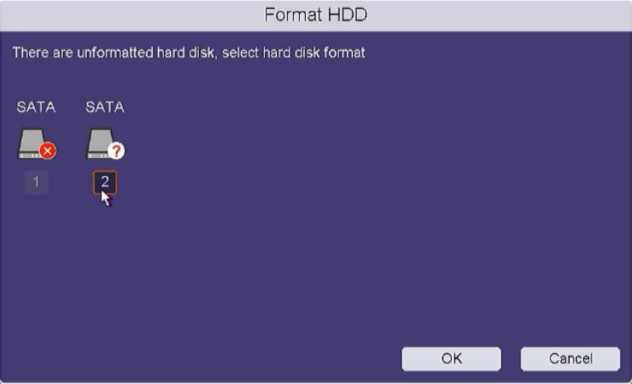
Figure 4-76 Format HDD
Click on the “Maintain –> System -> Channel Status” into the graphical interface.
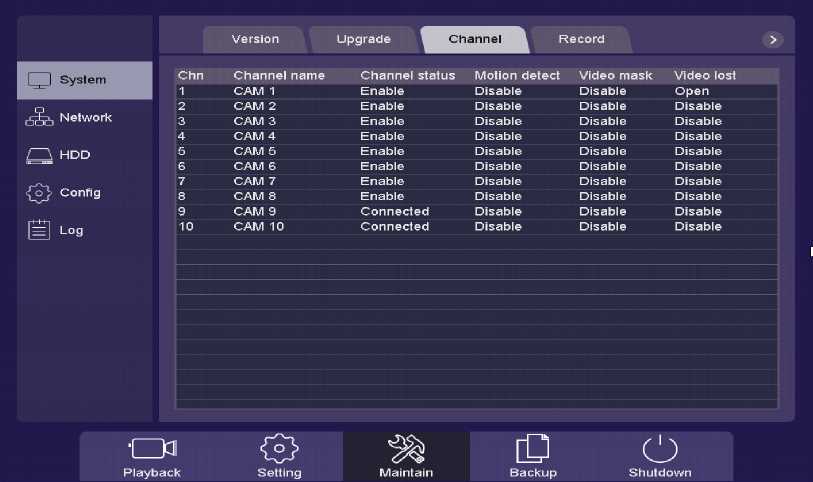
Figure 4-77 Channel Status
On this page you can check all the HD and IP channel status and the status of alarm occur include motion detect, video mask and video lost.
Click on the “Maintain –> System -> Record Status” into the graphical interface.
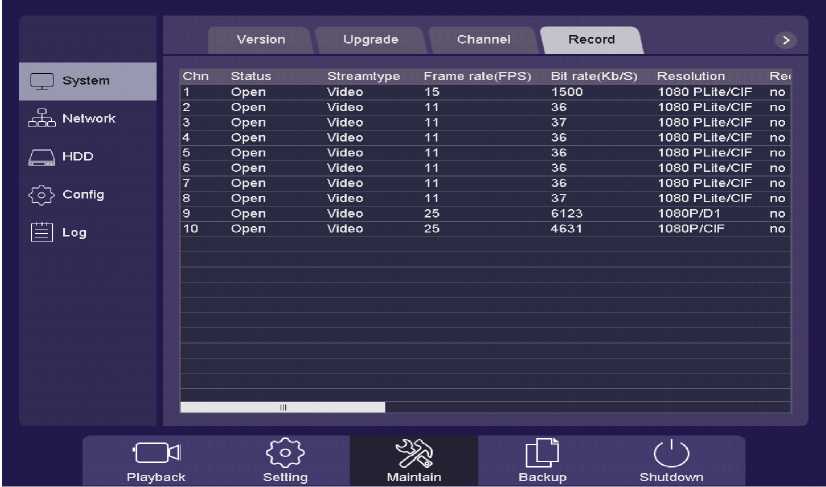
Figure 4-78 Channel Record Status
On this page you can check all the channels record status, open or stop; stream type, frame/bite rate of channels stream; main/sub resolution of each channel; and whether open the redundancy function or not.
Click on the “Maintain –> System -> Alarm Status” into the graphical interface.
Alarm status
Online User
( ] System Info
■QSS2E2EESM WdJi’.ii.iJ.w.hiiMM
40 Log Time
Disk
8
9
10
12
13
14
15
16
18
19
20
17-12-08 16:09:24
17-12-08 16:08:23
17-12-08 16:07:43
17-12-08 16:07:43
17-12-08 16:07:33
17-12-08 16:07:33
17-12-08 16:07:29
17-12-08 16:06:56
17-12-08 16:06:47
17-12-08 16:06:40
17-12-08 16:06:29
17-12-08 16:06:25
17-12-08 16:06:15
17-12-08 16:06:12
17-12-08 16:05:38
17-12-08 15:55:36
17-12-08 15:55:19
17-12-08 15:55:18
17-12-08 15:55:15
17-12-08 15:50:41
Event
Motion detect:1
Area Intrusion Alarm: 1(1)
Motion detect:1
Line Crossing Alarm:1(1)
Motion detect:1
Area Intrusion Alarm:1(1) Motion detect:1
Area Intrusion Alarm:1(1)
Area Intrusion Alarm:1(1)
Area Intrusion Alarm:1(1)
Area Intrusion Alarm:1(1)
Area Intrusion Alarm:1(1)
Area Intrusion Alarm:1(1)
Area Intrusion Alarm:1(1)
Area Intrusion Alarm:1(1)
Area Intrusion Alarm: 1(1)
Area Intrusion Alarm:1(1)
Area Intrusion Alarm:1(1)
Area Intrusion Alarm:1(1)
Area Intrusion Alarm:1(1)
00000000000
Playback
Set
Maintain
Backup
Shutdown
Figure 4-79 Alarm Status
On this page you can check all the alarm status according to Input/Output or Alarm. Detailed information can be displayed and provide fast locate alarm video.
Click on the “Maintain –> System -> Online Users” into the graphical interface.
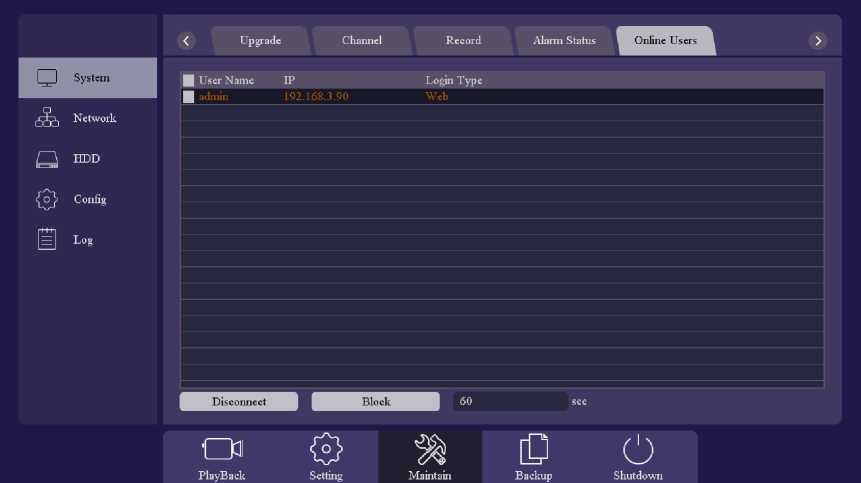
Figure 4-80 Online Users
- User Name: Remote device login this HD DVR device account.
- IP: User remote access devices IP Address.
- Login Type: Remote connection type.
- Disconnect: Disconnect the connected user, and disconnected users will reconnect
automatically in a while.
- Block: Shielding the connected user in a time that you set, and remote user will reconnect in that time, the maximum value is 65535 seconds.
Click on the “Maintain –> Network -> Base” into the graphical interface.
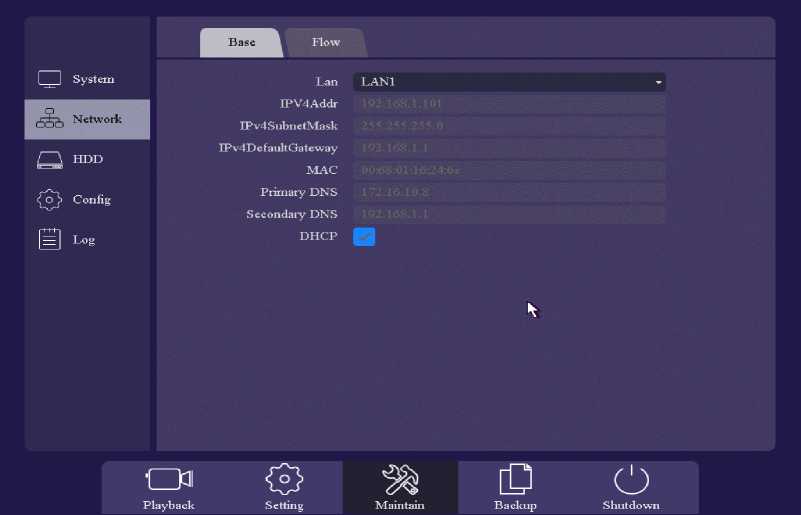
Figure 4-81 Interface of Check Base Network
This page shows device network parameters, and DHCP enable status.
Click on the “Maintain –> Network ->Flow” into the graphical interface.
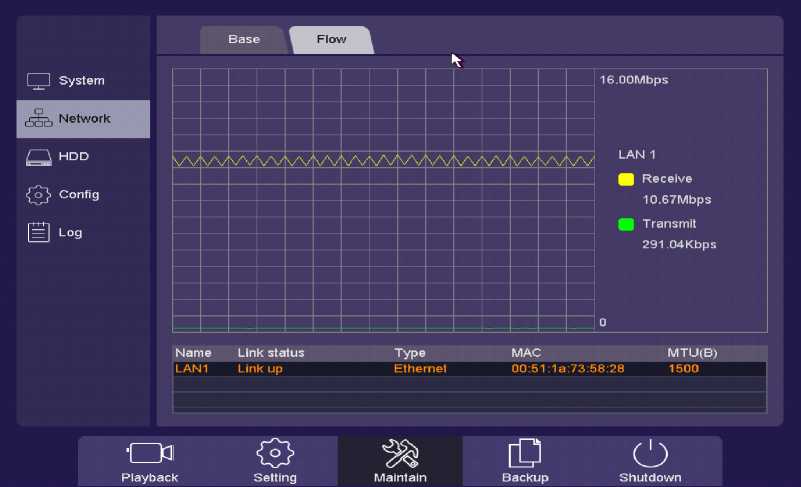
Figure 4-82 Flow of Network
- Receive: Shows the bit rate that HD DVR device received in real-time.
- Transmit: Shows the bit rate that HD DVR device transmit in real-time.
Click on the “Maintain –> HDD -> Base” into the graphical interface.
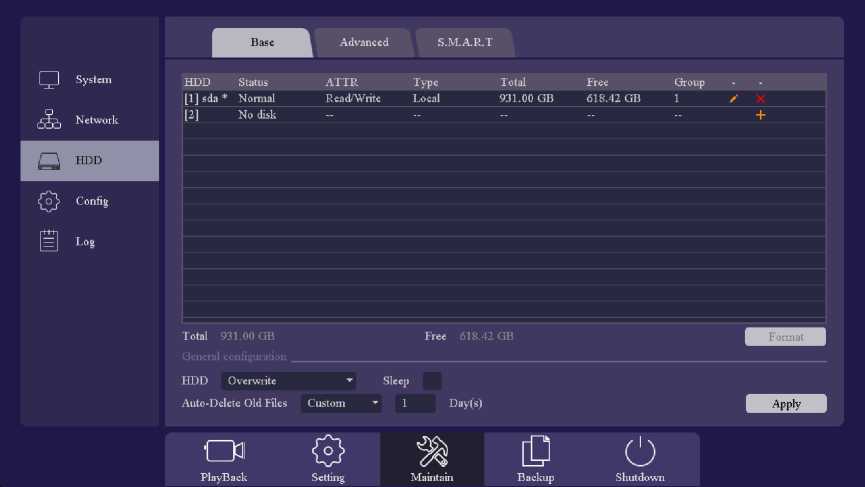
Figure 4-83 Base Setting of HDD
This page displays your device is plugged into the hard disk status, hard drive serial number, name, attributes, the type of hard drive, the total capacity / Remaining capacity, as well as belonging to a group, edit button and uninstall / Loaded button.
- HDD: Shows HDD serial number, “[1]sda” or”[2]sdb”.
- Status: Shows the state of HDD, “Unformatted” or “normal” or “no disk”.
- ATTR: HDD have Three types of ATTR, “Read/Write”, ”Read only”, “Redundant”.
- Type: Shows HDD connection type.
- Total: Size of the HDD total capacity.
- Free: Shows HDD remaining capacity size.
- Group: Shows which group the HDD belonged.
- Uninstall: Uninstall HDD.
- Add: Add the HDD from uninstall state.
- Format: Format the HDD manually.
- HDD: You can set the full strategy of hard disk, “stop” or “overwrite”.
- Auto-Delete Old Files: Support two mode of strategy, “never” and “Custom”. In the “Custom” mode you can set auto-delete time from 1-30 days before.
- Sleep: Open this function, your HDD will smart sleep when it not be used.
- Apply: Make sure all the operations effect.
Click HDD the set button, interface shows as below.
Figure 4-84 Edit of HDD
On this page you can set HDD parameters, including ATTR and Group. Note:
> Every HDD only can be set to one group in the same time.
Click on the “Maintain –> HDD -> Advanced” into the graphical interface.
Figure 4-85 Advanced Setting of HDD
This page you can switch the hard disk’s storage mode, including the “group”, “quotas (Capacity)”, and “Quota (Time)”. Change the storage mode requires that you restart the HD DVR device.
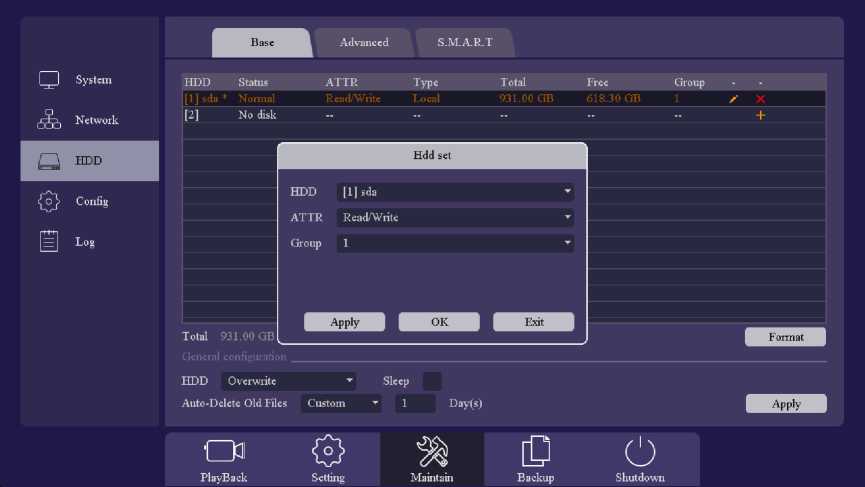
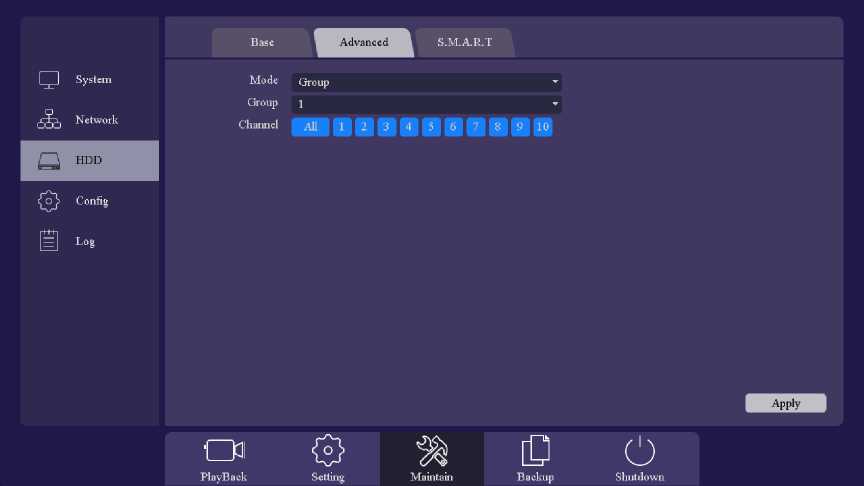
i. Group: You can set 16 groups under group mode, and each channel is independent of
each group. If the channel do not belong to any group, none video file will saved, and if the channel belong to more than one group, the channel will used the space of these group one by one until all the group are full.
Note:
> Apply a new storage mode need restart the HD DVR device.
ii. Quota (Capacity): The quota of capacity mode support set disk space for every channel
manually.
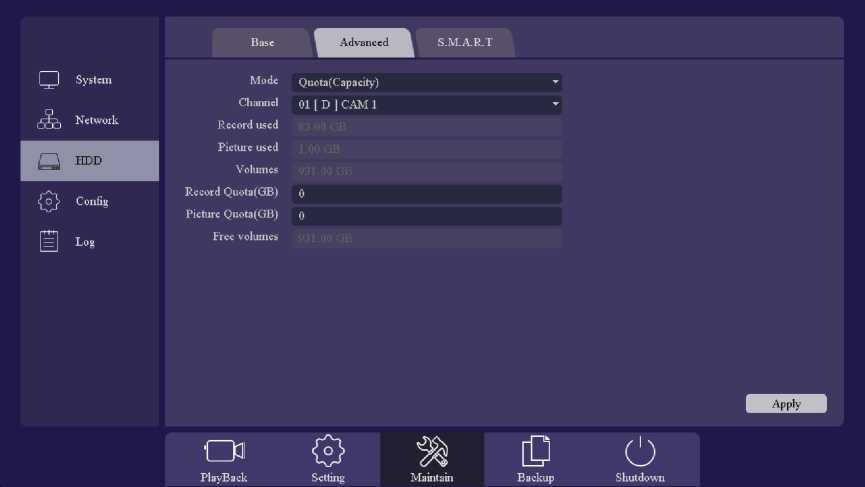
Figure 4-86 Quota of Capacity Mode
• Record used: Shows the video files space that the channel you chosen has used in real-time.
• Picture used: Shows the pictures space that the channel you chose have used in real-time.
• Volumes: Total capacity of all hard drives.
• Record Quota: You can manually set the quota size of channel video.
• Picture quota: You can manually set the quota size of channel picture.
• Free volumes: Shows the free space minus the space you have set on other channels.
iii. Quota (Time): The quota of time mode supports set time for every channel manually.
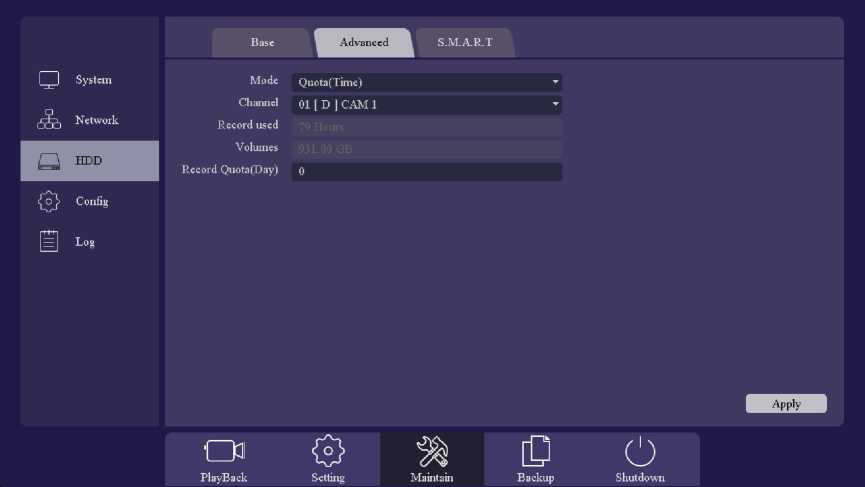
Figure 4-87 Quota of Time Mode
- Record used: Shows the video files space that the channel you chose has used in
real-time.
- Volumes: Total capacity of all hard drives.
- Record Quota (Day): Set a time for a channel from 0-60 days, and the new video files
will not cover the old files in the time period.
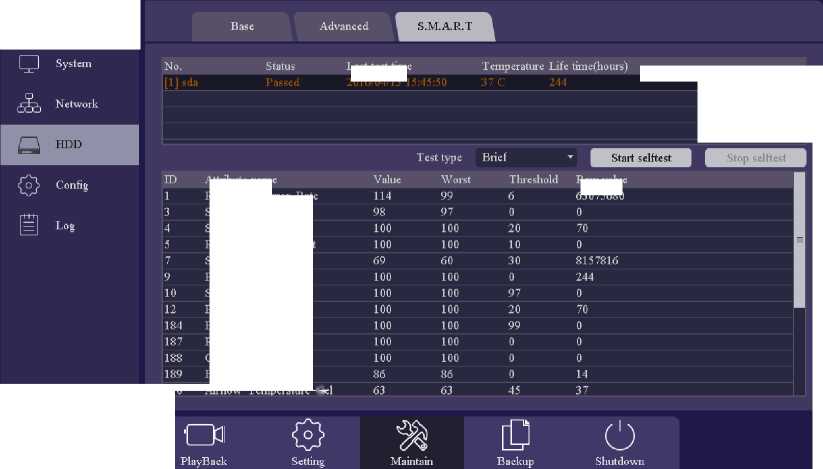
Attribute name
Raw_Read_Error_Rate Spin_Up_Time
StartStopC ount
Reallocated_Sector_Ct Seek_Error_Rate Po wer_On_Hours Spin_R etry_C o unt
PowerCycleCount
End-to-End_Etror Reported_Uncorrect CommandTimeout
High_Fly_Writes
190 Airflow Temperature Cel
Raw value 63075680
Last test time 2016/04/13 15:45:50
Click on the “Maintain –> HDD -> S.M.A.R.T” into the graphical interface.
Figure 4-88 Check HDD Status
- NO.: Hard disk serial number.
- Status: Shows HDD self-test status and results.
- Last test time: The last time you test HDD.
- Temperature: Shows HDD temperature in real-time.
- Life time (hours): Shows how long the time have you used this HDD.
Note:
> We provide two type of self-test, brief and extended. Extended type will be taking a little
longer time than brief type. And you can stop while it’s been self-testing if you want.
Click on the “Maintain –>Config ->Backup” into the graphical interface.
On this page you can backup device parameters into USB flash disk.
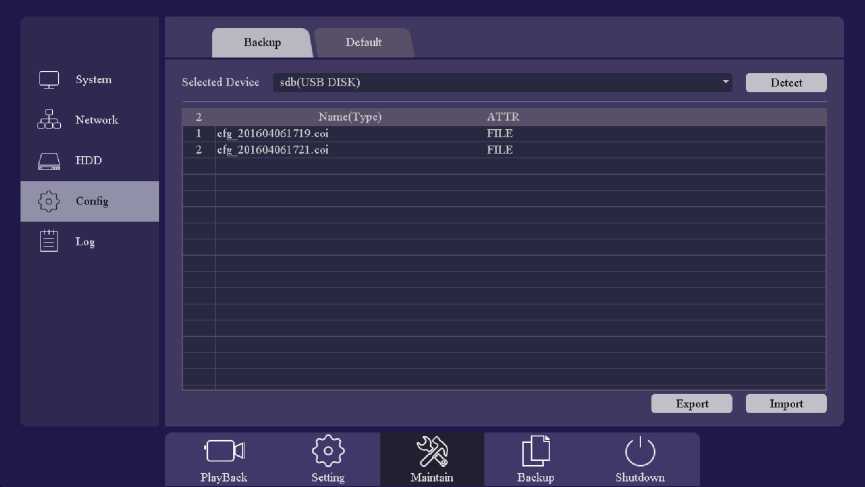
Figure 4-89 Backup Setting Status
- Detect: Detect the USB device.
- Name (type): File name and file type, and the backup file is “.coi” type.
- ATTR: Shows the file type.
- Export: Export the parameters backup file into USB disk.
- Import: Choose the backup file and click import button, your device parameters will
change into the new one.
Click on the “Maintain –>Config ->Default “enter the graphic interface.
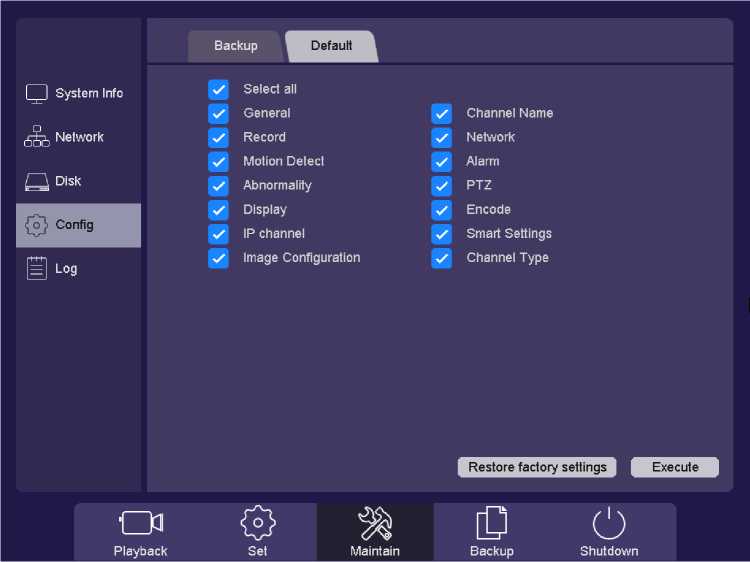
Figure 4-90 Default
On this page you can choose the function item, General/Channel Name/Record/Network/Motion Detect/PTZ/ Abnormality /Encode/Display/Channel type/IP channel/Image Setting, and after click execute button, the item what you chosen restore defaults. And you can also select the “select all” button, all the items will be selected. When the operation finish a hint will be displayed at the interface shown as figure 4-84. You can also click Restore factory settings button to restore all settings to factory.
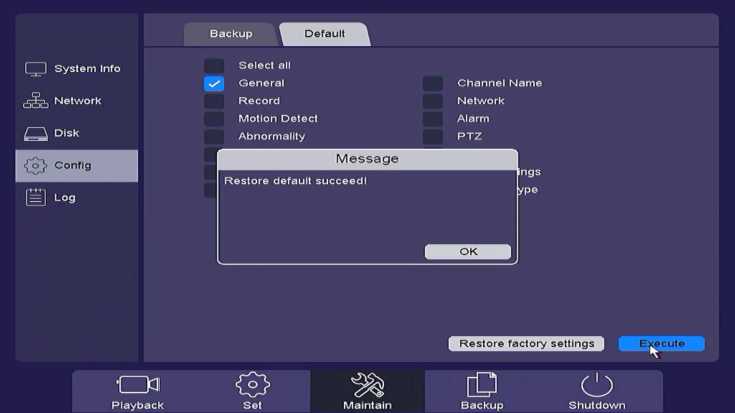
Figure 4-91 Restore default succeed hint
Note:
> UVR will restart when you choose restore factory settings automatically.
Click on the “Maintain –> Log “into the graphical interface.
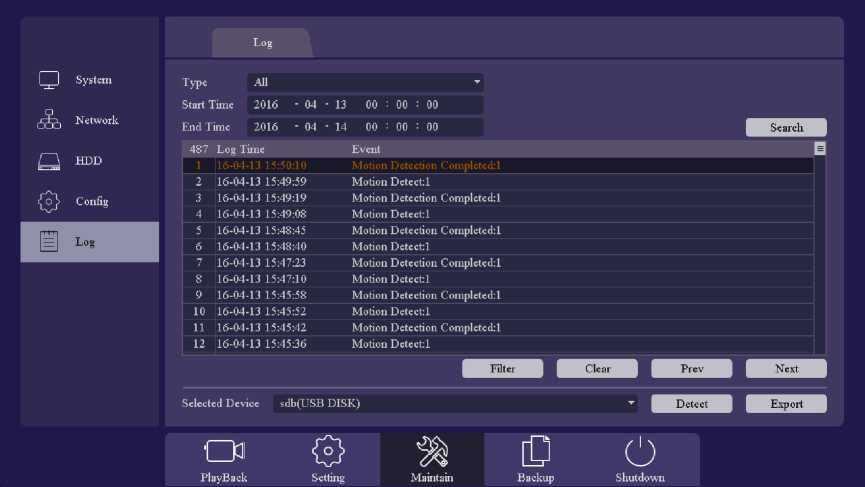
Figure 4-92 Search System Log
You can check device operation log on this page.
- Type: Search type include “System”, “Config”, “Storage”, “Alarm”, “Record”, “Account”, ”Clear”, ”Playback”.
- Start time/End time: Set the period of time you want to search.
- Search: After you set the time period and search type, click the search button, and device can save 4096 logs tops.
- Prev/Next: It can shows 1000 logs in one page, and you can check on more by click “Prev/Next” button.
- Clear: Delete all log information.
- Filter: On this page you can chose whether cover the log when it’s full, and decide which type operation log you want to save.
- Detect: Detect the USB device.
- Export: Export the operations log into the USB flash disk.
Click the backup button, enter the backup interface.
- Detect: Detect the USB flash disk device you have access to the HD DVR.
- Format: Format the USB device.
Click on “Backup ->General -> Video” into the graphical interface.
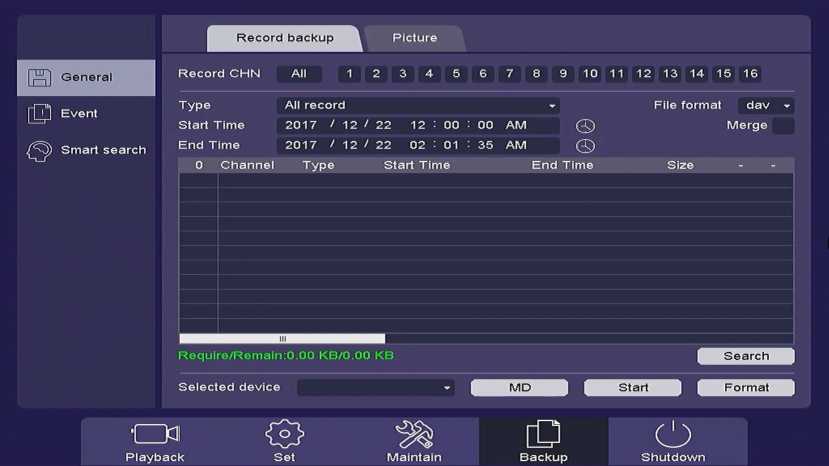
Figure 4-93 Backup General Video File
How to backup the record:
- Chose the record channel;
- Chose the video file type, including “All Record”, “Event Record”, “Timing Record”, “Manual Record” four types. And DAV/AVI two file formats.
- Set the time period you want check, and click on the search button. And search results column shows on the middle area. On this area you should chose the serial number of the backup file you need.
- Check on the “Require/Remain” bar, make sure the required space smaller than your USB device. And click start button to start backup.
Note:
> The file status marked red as search result shows is the file you locked in the playback interface. In case the file that you’re interesting covered by new files.
Click on “Backup ->General ->Picture” into the graphical interface.
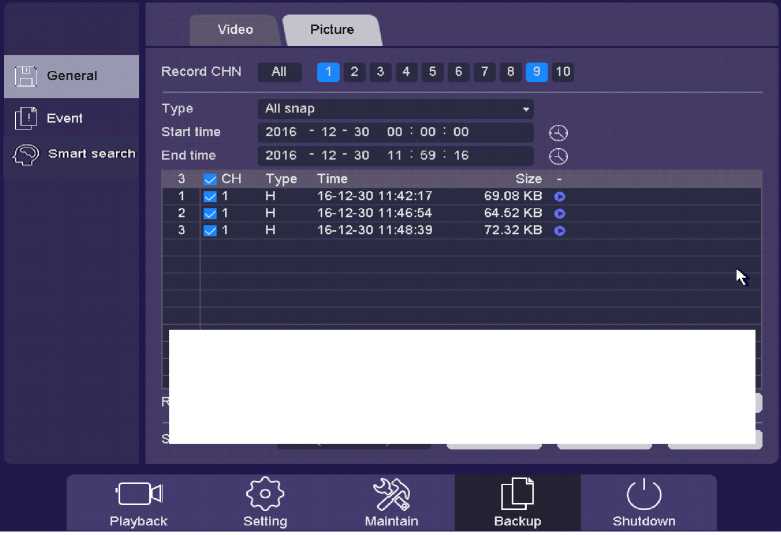

Figure 4-94 Backup Pictures
The operations of backup pictures is the same as videos, please refer to the previous part.
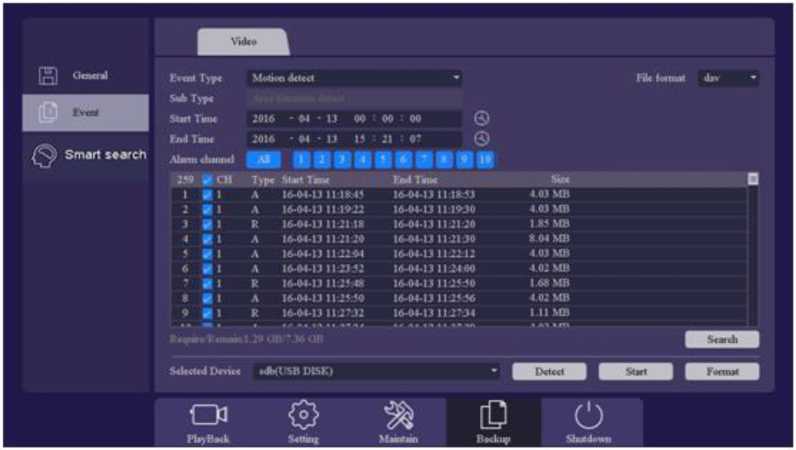
Click on “Backup -> Event-> Video “into the graphical interface.
Figure 4-95 Backup Event Video File
This page you can check the event video, and there are three event types, include “Alarm input”, “Motion detect”, ”IA Detect”. And “IA Detect” contains two sub types “Crossing detect” and “Area intrusion detect”.
- Set search time period, and channels you’re interesting.
- Click on the button of search. And search results shows on the middle area. On this area you should chose the serial number of the backup file you need. And DAV/AVI two file formats.
- Check on the “Require/Remain” bar, make sure the required space smaller than your USB device. And click start button to start backup.
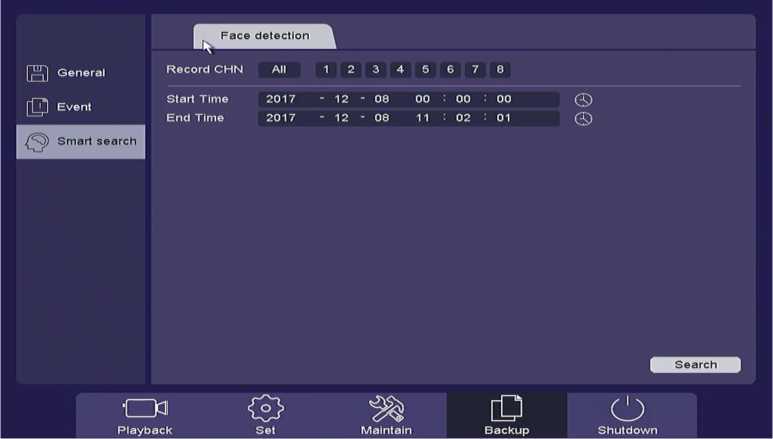
Figure 4-96 Smart Search
In this GUI you can search all the face detection information for convenience backup. First you should select a channel or all the channels, second specify the start time and end time, then click search button, Face detection results can be shown as below;
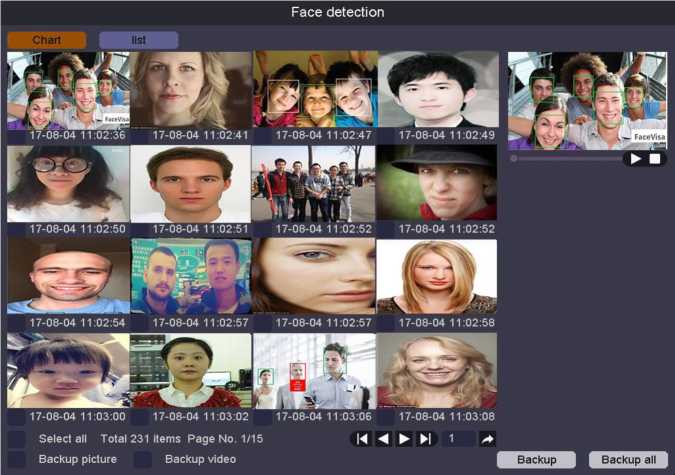
Figure 4-97 Face Detection search result
Then you can select the video section or picture you want to backup them to your flash disk by USB.
Right click and select the “Record Playback” to enter the playback interface and you can also click on the playback button in the main menu to enter the playback interface, as shown in the figure-76.
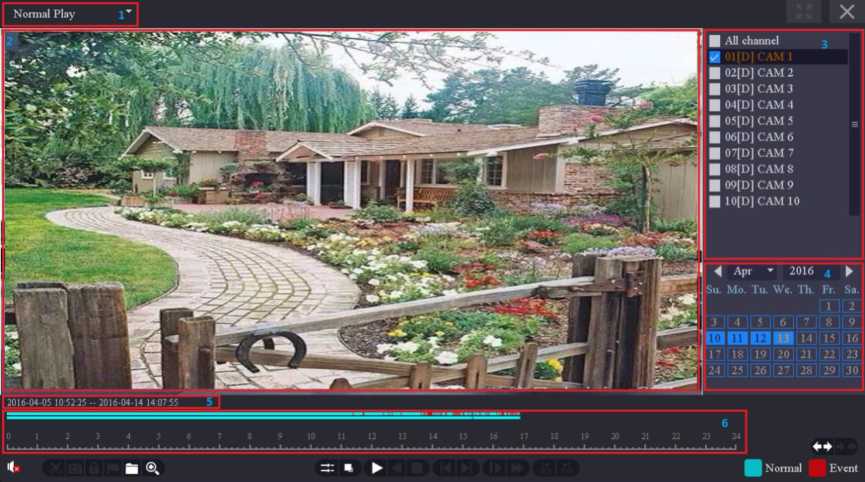
Figure 4-98 Main Interface of Playback
| No. | Items | Function |
| 1 | Playback Type | HD DVR support four types playback mode “Normal Play”, “Event Play”, “Label Play”, “Time Division Play”, “Normal Play (Picture)” |
| 2 | Display | The windows display videos |
| 3 | Channels | You can select the channels for playback in this area |
| 4 | Date | Shows the date that have video files and marked blue |
| 5 | Time of File | Shows the start time and the end time of files in HDD |
| 6 | Time Line | Shows files playing course in this area. |
Table 4-7 Area Functions Introduce of Playback
Note:
> The second line shows all the files of the channels you selected. And the first line shows the files of the channel you chose by mouse on the display area. And event files marked red, normal files marked blue.
| No. | Key title | Key function | ||
| 1 | * * r * | Full screen playback the channels | ||
| 2 | Close the playback interface back to preview interface | |||
| 3 | S3/EZ3 | Change time line interval | |||
| 4 | KU | Switch of playback channel audio | |||
| 5 | E/E3 | Cut the interest video of playing channel | |||
| 6 | Snap a picture of playing channel | ||||
| 7 | EJ | Lock the file in case over written in HDD | |||
| 8 | □ | Default label, Label the file | |||
| 9 | □ | File manager, Mange the cut file/locked file/labeled file | |||
| 10 | El | Zoom, Zoom the playing channel | |||
| 11 | ^3/H | Sync/Async, Switch button of playback mode | |||
| 12 | El | ■h | Main/Sub Stream, Switch button of stream type | ||
| 13 | □ | Start/Pause, Control button of start/pause playback | |||
| 14 | □ | Backward Playback/Pause, Control button of backward playback | |||
| 15 | □ | Stop Playing, Control button of stop playback | |||
| 16 | d/Q| | Frame Control, Control step frame and backward frame | |||
| 17 | !► | Slow playback, slow down play speed of playing channels | |||
| 18 | T | Speed up, speed up playing channels | |||
| 19 | H 3DS | 1 H
30S |
Forward/Backward 30 sec, forward/backward 30sec playing channel | ||
| 20 | Normal record, file color marked the file type, green means normal | ||||
| 21 | Event record, event record marked red | ||||
Table 4-8 Buttons of Playback Interface
Note:
> The HD DVR device supports five types of playback.
The default playback mode is “Normal playback”. And when you select the channels the date will turn into blue on the date area that means the channels you selected have files in that day. And you can select the date you want to playback on the date area.
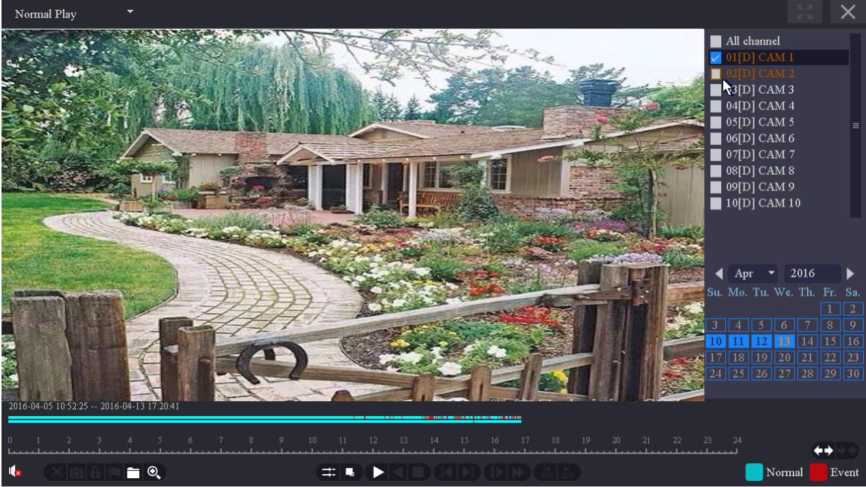
Figure 4-99 Normal Playback Modes
This HD DVR device support 16 channels playback. And 6 channels playback in real-time the other 10 channels playback in key frame.
All the operations of these buttons to control the playback, you can refer to the previous table. And the “Cut” button will cut all the files of the channels you’re playing, you can check the files you cut in the “File Manage”.
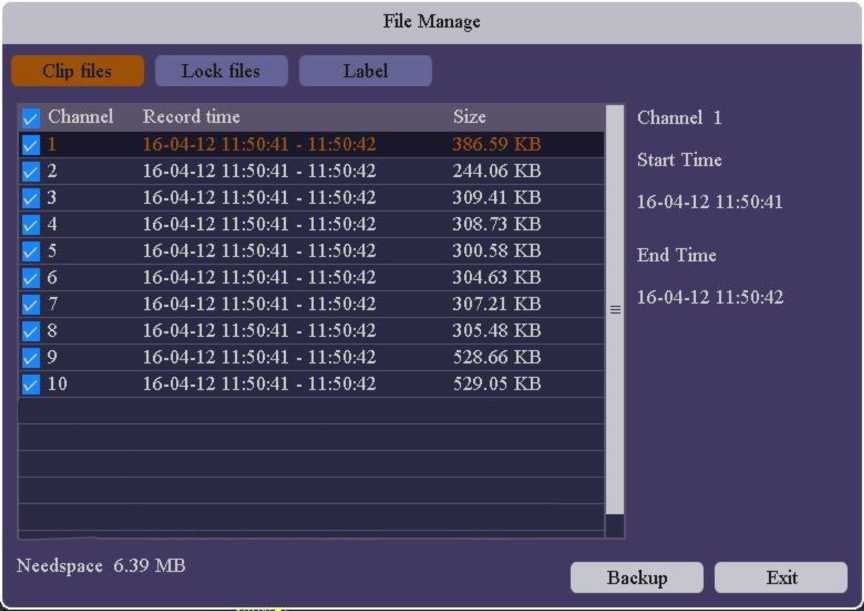
Figure 4-100 Clip files
And you can backup the clip files in this interface.
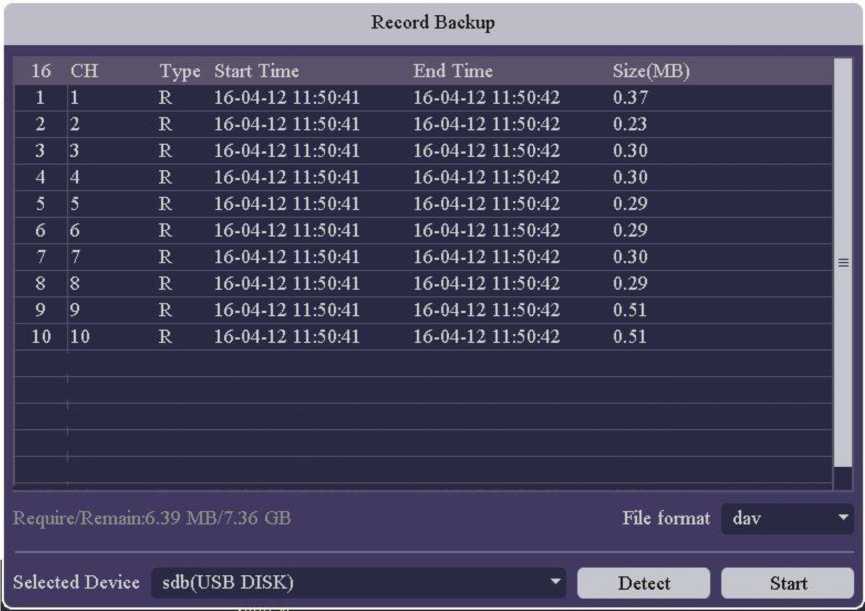
Figure 4-101 Backup the Clip files
The “Lock Record” button will lock the file in case this file be covered by new file. You can check and backup the locked files in “File Manage”. And you can unlock the locked files in this interface.
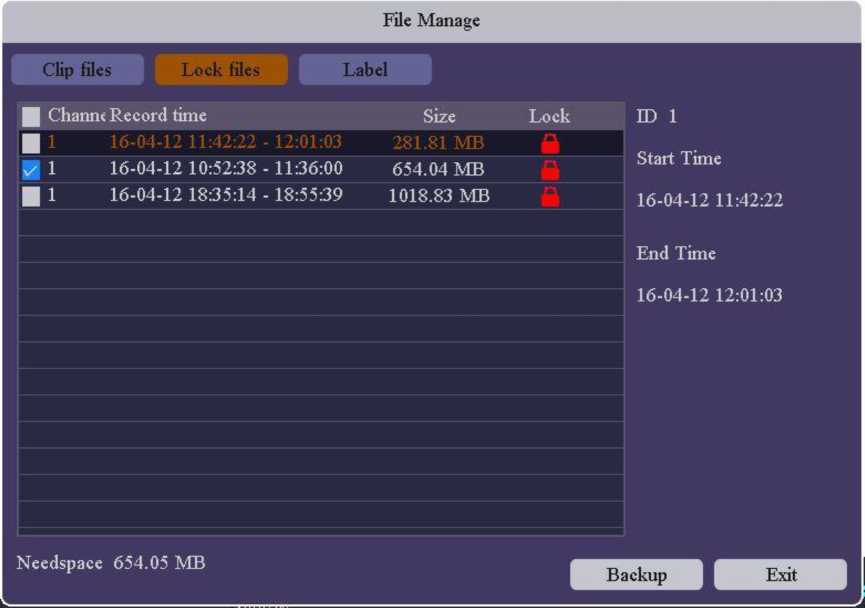
Figure 4-102 Lock Files
Click the “Default Label” button will mark the video as a default label, you can edit the label and check in the “File Manage”.
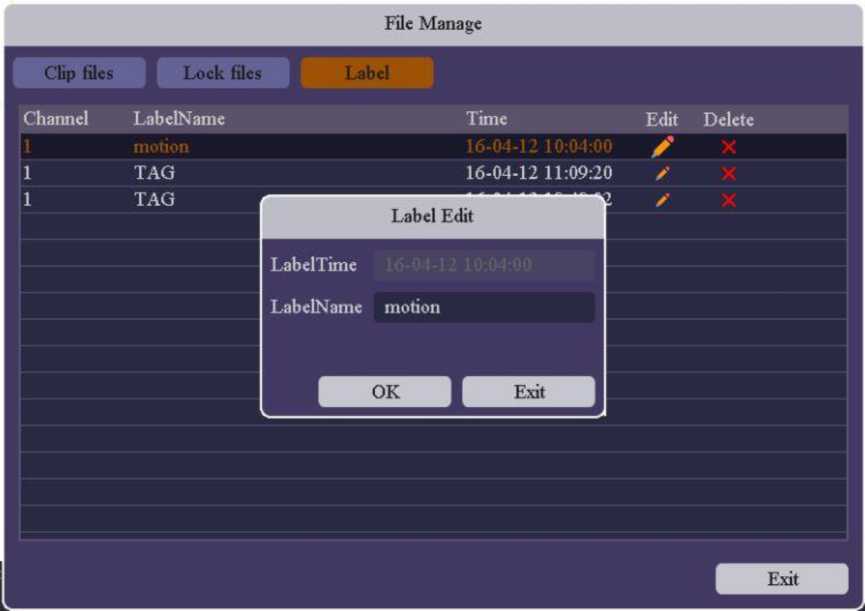
Figure 4-103 Label Manage
The “Main/Sub stream” button can change the video stream into sub stream from main stream, the “Speed up” button can speed up 32 times the channel you selected and speed up 16 channels 2 times top.
Select the “Event Play” enters the event playback mode.
- You need chose the event main type, including three event types “Alarm input”,
“Motion detect” and “IA Detect”. And the main type of “IA Detect” including two sub types event “Crossing detect” and “Area intrusion detect”.
- Select the channels you want to search. Then set time period, and click search button. Search results as shown in the figure, “Source” means alarm channel and “Chan” means record channel of linkage operations, “Time” means when the alarm happened.
- The next area shows all the alarm items and you can change the page to find the alarm item you want. And then you can set the play time period before/after of the alarm
time.
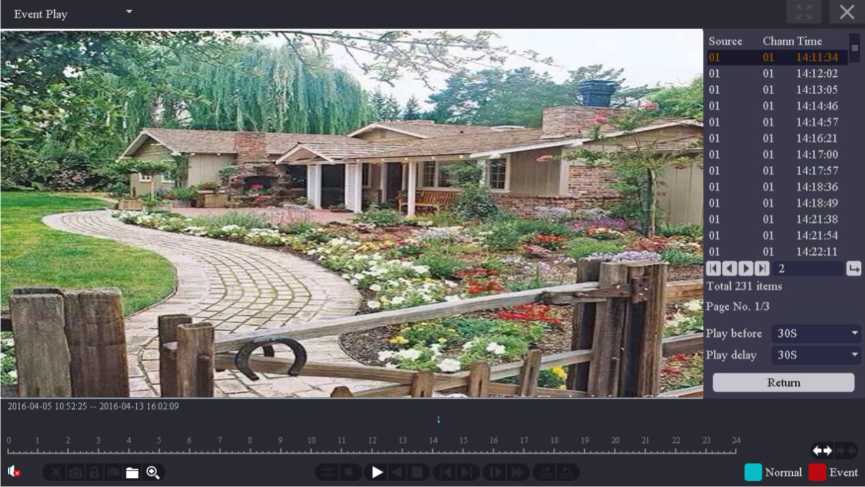
Figure 4-104 Search Result of Event Playback
| Key Picture | Key Title | Key Function |
| 1 | First | Quickly go to the first page of event search results. |
| Prev | Go to the previous page of event search results. | |
| Next | Go to the next page of event search results. | |
| 5T | Last | Quickly go to the last page of event search results. |
| L_^ | Goto | Click jump to the page you entered into the entry bar. |
Table 4-9 Buttons of Event Search Results
You can change the alarm types and channels by click the return button back to the last interface.
As for the operations of these buttons you can refer to the previous table. But you can’t use the “Sync/Async”, “Main/Sub stream”, “Frame Control” button in event playback mode.
Select the “Label Play” enters the label playback mode.
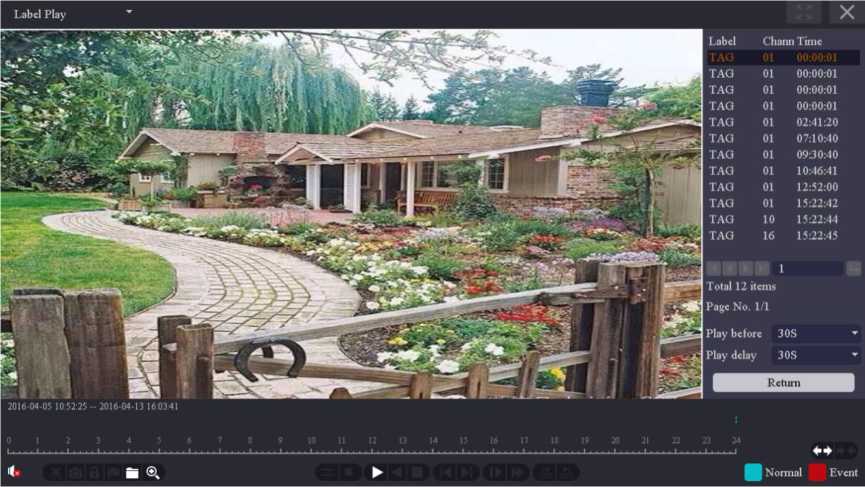
Figure 4-105 Search Result of Label Playback
- Select the channels, and set the time period of search.
- Click the search button, search results as shown in the figure.
- “Label” means label’s name that you can edit in file manage and “Chan” means the channel you tagged, “Time” means the time that was playing when you tag.
- The next area shows all the labels and you can change the page to find the label items you want. And then you can set the play time period before/after of the label time.
- You can change the search channels by click the return button back to the last interface.
- As for the operations of these buttons you can refer to the previous table. But you can’t use the “Sync/Async”, “Main/Sub stream”, “Frame Control” button in label playback mode.
Note:
> The operations of these buttons you can refer to the last part.
Select “Smart Play” enters this playback mode. In this section UVR support analyze exist video according to specific rules. Now the rules include “line accrossing, Area Intrusion, Motion Detection and Face Detection”.
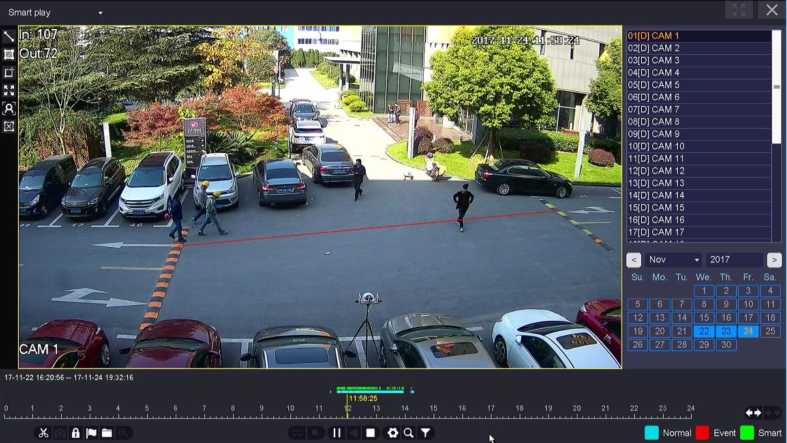
Figure 4-106 Smart Playback – Draw Line
1. First you need select a channel and click “Paly”, then the icon of “Draw Line” can be active. You can click to draw a line on the video interface;
2. Click “Setting” button you can specify some setting for playback like “Skip NonFocus Video” and specify the playback speed for NonConcerned-Video and Attention-Video, also you can specify the time before and after the events from 0 to 600 seconds.
3. Click “Search” button then the result will be shown like figure 4-87, video with line accrossing will be marked color “green”, and the video will be played by the setting as you made at step 2.
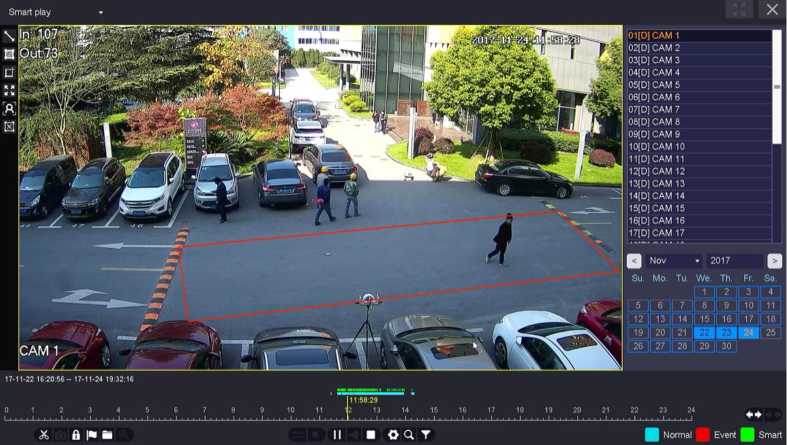
Figure 4-107 Smart Playback – Draw Quadrilateral
- First you need select a channel and click “Paly”, then the icon of “Draw Quadrilateral” can be active. You can click to draw a quadrilateral on the video interface;
- Click “Setting” button you can specify some setting for playback like “Skip NonFocus Video” and specify the playback speed for NonConcerned-Video and Attention-Video, also you can specify the time before and after the events from 0 to 600 seconds.
- Click “Search” button then the result will be shown like figure 4-88, video with Area Intrusion will be marked color “green”, and the video will be played by the setting as you made at step 2.
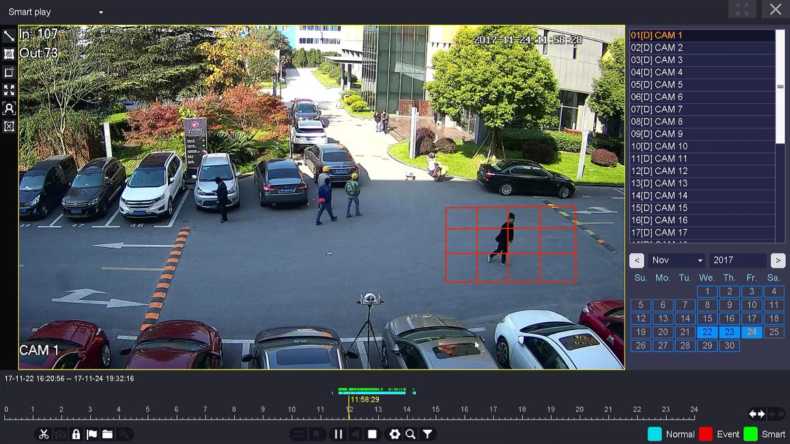
Figure 4-108 Smart Playback – MotionDraw Retangle
- First you need select a channel and click “Paly”, then the icon of “MotionDraw Retangle” can be active. You can click it to draw an area on the video interface;
- Click “Setting” button you can specify some setting for playback like “Skip NonFocus Video” and specify the playback speed for NonConcerned-Video and Attention-Video, also you can specify the time before and after the events from 0 to 600 seconds.
- Click “Search” button then the result will be shown like figure 4-89, video with Motion will be marked color “green”, and the video will be played by the setting as you made at step 2.
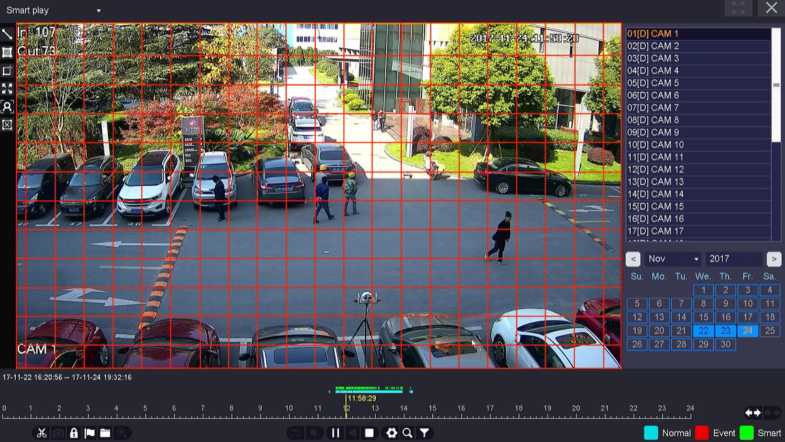
Figure 4-109 Smart Playback – Motion Full Screen
1. First you need select a channel and click “Paly”, then the icon of “MotionFullScreen” can be active. You can click it to draw an area on the full video interface;
2. Click “Setting” button you can specify some setting for playback like “Skip NonFocus Video” and specify the playback speed for NonConcerned-Video and Attention-Video, also you can specify the time before and after the events from 0 to 600 seconds.
3. Click “Search” button then the result will be shown like figure 4-90, video with Motion will be marked color “green”, and the video will be played by the setting as you made at step 2.
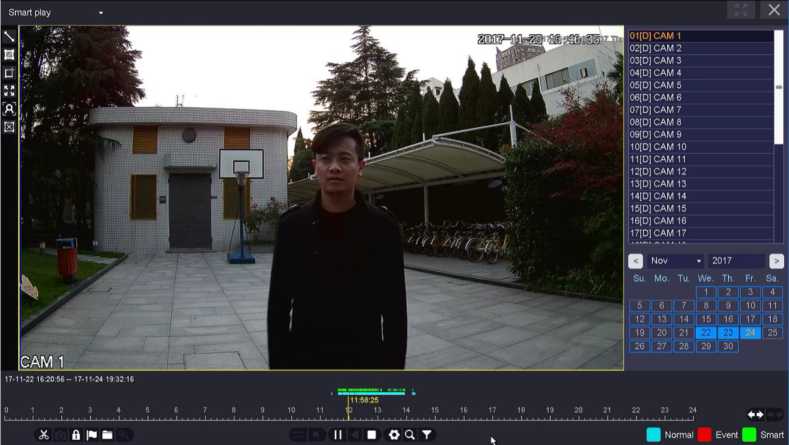
Figure 4-110 Smart Playback – Face Search
1. First you need select a channel and click “Paly”, then the icon of “Face search” can be active. The full video interface will be detected by default;
2. Click “Setting” button you can specify some setting for playback like “Skip NonFocus Video” and specify the playback speed for NonConcerned-Video and Attention-Video, also you can specify the time before and after the events from 0 to 600 seconds.
3. Click “Search” button then the result will be shown like figure 4-90, video with people’s
face will be marked color “green”, and the video will be played by the setting as you made at step 2.
Note:
- Face Detection only work with Qualvision 6 series UVR.
- Face Detection only work with Qualvision IPCs which support this feature.
When you click this button that means clear all the lines and rectangles you have drawn before.
Then you can draw new lines and specify new rules.
Select the “Time Division Play” enters the time division playback mode.
Figure 4-111 Time Division Playback
4. First you need chose the channel and select division windows number to display, from 1-16 windows. For example, if you chose the windows number is 4, the files of the date you chose will be divided into 4 parts.
5. You can change the playing channel but do not need to stop. And change the windows division number when the channel is playing.
As for the operations of these buttons you can refer to the previous table.
Figure 4-112 Normal Playback of Picture
1. Select the “Normal Play (Picture)” enters the normal playback of pictures mode.
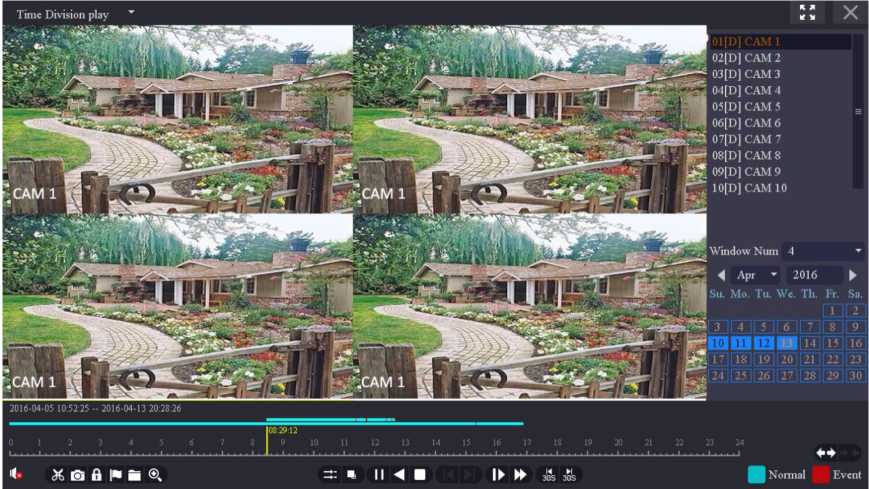
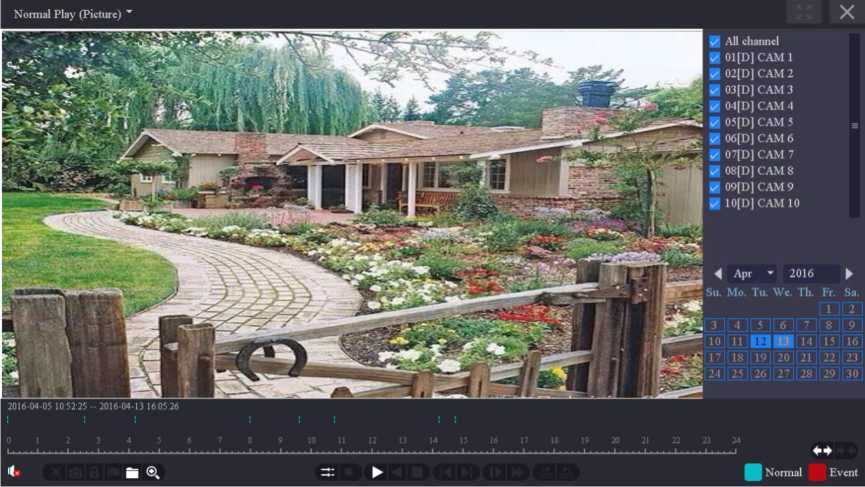
2. Select the channels, the search result as shown in the figure. As for the button of control playback including “File Manage”, ”Sync/Async”, “Start/Pause”, “Backward play”, ”Stop Playing”, “Slow down”, ”Speed up”, and “Time-line Stretch”, “Time-line Shorten”.
The sources of pictures you play are manual snap on preview interface and the manual snap in playback interface.
Note:
- You can stop playback by right click, and exit the playback interface by keep right click.
- If you chose more than one channels to playback, double click can make the channel shows in one screen.
Click Shutdown, as shown in the figure.
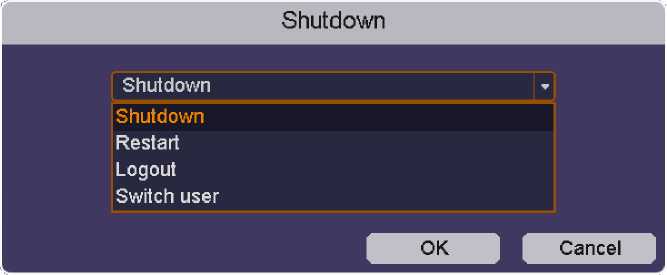
Figure 4-113 Shutdown
• Shutdown: Exit system, and then shut down device.
• Restart: Exit system, then restart device.
• Log out: Password is needed to re-enter the menu after logout.
• Switch user: Switch the user and use another account to login.
Chapter 5 WEB Application
Manager
- Open your web browser and input the IP address of HD DVR, such as http://192.168.L9 (the default IP address), if your IP address has been changed, you can use the new IP address, and press the Enter key to enter the login interface.
- If it is the first time to login, it will notice you to install the plug-in, you can find it either in CD or download from web site.
- After plug-in installation, please input the user name and password (The default username is admin and the password is 1234567u), and select language in the interface, shown as figure 5-2.
- Click on login button to go to web preview interface.
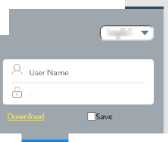 If you enable the “Save Password”, your password and user name will be remembered the next time you login.
If you enable the “Save Password”, your password and user name will be remembered the next time you login.
English
Password
Innovative Video Technology
ELEVATE SERIES
Figure 5-2 Login Interface
After you login successfully, you will enter the preview interface, as show in figure 5-3.
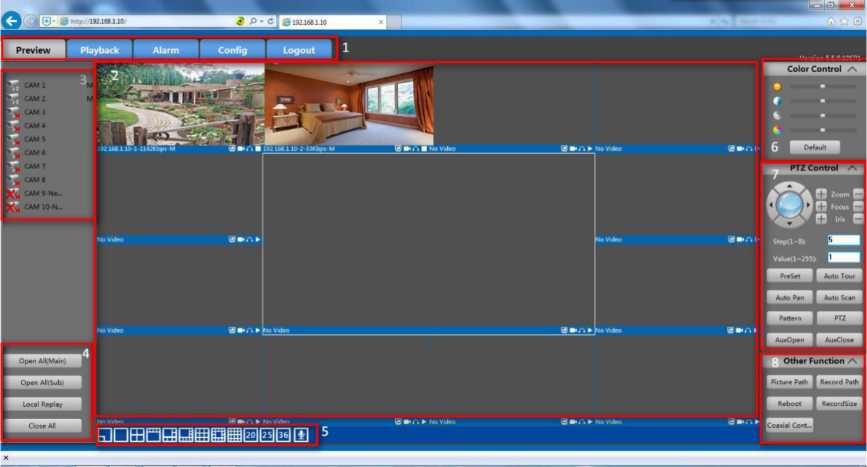
Figure 5-3 Preview Interface
| No. | Items | Function Description |
| 1 | Function Tab | Main Menu Includes preview, playback, Alarm, Config and Logout. |
| 2 | Preview
channels |
The connection channel of HD DVR. |
| 3 | Device channels | You can open the preview channel in main/sub stream and close the preview channel. |
| 4 | Video control |
stream
|
| 5 | Windows division | Split-screen switch button, it can be adjusted to preview in 1/4/5/6/8/9/13/16/20/25/36 channels |
| 6 | Color control | Adjust the Brightness, Contrast, Saturation and Hue of the color. |
| 7 | PTZ control | Control PTZ directions, add preset and tour etc. |
| 8 | Other function | You can set the saving path of the pictures / local record, and set the size of video, and click the reboot button to restart the HD DVR. |
Table 5-1 Function Description of preview area
After login the HD DVR, you can choose a channel and preview the channel in real time.
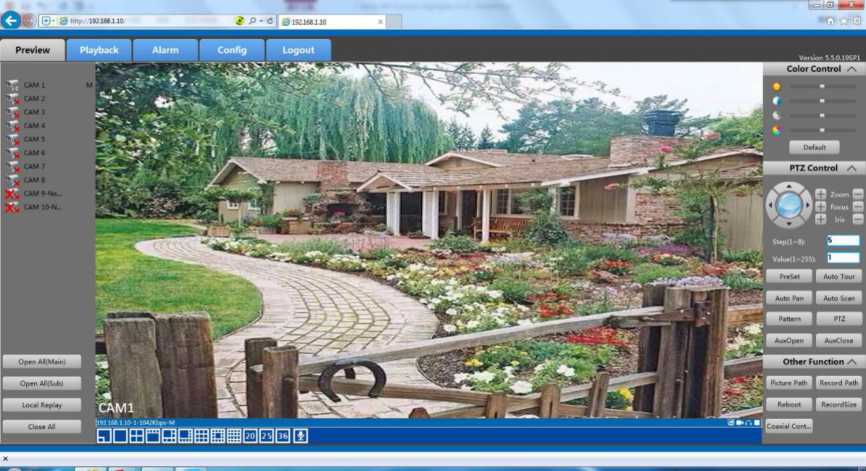
Figure 5-4 Channel Preview Interface
| Items | Function Description |
| IP] r ■ Capture | Capture a picture and save it in the picture path you have set before. |
| □ Record | Record a video and click it again to stop recording, and save it in the record path you have set before. |
| QI Listening | Turn On/Off the audio. |
| ^3/^3 Stop | Click the^Sbutton to open the preview channel ,and click ^3 to close it. |
Table 5-2 function description of preview interface
- Click the playback button to enter playback interface, show as figure 5-5.
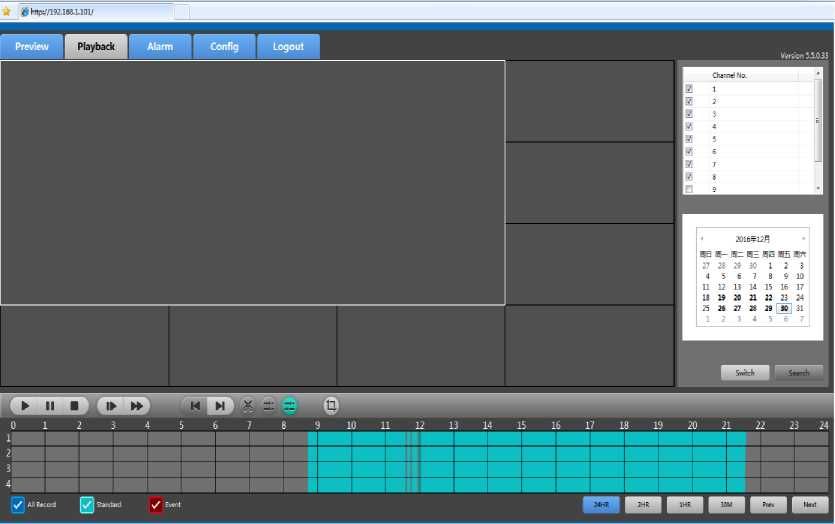
Figure 5-5 Playback Interface
It supports 4 channels playback at the same time, it displays the intraday videos of 1/2/3/4 channel by default. On this page, you can select the any channel and date you want, and then
click the Search button, it will display the results of your research.
2. Click the switch button to anther interface, show as in figure 5-6.
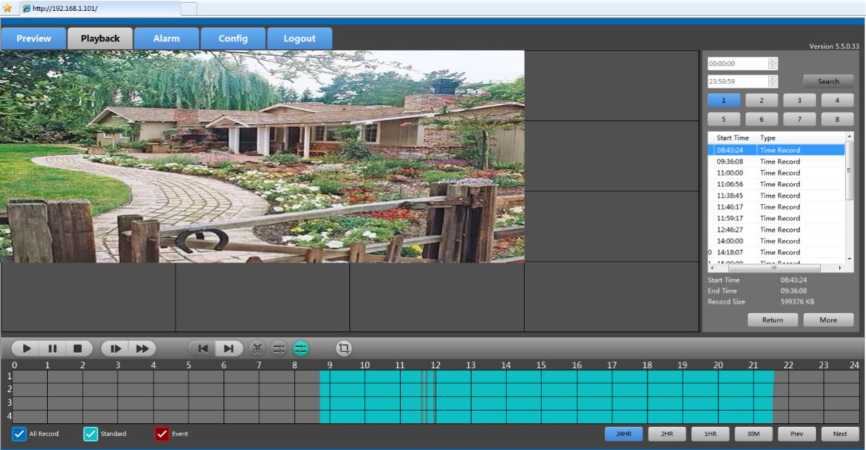
Figure 5-6 Switch Playback Interface
Set the start time and end time of the videos you want to see, click the Search button, and then it will display the matched results. Each video will display its start time and its type, and all the videos in the same channel will display in chronological order.
3. Click the More buttons, you will turn to the interface of setting more parameters, as
show in figure 5-7.
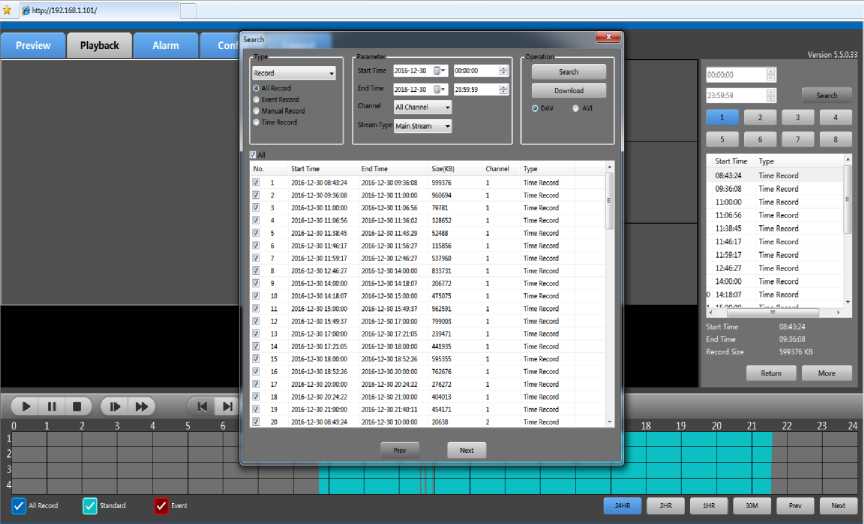
Figure 5-7 More Detail Parameters Setting Interface
In this interface, you can set the more detail parameters such as start time, end time, channel, stream type, the type of records, and click the Search button, and then all matched records will be listed below. Check the record file you want to download and click the Download button. System will download the record file in sequence and save to PC. After downloading finishes, the check box of “Download Completed!” will be pop-up.
Click the alarm button to enter the alarm setting interface, shown as in the figure 5-8.
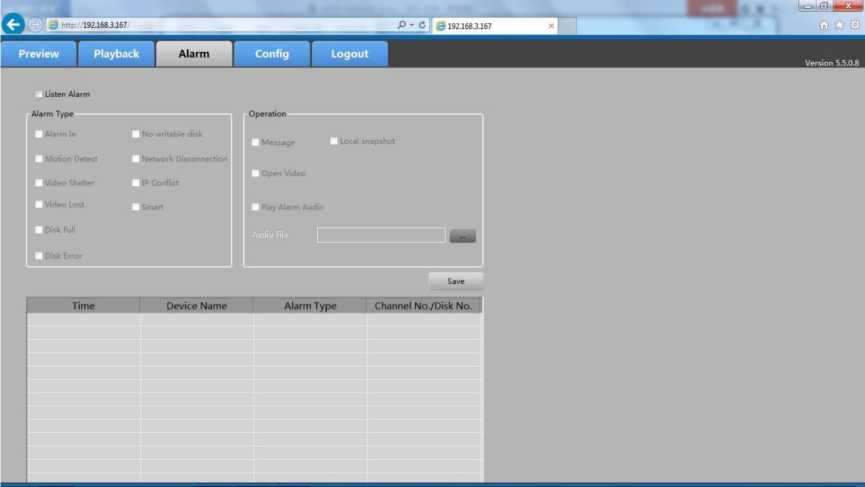
Figure 5-8 Alarm Setting interface
After checking Listen Alarm box, and select the alarm type below, when the device trigger the corresponding alarm, it will display an alarm message to notify you. And link operation will be active.
- Message: Auto jump to this page when alarm triggered.
- Local captures: Auto-grab screenshots of alarm channel.
- Open the video: Opens the channel automatically which trigger the alarm.
- Play alarm sound: Play sound when alarm triggered.
Click “Config -> Local Set” to enter the interface, as shown in the figure 5-9.
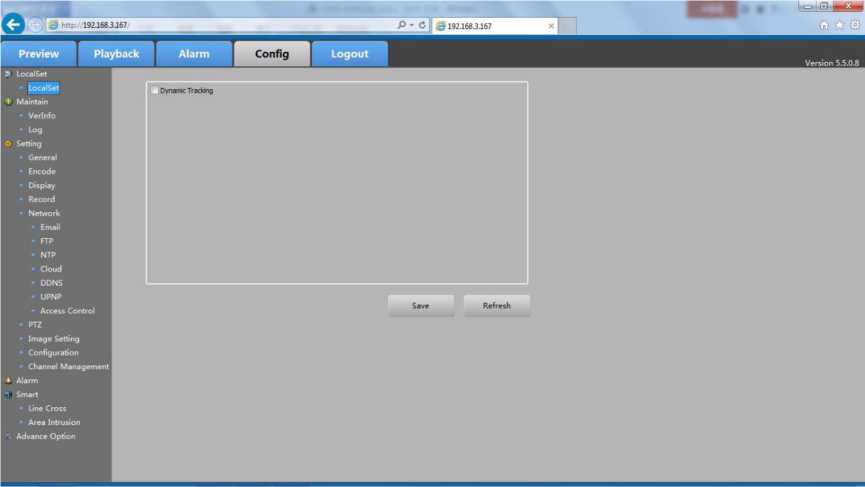
Figure 5-9 Dynamic Tracking Setting Interface
Note:
> The IPC must support the function, or even if HD DVR enable the function of Dynamic
Tracking ,it will not make effect.
Click “Config ->Maintain ->VerInfo ” to enter the interface, as shown in the figure 5-10.
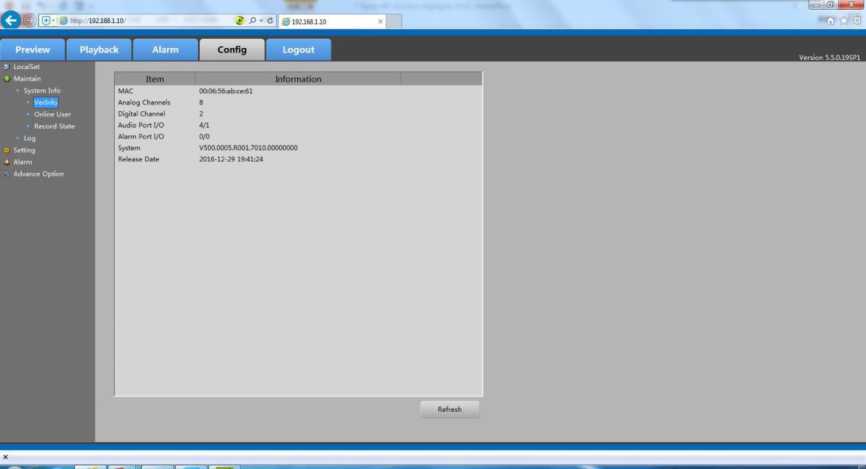
Figure 5-10 Version Information of HD DVR
It displays the MAC address of HD DVR, channel numbers, the number of audio input and output, the number of alarm input and output, system version, the release date of software version.
Click “Config ->Maintain ->Log ” to enter the interface, as shown in the figure 5-11.
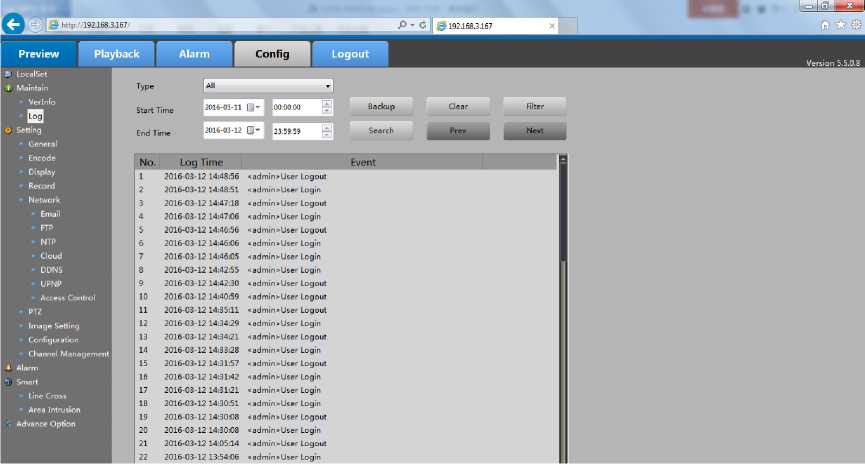
Figure 5-11 Log Search Results
- Set the log search conditions to refine your search, including the Start Time, End Time and Type.
- Click the Search button to start search log files, the matched log files will be displayed on the list shown below
- Backup: Back up all log files to the local PC.
- Clear: Clear all log files.
- Filter: You can select the filter items to save the log files, the max number of logs is 4096, when the number of log is beyond 4096, “log full coverage “or “stop” are for choice.
- Prev / Next: Up to 900 log files can be displayed each time ,when the number of the matched logs beyond 900, you can click on Prev/ Next button to view more log files.
Click “Config ->Setting ->General” to enter the interface, as shown in the figure 5-12.
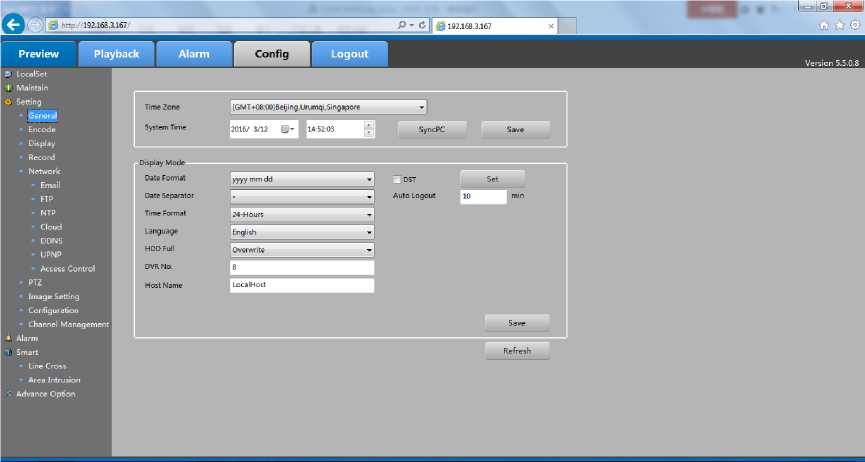
Figure 5-12 General Setting Interface
Configure the following settings, and then click Save button to save the settings.
• Time Zone: Select the time zone
• System Time: Select the system date and time.
• Date Format: Select the date format
• Time Format: Select the date format
• Language: There are Simplified Chinese, English, Italian, Russian, Portuguese, Turkish,
Persian, and Arabic.
• HDD full: Overwrite and Stop are for choice.
• Device No.: The default number is 8 ,if it is modified to any other number ,remote control will not make effect to the HD DVR.
• Host Name: Set the name of HD DVR.
• SyncPC: The time zone and the system time can synchronize your local PC.
• Smart Display: Click the Smart Display check box, the pre-defined virtual line and pre-defined virtual region will display in the preview channels.
Click “ Config ->Setting ->Encode ” to enter the interface ,as shown in figure 5-13.
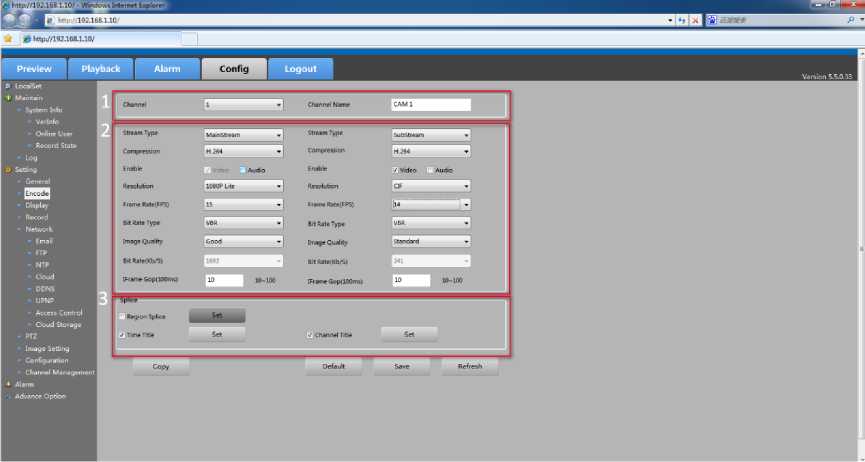
Figure 5-13 Encode Setting Interface
| No. | Function Description |
| 1 | Set channel name for each channel . |
| 2 | The left column is used to set the relevant parameters of main stream for each channel, the right column is used to set the relevant parameters of sub stream for each channel. |
| 3 | Overlay Sets the selected channel of the area covered and the time and channel headings displayed, this model HD DVR Position control of the channel and time headers are not supported. |
Table 5-3 Function Description of Encode Setting Areas
Click “ Config ->Setting ->Display ” to enter the interface, show as figure 5-14.
Figure 5-14 Display Adjustment Interface
You can click the check box of time title, channel title, alarm state and record state to enable these function, if time title and channel title are set as enabled, they will appear on the screen of current HD DVR system. You can modify the parameters of top/bottom/left/right to adjust TV display.
Click “ Config ->Setting ->Display ” to enter the interface, as show in figure 5-15.
Figure 5-15 Record Schedule Interface
The parameters should be consistent with HD DVR local setting .Green stands for normal record, yellow stands for motion detection ,red stands for I/O trigger record .
• Channel: set record type for each channel ,mainstream and substream are for choice.
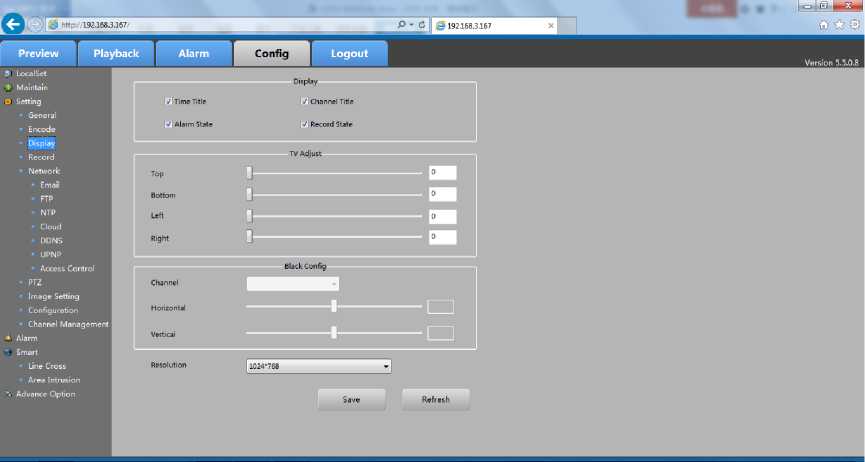
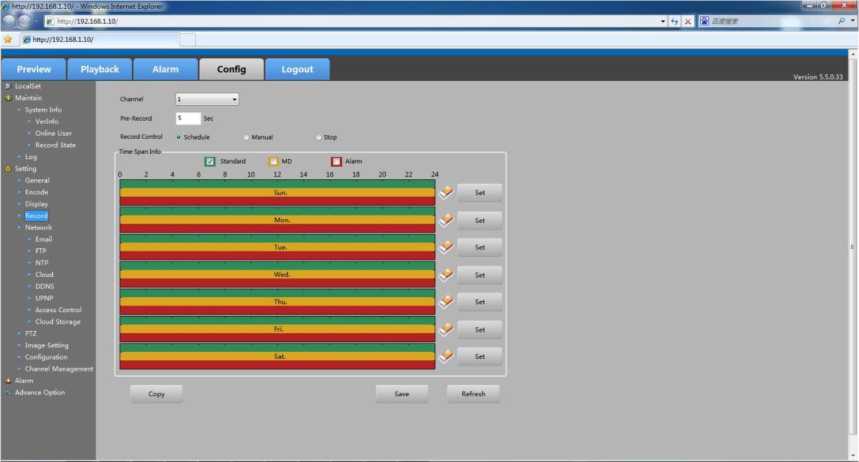
- Pre-record: Set the pre-record time for each channel.
- Record Control: Three kinds of video control such as schedule, manual and stop.
•
How to configure Record Schedule:
- You can choose the day to which you want to set schedule, click the set button on the right.
- The default is to schedule an all-day recording, to arrange other schedule, set the Start/End time for each period.
- Select the record type on the right hand side
- Click Ok to save all the settings.
- Repeat the above edit schedule steps to schedule recording for other days in the week. If the schedule can also be applied to other days, click the day you want to configure the same schedule, and click OK.
Note:
- Up to 8 periods can be configured for each day. And the time periods can’t be overlapped each other.
Click “ Config ->Setting ->Network ” to enter the interface, as show in figure 5-16.
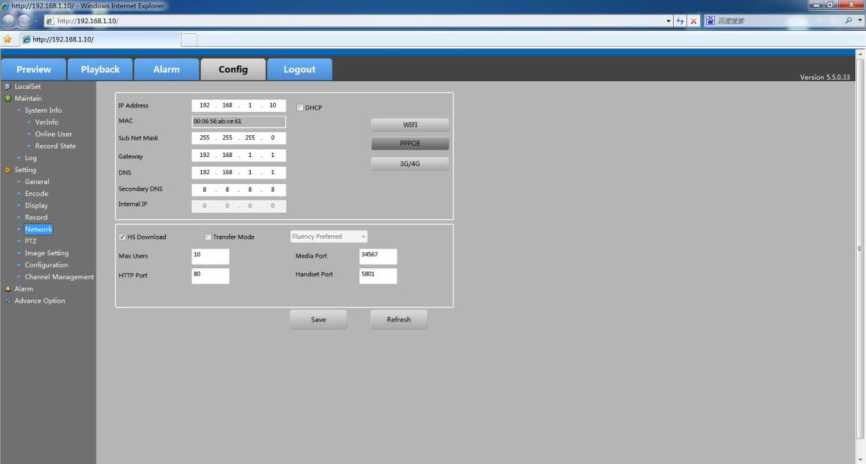
Figure 5-16 Network Setting Interface
HD DVR support Static/DHCP/PPPOE/3G/Wifi modes. System default network type is static. User can set these parameters as required ,including IP Address, MAC, Sub Net Mask, Gateway ,DNS ,Secondary DNS, Internal IP, Max Users, Media Port, HTTP port, Handset Port.
- HS Download: Enable the function, you can download video faster.
- Transfer Mode : You can choose a different network policies, quality preferred, fluency preferred and adaptive are for choice
Click “ Config ->Setting ->Network->Email ” to enter the interface, as shown in the figure 5-17.
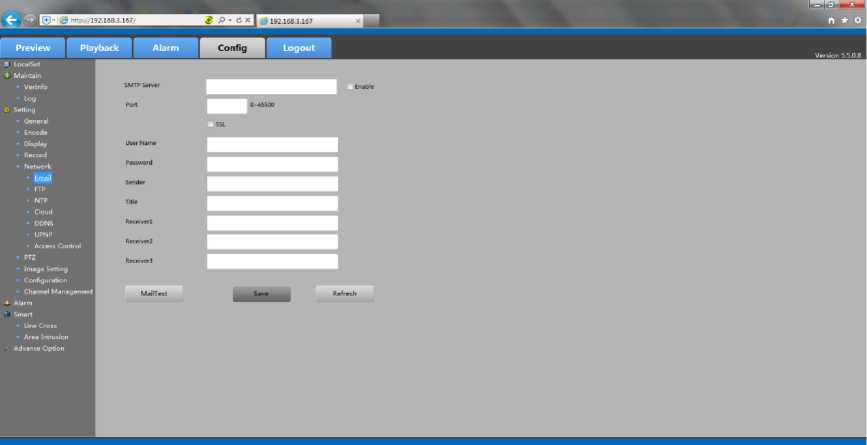
Figure 5-17 E-mail Setting by Web
Before you configure these parameters, you have to click enable button .Then set the relevant parameters ,including SMTP server, port, username, password, the email address of sender and receiver .Click Save to save all the settings, Click MaiTest button to confirm whether the setting is effective.
- SMTP Server: The SMTP Server IP address or host name (e.g.smtp.263.net).
- Port: The SMTP port. The default TCP/IP port for SMTP is 25.
Click “ Config ->Setting ->Network->FTP ” to enter the interface, as show in figure 5-18.
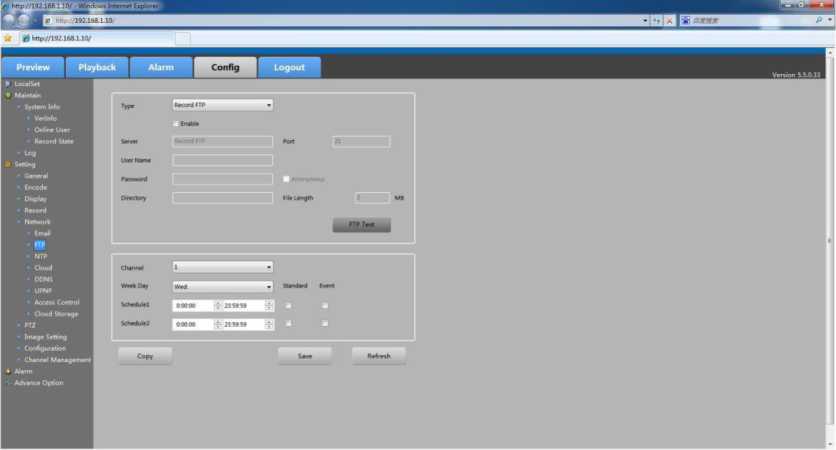
Figure 5-18 FTP Setting Interface
How to configure the FTP:
- Choose the type of FTP
- Click the enable check box
- Configure the FTP Server, port username, password , directory and file length
- Click save button to save all the settings
- Click FTP Test button to confirm whether the setting is effective.
- Set the schedule for each channel
- Click OK to save all the settings.
Note:
> Up to 2 periods can be configured for each channel. And the time periods can’t be overlapped each other.
Click “ Config ->Setting ->Network->NTP ” to enter the interface, as show in figure 5-19.
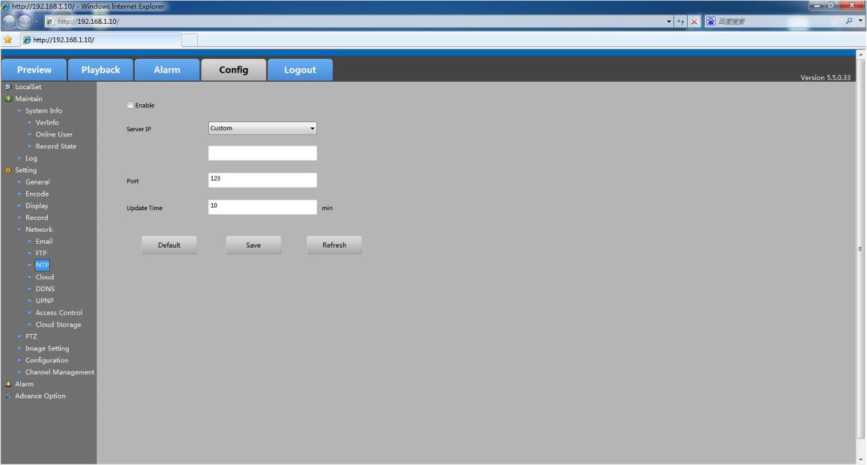
Figure 5-19 NTP Setting Interface
A Network Time Protocol (NTP) Server can be configured on your HD DVR to ensure the accuracy of system date/time.
1. Check the Enable checkbox to enable this feature.
2. Configure the parameters, including ServerIP, Port and Update Time.
3. Click Save button to save all the settings.
Click “ Config ->Setting ->Network->Cloud ” to enter the interface, as show in figure 5-20.
Click on Enable checkbox to enable the function of cloud. When the Status is connected, it means cloud function is available for use. You can download iPhone/Android InVid Elevate clientsoftware by scanning QR code. How to use Invid Elevate please refer to User Manual of InVid Elevate.
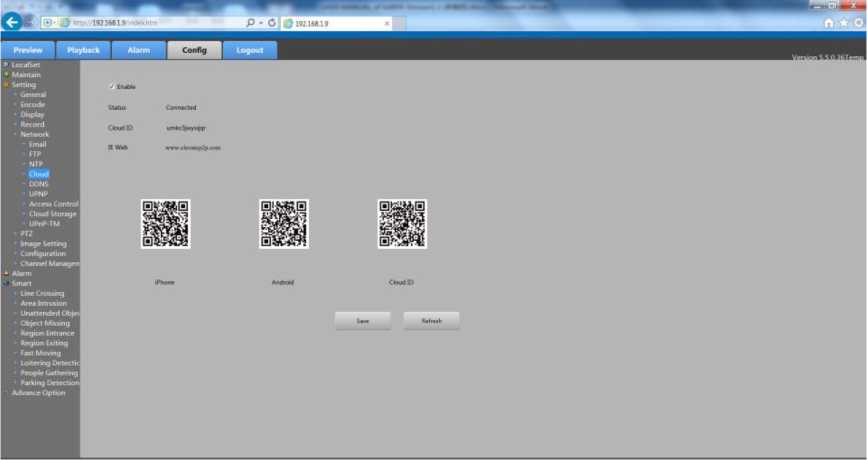
Figure 5-20 Cloud Setting Interface
• DDNS
Click “ Config ->Setting ->Network->DDNS ” to enter the interface, as show in figure 5-21.
- Click on the Enable to enable the function of DDNS.
- Select DDNS Type: four types are selectable, such as Oray DDNS, CN99 DDNS, DynDNS DDNS,
NOIP DDNS.
3. Set the Domain Name, User Name and Password .
4. Click Save to save the settings.
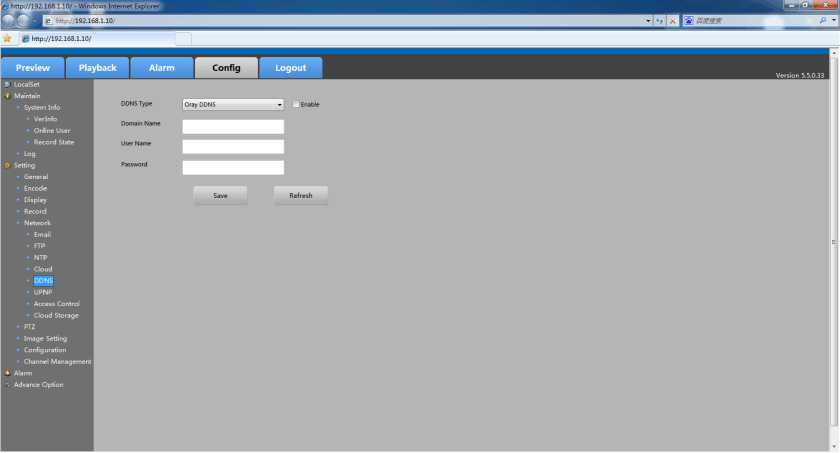
Figure 5-21 DDNS Setting Interface
• UPNP
Click “ Config ->Setting ->Network->UPNP ” to enter the interface, as show in figure 5-22.
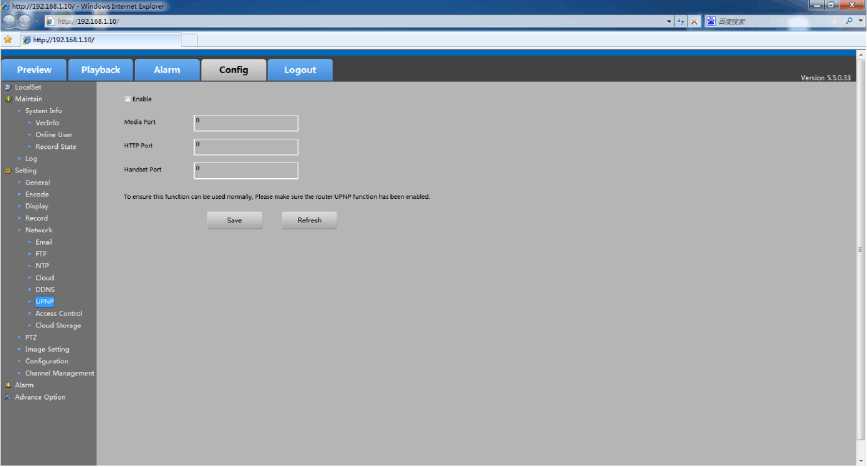
Figure 5-22 UPNP Setting Interface
Note:
• To ensure this function can be used normally, please make sure the router UPNP function has been enabled.
Click “ Config ->Setting ->Network->Access control ” to enter the interface, as show in figure 5-23. Select the type of restricted list, Blocked Sites and Trusted Sites are selectable. Input the IP
Address manually, click Add IP button on the right, click save button to save the settings. If you want to delete the IP you have set before, left-click an IP address from the IP Blocked list /IP
Allowed and click Delete IP, shown as Figure 5-23.
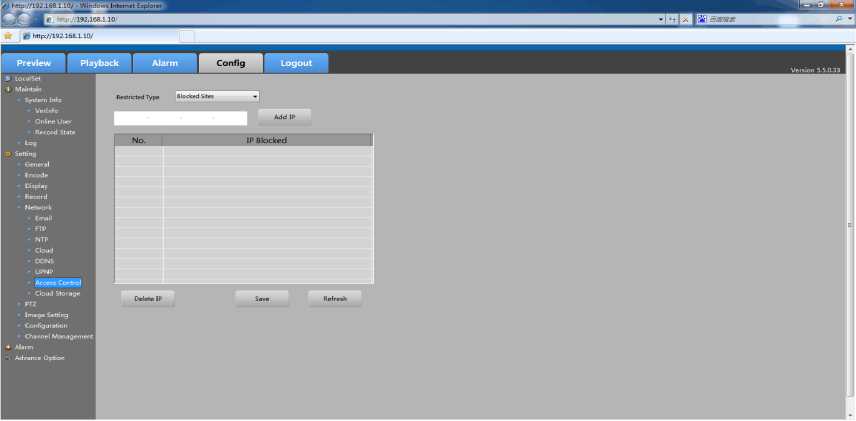
Figure 5-23 Access Control Interface
Click “ Config ->Setting ->Network->Cloud Storage ” to enter the interface, as show in figure 5-24.
You can set the Cloud Storage to upload your videos and picture recorded by your cameras.
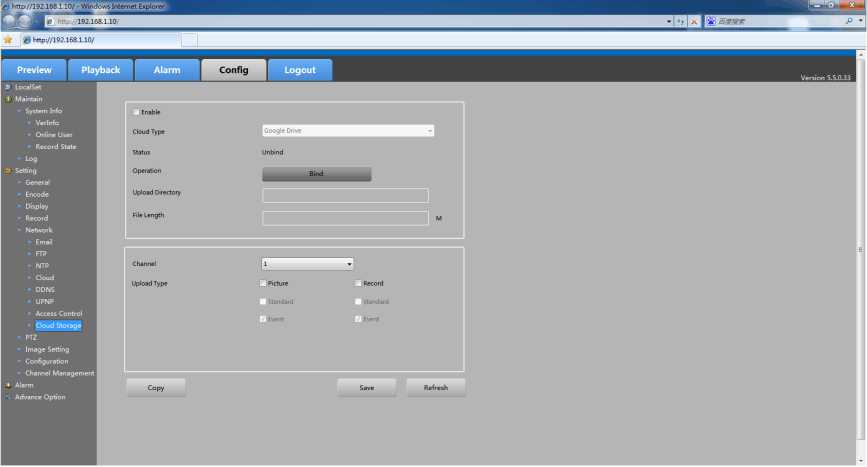
Figure 5-24 Cloud Storage
Click “ Config ->Setting ->Image Setting ” to enter the interface, as show in figure 5-25.
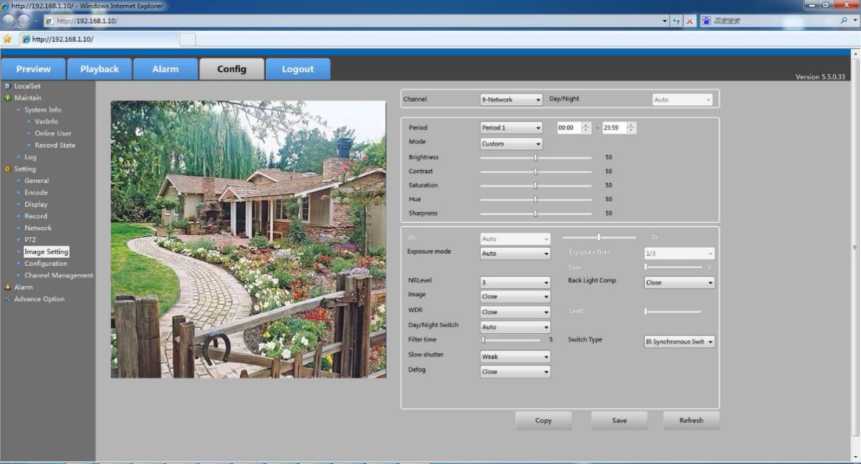
Figure 5-25 Image Setting Interface
- Select a channel and then set the relevant parameters ,when all the parameters have been configured ,
- Click Save button to save your configuration.
- IF you want to configure the same parameters to another channel ,click the Copy button and select any channel you want ,
- Click OK button to save.
Click “ Config ->Setting ^Configuration ” to enter the interface, as show in figure 5-26.
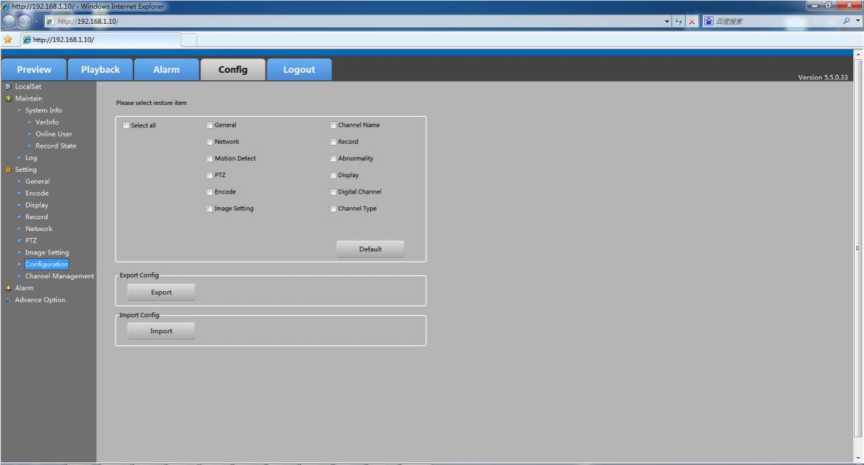
Figure 5-26 Configuration Setting Interface
1. Click on the checkbox of those item you want to restore, and click the Default button ,then all the configurations of the selected item will restore to the default value.
2. Click Export button to export all the configurations of the network camera in a .coi file.
3. Click Import button to import all the configurations of the network camera from a .coi file.
Note:
> If Network has been choose in the list, the IP address is also restored to the default IP address, please be careful for this action.
Click Config->Setting-> Channel Management->Channel Type. You can set each channel’s type and it’s protocol for AHD cameras, shown as Figure 5-27.
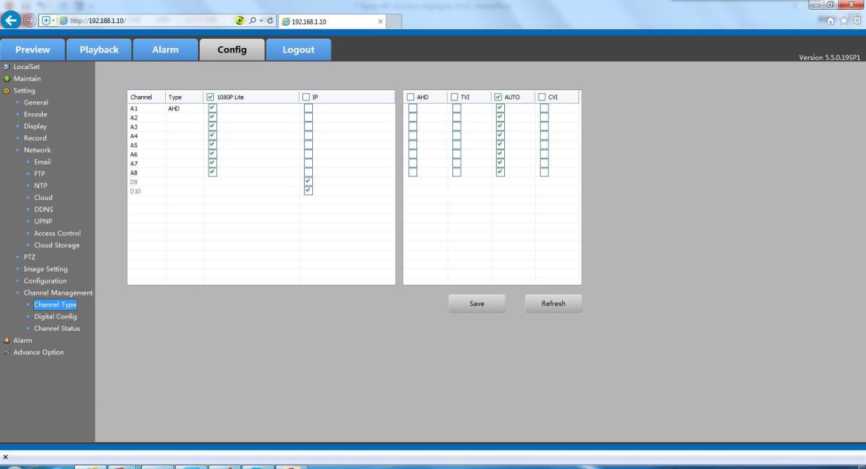
Figure 5-27 Digital Config of HD DVR
Click Config->Setting-> Channel Management->Channel Config. You can search the IPC in the Internet and set their parameters, including IP address, port, username/password, protocol, syn channel time switch and connection type. As show in figure 5-28.
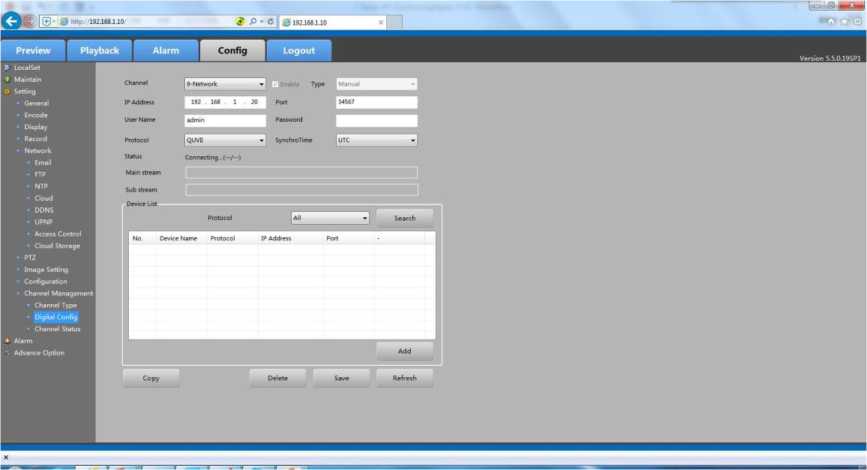
Figure 5-28 Channel Config of HD DVR
Click Config->Setting-> Channel Management->Channel Status. On this page you can check the channel name, channel connection status and alarm status, including Motion Detect, Video Shelter and Video Lost. As show in figure 5-29.
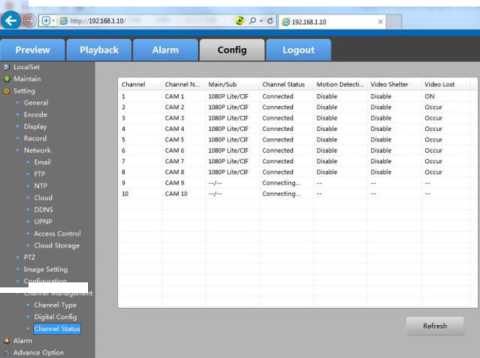
![]() Configuration
Configuration
Channel Management
Figure 5-29 Channel Status of HD DVR
Click the Config->Alarm->Motion Detect. As show in figure 5-30.
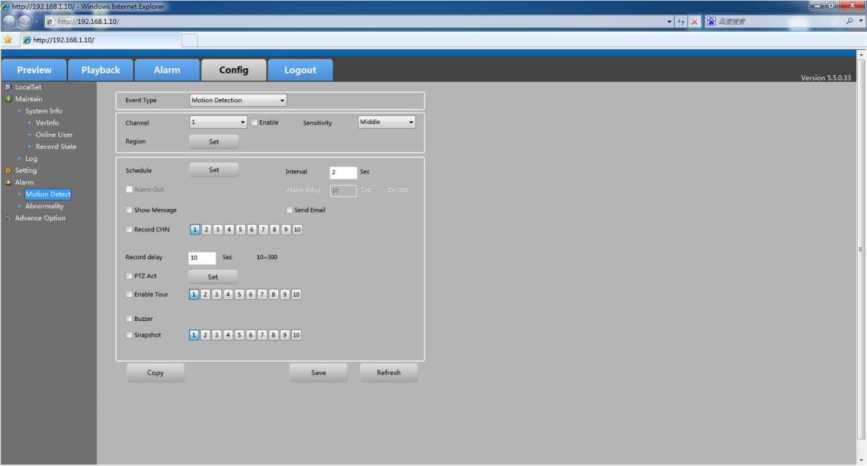
Figure 5-30 Motion Detect Setting by Web
The feature is similar to the local alarm of HD DVR. Event types are composed of motion detection, video loss and video shielding.
Taking motion detection for example to illustrate:
- Region: Set the alarm area.
- Sensitivity: Change the sensitivity of the motion detection. The higher the sensitivity, the easier to trigger alarm.
- Channel: Can be set for each channel.
- Enable: Motion detection-enabled switch.
- Schedule: Set the alarm time.
- Alarm Linkage Control: Include alarm output, show message, buzzer, send Emails, alarm recording, PTZ Act and tour.
Click the Config->Alarm->Alarm In/Alarm Out. You can set up alarm port and linkage operations.
• Alarm In
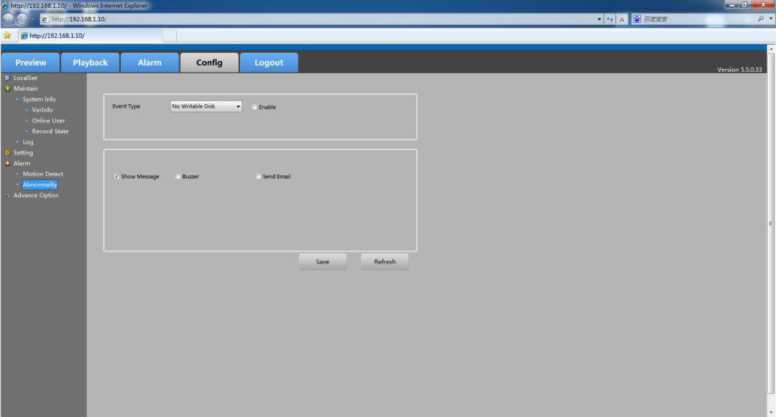
Figure 5-31 Alarm In Setting by Web
• Alarm Output
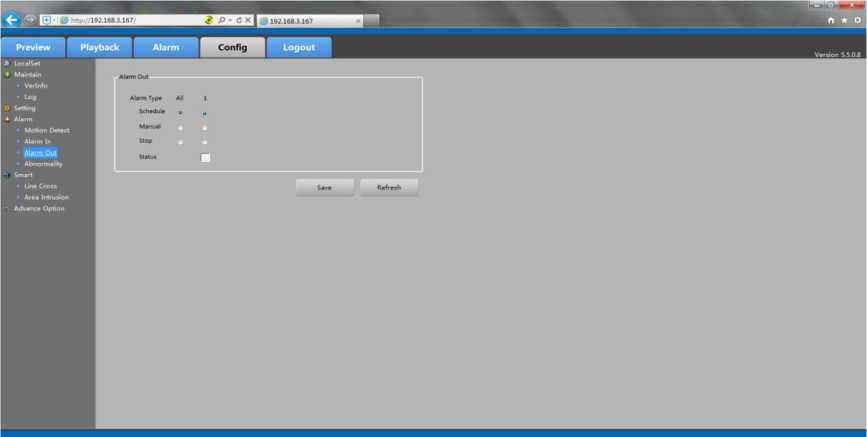
Figure 5-32 Alarm Out Setting by Web
Click the Config->Alarm->Abnormality. It is similar to the local abnormality of the HD DVR. You can set the alarm recording, screen tips, buzzer alarm, sending Emails, alarm output.
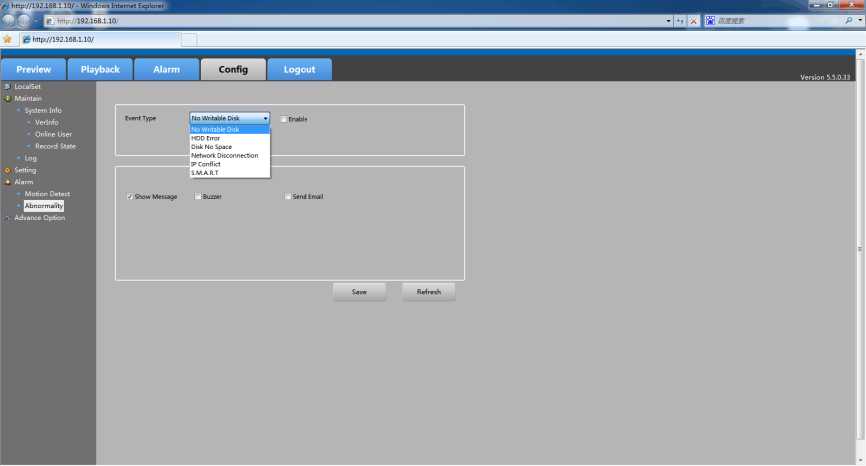
Figure 5-33 Abnormality Setting of HD DVR by Web
• No writable disk: There is no disk or the disk status is not available, such as read-only disk.
• Hard disk error: The connection between the disk and the device is error, such as the data lines are broken.
• Disk No Space: Alarm when the remaining space of the hard disk reaches the set value.
• Network Disconnection: Alarm when the network cable is disconnected.
• IP Conflict: Alarm when the IP address is the same as the others.
Click the Config-> Advance Option->Tour. It is similar to the HD DVR local settings.
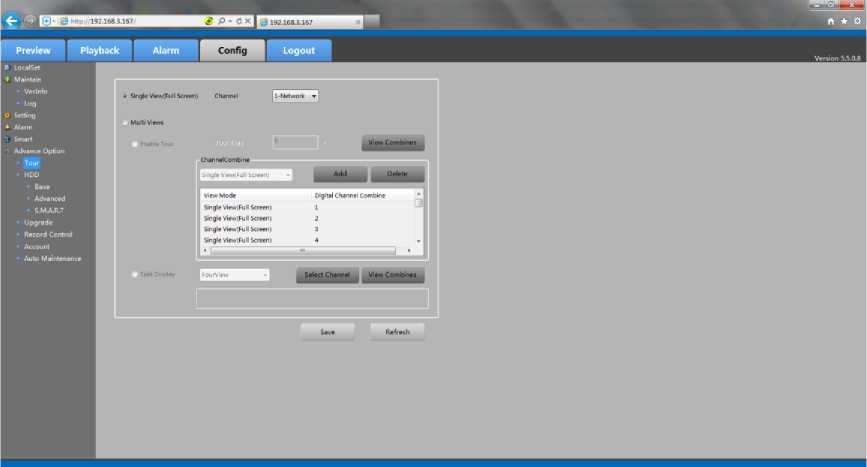
Figure 5-34 Tour Setting
- Interval time: Channel switching time.
- Channels choose: You can set different channels to switch between back and forth.
You can choose single channel or multi channels to display on your screen at regular
intervals.
Click the Config-> Advance Option->HDD. It is similar to the HD DVR local settings.
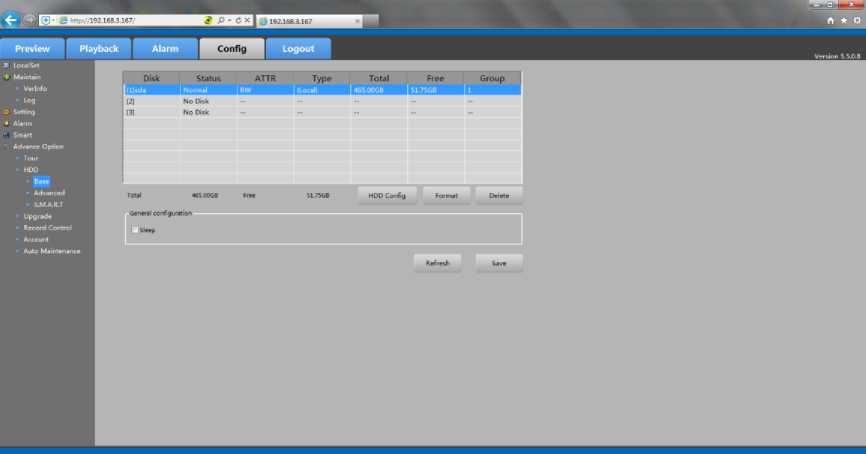
Figure 5-35 Base Setting of HDD
This page shows the status of the device‘s hard disk. You can set the state of the hard disk read and write. You can decide whether or not to sleep hard disk after a few minutes. In addition, you can also format or delete the hard disk.
- Hard disk: Hard disk serial number “[1]sda “Or” [2]sdb “.
- Status: “Unformatted” or “normal” or “no disk”.
- Read\write: The video can be recorded and can be played back.
- Read only: The video only can be played back but not be recorded.
- Redundant: You can find a completely identical video in the redundant disk. It is a function similar to that of a copy. The entire premise is that you have more than one hard disk.
- Group: Set which group the hard disk belongs to.
- Delete: Disconnect the connection between the hard disk and the device in logic. Of course, you can also restore the connection between them by clicking on the “Add” button.
- Format: Format the hard disk.
- Sleep: If the hard disk does not record or not play back in a few minutes, the disk will fall into sleep. This function can enhance the life of the hard disk.
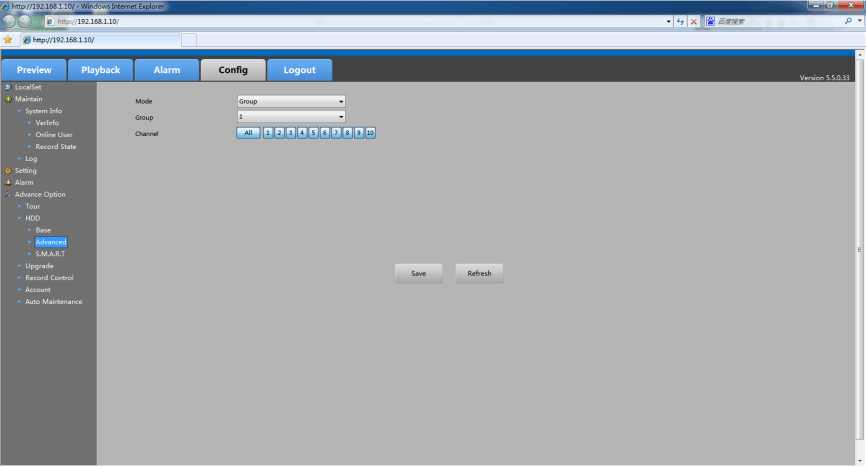
Figure 5-36 Advanced Setting of HDD
This page you can switch the hard disk’s storage mode, including the “group” or “quotas”. Your device will restart when you switch the mode.
• Group mode: You can select several channels attached to a disk group. Then their videos will be recorded in the group.
Select one disk group number.
Select several channels attached to the disk group.
- Quota mode: You can save videos or pictures for each channel that does not exceed the total volume of space.
- Record Quota: You can manually set the quota size of the channel video.
- Photo Quota: You can manually set the channel quota size to save the screenshots. Select one channel to set the quota size.
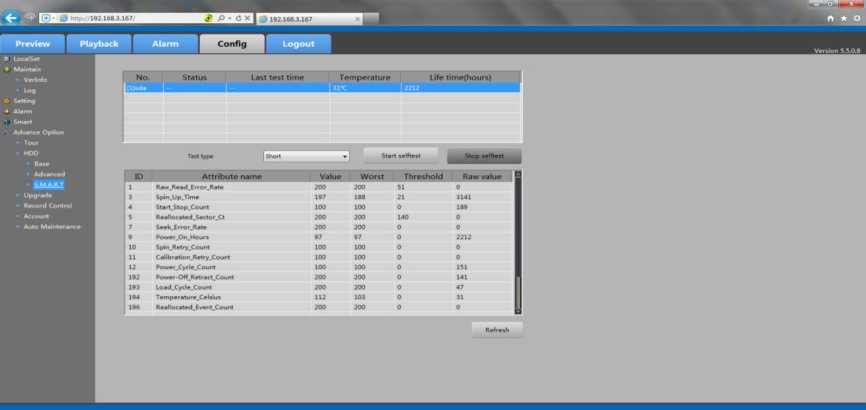
Figure 5-37 SAMRT Detect of HDD Setting by Web
It is used to detect the hard disk status.
- S.M.A.R.T: To detect the hard disk whether it meets the basic requirements for
storage.
- NO.: Access the hard disk serial number.
- Status: Can display the self-test progress in real time. And there will be a test result showing that the hard disk is “Passed “Or” Failed “.
- Last test time: A recent self testing time on the hard disk.
- Temperature: Display the hard disk temperature in real time.
- Life time: The time hours that your hard disk have been used for.
Click the Config->Advance Option->Upgrade.
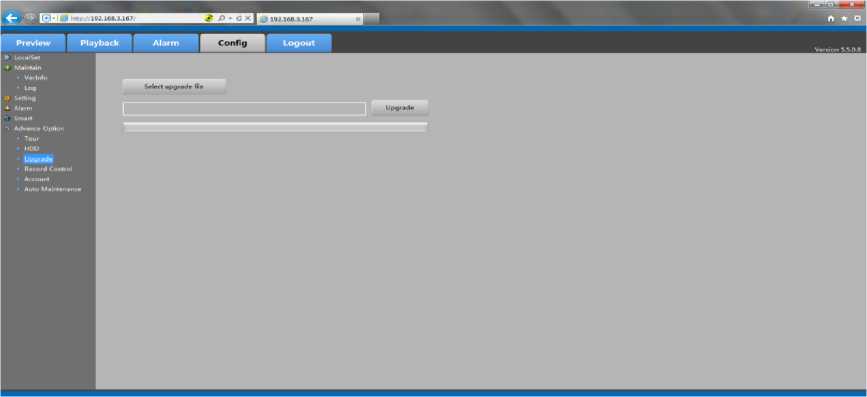
Figure 5-38 Upgrade HD DVR by Web
- Select the upgrade file from local.
- Click the upgrade, the device will automatically reboot in remote.
Note:
> In general, the extension of the upgrade file is ***.upf.
Click the Config->Advance Option->Record Control. You can quickly set the record control
mode for each channel. It is similar to the HD DVR local settings.
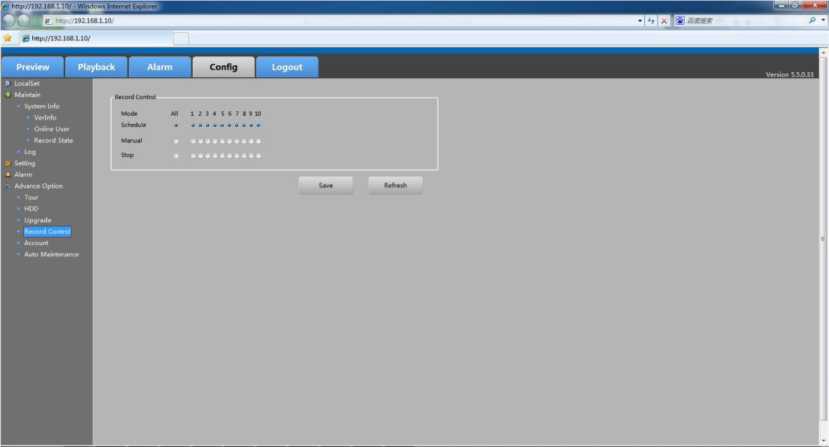
Figure 5-39 Quick Record Control by Web
Click the Config->Advance Option->Account. It is similar to the HD DVR local settings.
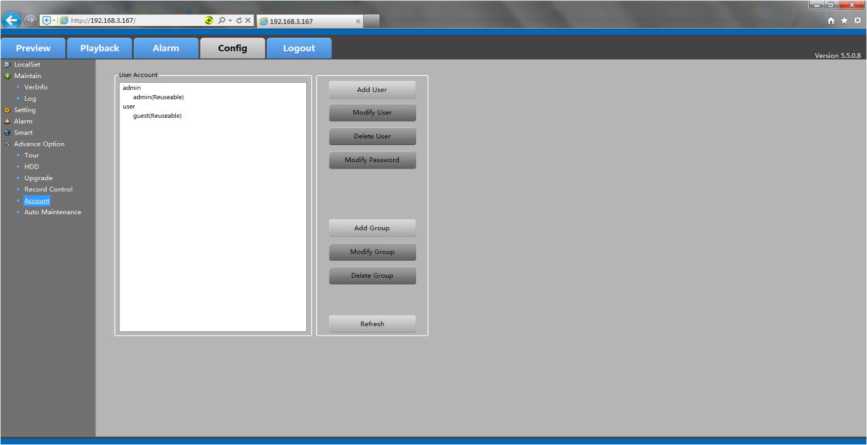
Figure 5-40 Account Setting of HD DVR by Web
• User accounts: Select the account you want to edit, the page will display this user’s editing privileges.
• The formula bar: Support to add and modify user rights, change password operation, add or delete the user and group.
Click the Config->Advance Option->Auto Maintenance. It is similar to the HD DVR local settings.
You can set the time for automatic restart of the HD DVR.
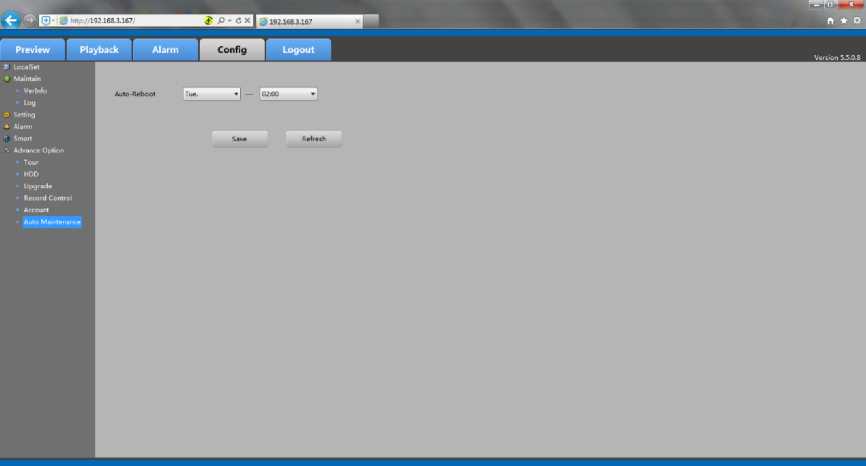
Figure 5-41 Auto Restart Setting by Web
Click the logout button, click OK, you will exit to the login page.
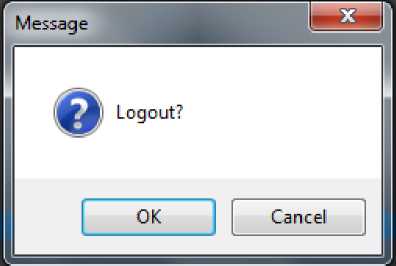
Figure 5-42 Logout the Web Client
Web -Remote management of equipment in another way is through P2P Connection access.
Open the web browser and input the www.elevatep2p.com, and press the Enter key to enter the login interface.
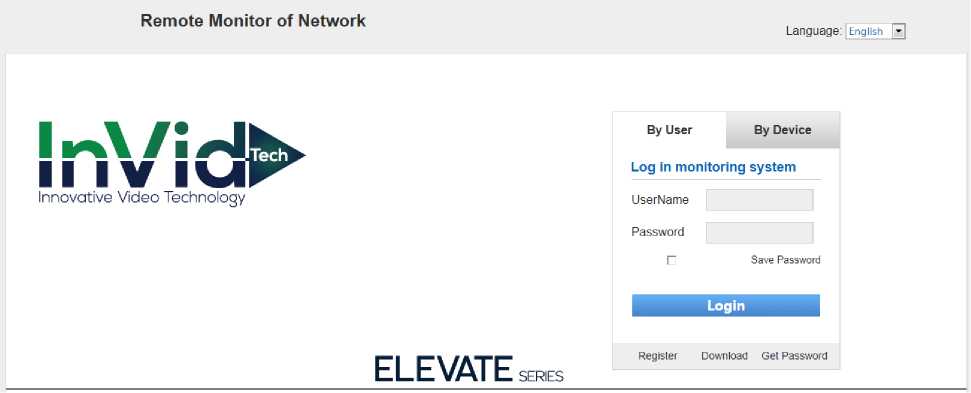
Figure 6-1 Main Interface of P2P
Click on the “register” button to enter the graphical interface, input your registration information to register. It will show a success message, and then you can login with your account.
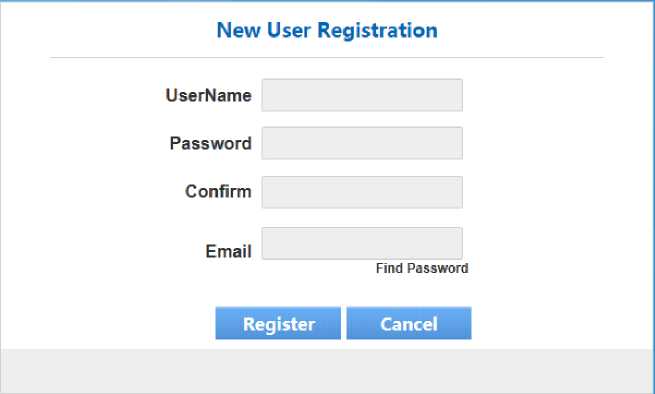
Figure 6-2 Register
This page displays the name and the connection status of have added devices. You can refresh the device status and login in a device manually.
After you add a device, according to prompts you can click Add device, shown as an IP Interface address connection, specific operations see section.
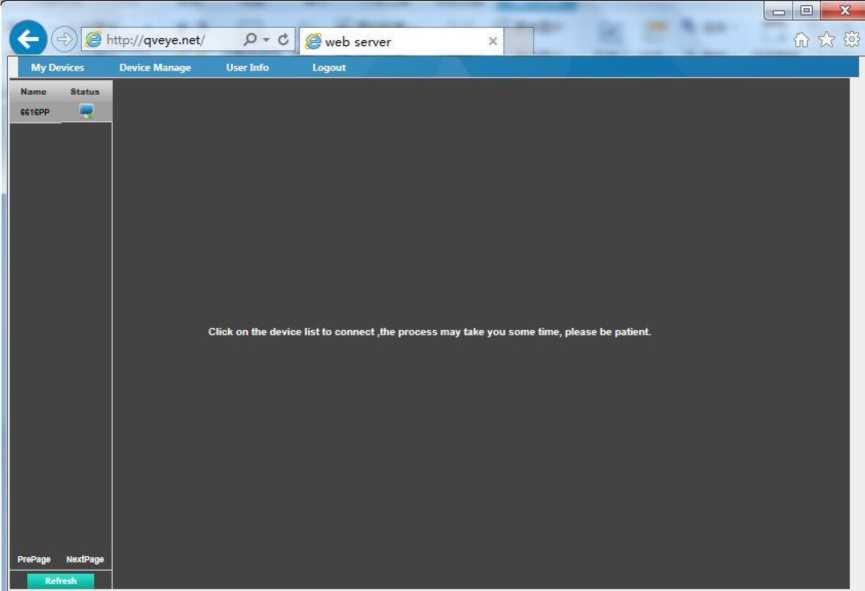
Figure 6-3 Main Interface of P2P after Login
It is empty for the first time when using video surveillance list. Click the Add button and enter the device ID, device name, account number and then select Add channel.
You can modify and delete the devices that have been added.
Figure 6-4 Device Manager of P2P
You can change the password on this page.
Figure 6-5 User Info of P2P
Click the Logout button.
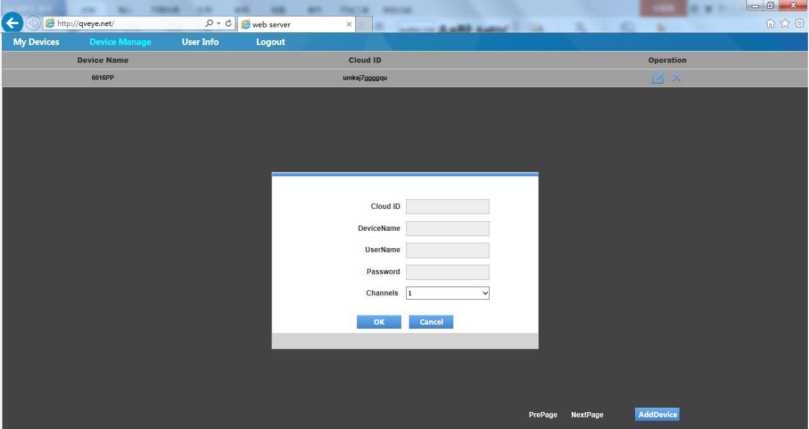
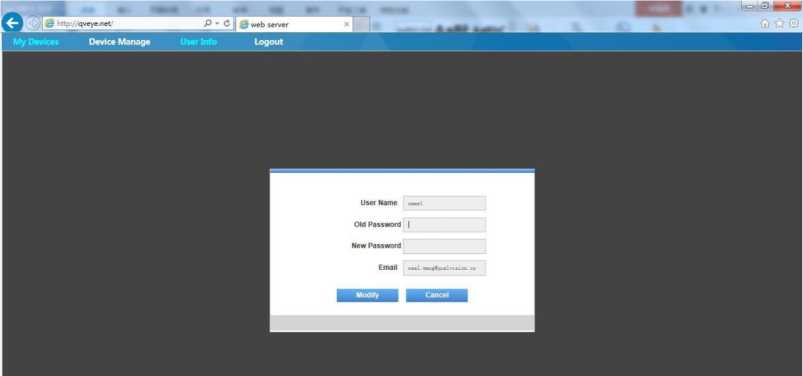
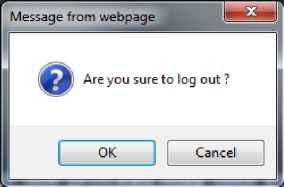

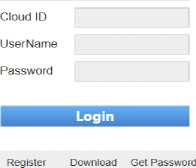
Language: English
Innovative Video Technology
ELEVATE SERES
By User By Device
Log in monitoring system
By cloud ID is another way to achieve P2P connections.
Remote Monitor of Network
Figure 6-7 Login by Cloud ID of HD DVR
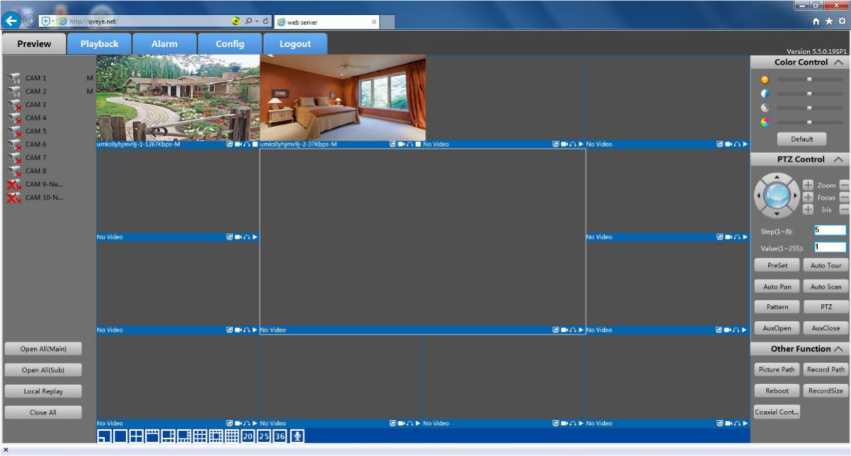
Type device for the cloud ID and account, click Log into the graphical interface.
Figure 6-8 Main Interface After Login by Cloud ID of HD DVR
Note:
> After login by cloud ID successfully, the interface are the same as you login by IP
address and the operations also. Please refer to IP address connection parts.
Thank you for reading, if you have any problem, please contact us, thank you.
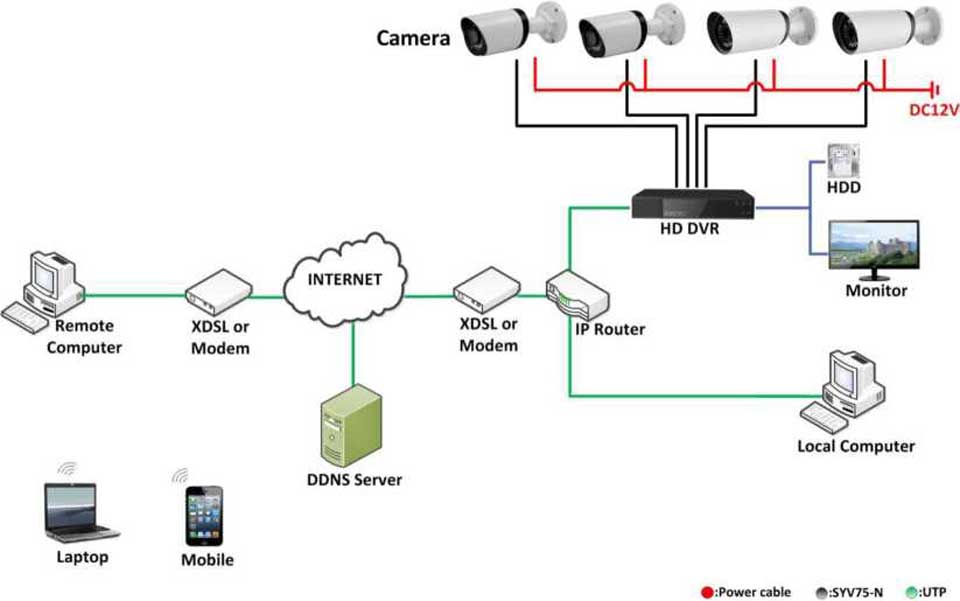

Thanks for excellent information I was looking for this info for my mission.